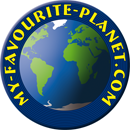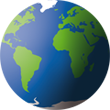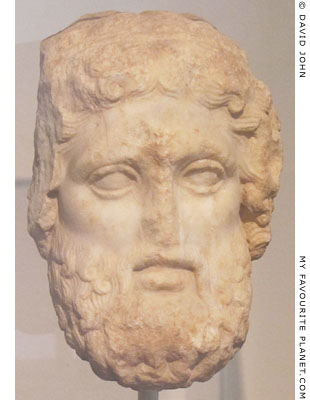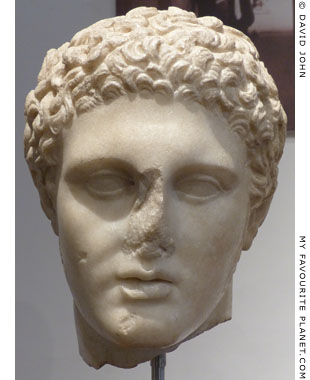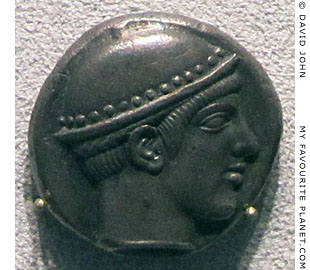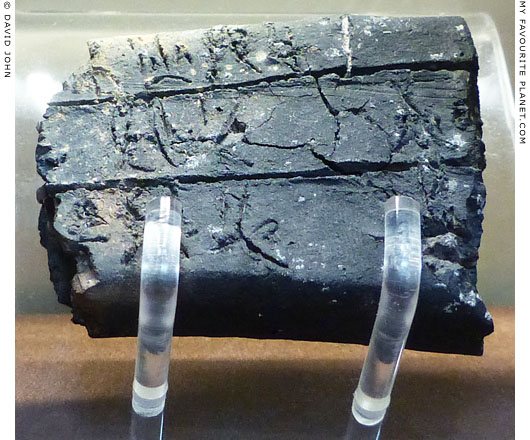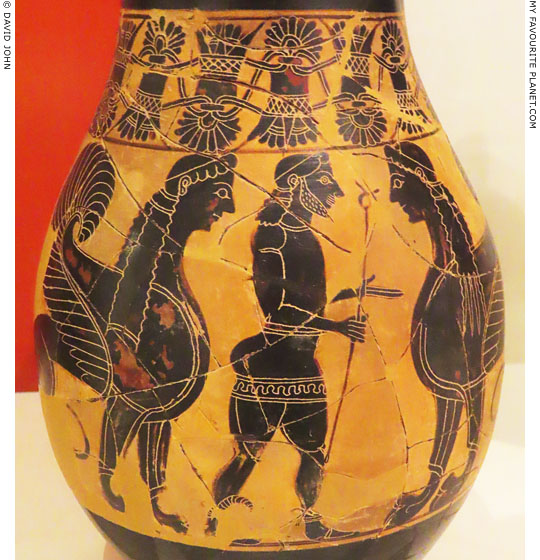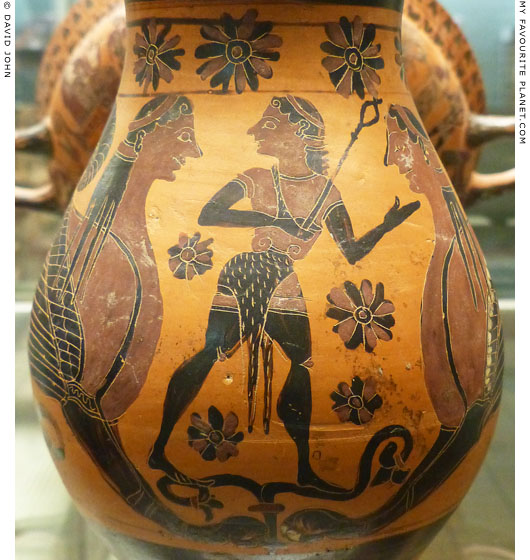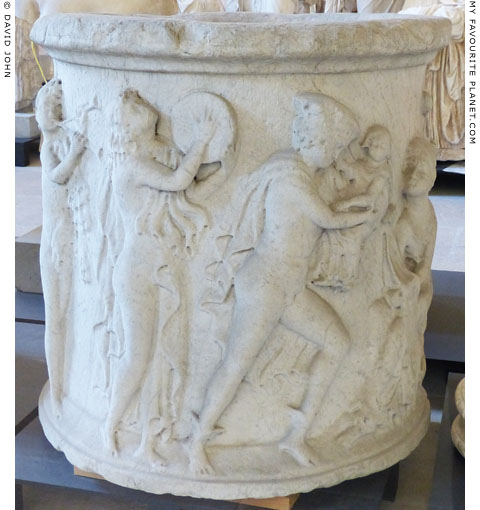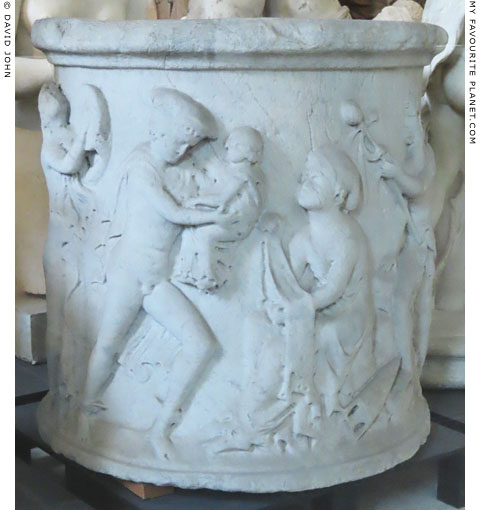| |
| Hermes |
The kerykeion (caduceus) |
|
 |
|
| |
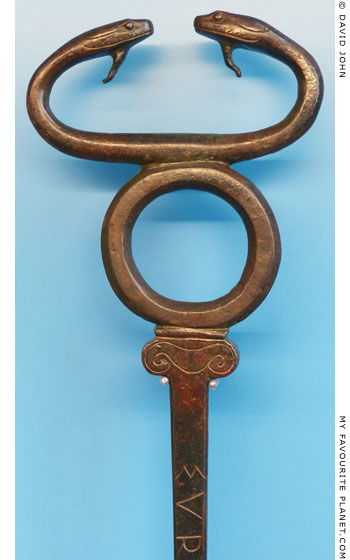 |
|
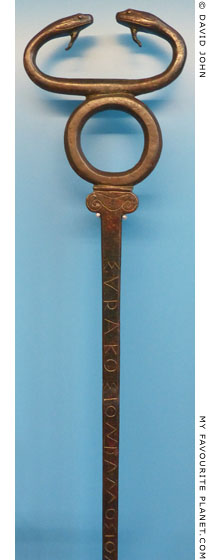 |
A bronze kerykeion (caduceus) from Syracuse, Sicily.
On the shaft is the inscription ΣΥΡΑΚΟΣΙΟΝ ΔΑΜΟΣΙΟΝ.
Around 480-470 BC. Height 51.1 cm, width 8.8 cm, weight 440 grams.
A keryx was a messenger or crier in private or public service with a function
in political, judicial, military and religious contexts. The kerykeion (κηρύκειον;
Latin, caduceus) was the herald's staff carried by kerykes, and often buried
with them as a symbol of their status. They were also dedicated in temples.
At the top of the staff is an inscribed form similar to an Ionic capital or a
stylized ram's head. Above this, the usual entwined snakes (in this case with
"beards") with opposing heads have been stylized to form an open figure eight.
This is one of six full-size ancient kerykeions from
Greece and Italy on display in the Hamburg museum.
Museum für Kunst und Gewerbe Hamburg. Inv. No. 1978.61 / St. 337.
Stiftung für die Hamburger Kunstsammlungen.
Read more about "bearded" snakes in Medusa part 3. |
|
| |
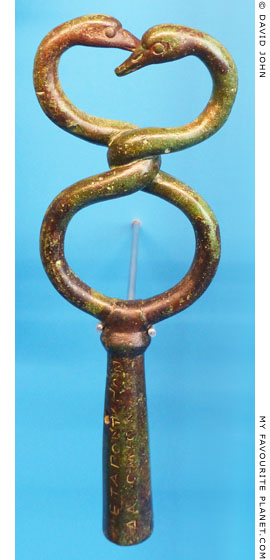
The bronze inscribed head of a
kerykeion with the heads and
entwined necks of two water birds. 4th century BC. From Metapontium
Metapontion (Μεταπόντιον; Latin,
Metapontium), an Achaean colony on
the gulf of Tarentum, southern Italy.
Museum für Kunst und Gewerbe
Hamburg. Inv. No. 200.130.
Purchased with funds of the
Campe'schen Historischen Kunststiftung. |
|

A bronze kerykeion, inscribed in Greek
"I am Longenaian public property",
from Longane, northeastern Sicily.
Made in Sicily, around 450-420 BC.
British Museum.
Inv. No. GR 1875.8-10.3 (Bronze 319). |
|
| |
|
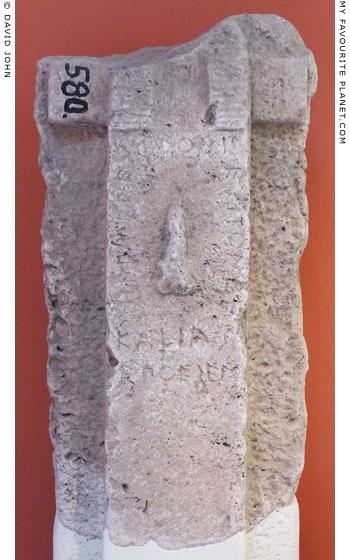
The inscribed steele of a herm, now
headless, made and dedicated by
Kallias to the "Euphronides Nymphae".
Archaic period, around 500-480 BC. From
Trachones, in the Attic deme of Euonymon.
ℎερμε͂ν Εὐ|φρονίδ|εσι τόνδε
Καλ(λ)ίας
ἐπόεσεν.
Inscription IG I³ 1007 (also IG I² 820).
Epigraphical Museum, Athens.
Inv. No. EM 580. |
|
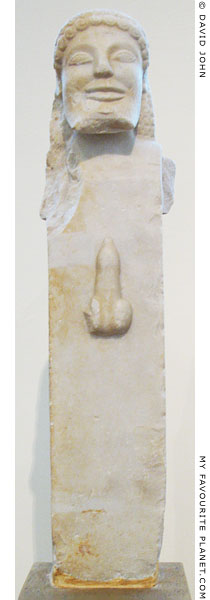
Archaic marble herm from
Siphnos, Greece.
Island marble. About 520 BC.
The herm was found in the kastro of
the main town of Siphnos, and seen
and photographed in 1895 by German
archaeologists Schiff and Curtius. It
was kept in the island's museum,
housed in a school, from where it is
said to have been stolen, and later
returned to Greece from Italy. It
entered the National Archaeological
Museum, Athens, in 1935. Height 66 cm,
width 13 cm, depth 8.8 cm.
National Archaeological Museum,
Athens. Inv. No. 3728. |
|
| |
One modern theory concerning the earliest depictions of Hermes has been accepted by some scholars, but remains a matter of debate. According to this theory, the first herms set up as waymarkers along ancient paths were merely piles of stones, which were later replaced by the posts or shafts topped with a head. Evidence is seen in Homer's Odyssey (Book 16, line 471), where the swineherd Eumaeus (Εὔμαιος) mentions an "Ἕρμαιος λόφος" (Ermaios lofos) above the city of Ithaka. The Medieval scholiast (commentator) of the poem explained this as a stone heap. However, the term has often been translated as "Hermes' Hill" (E. V. Rieu, Penguin Classics) or "Hill of Hermes" (A. T. Murray, Loeb Classical Library) and in older editions as "Hermaean height" or "Hermaean hill".
Ancient authors credited the Athenians with the introduction of the herm with a square-section shaft decorated with male genitals, which was copied at other places in Greek world.
"The Athenians, then, were the first Greeks to make ithyphallic images of Hermes, and they did this because the Pelasgians taught them. The Pelasgians told a certain sacred tale about this, which is set forth in the Samothracian mysteries."
Herodotus, Histories, Book 2, chapter 51, section 4. At Perseus Digital Library.
"At the Arcadian gate leading to Megalopolis is a Herm of Attic style; for the square form of Herm is Athenian, and the rest adopted it thence.".
Pausanias, Description of Greece, Book 4, chapter 33, section 3. At Perseus Digital Library. |
|
| |
 |
|
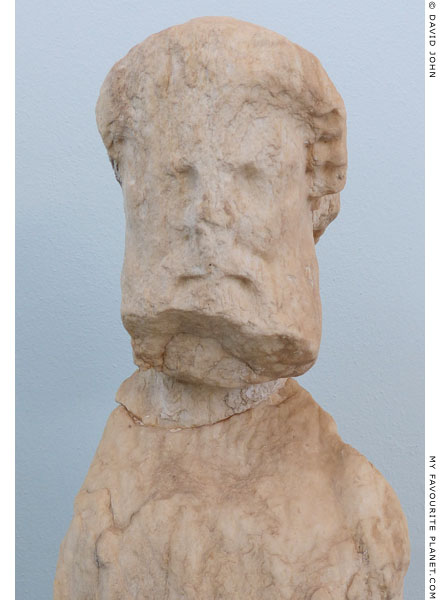 |
Marble herm from the propylon of the Sanctuary of Apollo, Delos.
341/340 BC. A copy of the herm now stands in front of the remains of the propylon,
(or propylaia) the monumental entrance at the south of the sanctuary (see below),
built by the Athenians around 150 BC to replace an earlier gateway.
Delos Archaeological Museum, Greece. Inv. No. A 7756. |
|
| |
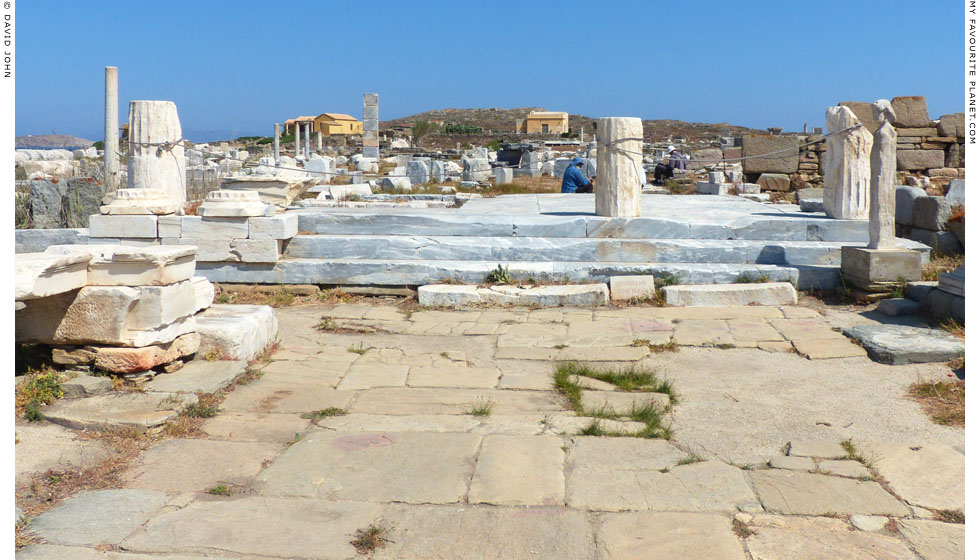
The remains of the propylon (or propylaia) of the Sanctuary of Apollo, Delos.
The monumental entrance at the south of the sanctuary was built by the Athenians around
150 BC to replace an earlier gateway. The modern copy of the herm of Hermes can be see on
the right of the steps up to the entranceway. The original is in the Delos museum (see above). |
| |
 |
|
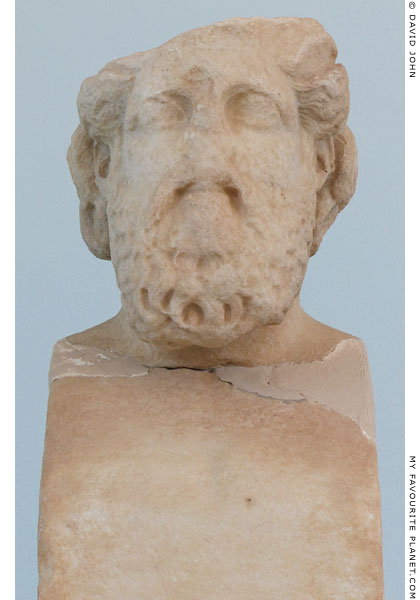 |
Large marble herm from the Prytaneion (πρυτανεῖον), southeast of the
Sanctuary of Apollo, Delos. A copy now stands at the site (see below).
4th century BC.
Delos Archaeological Museum, Greece. Inv. No. A 7759. |
|
| |
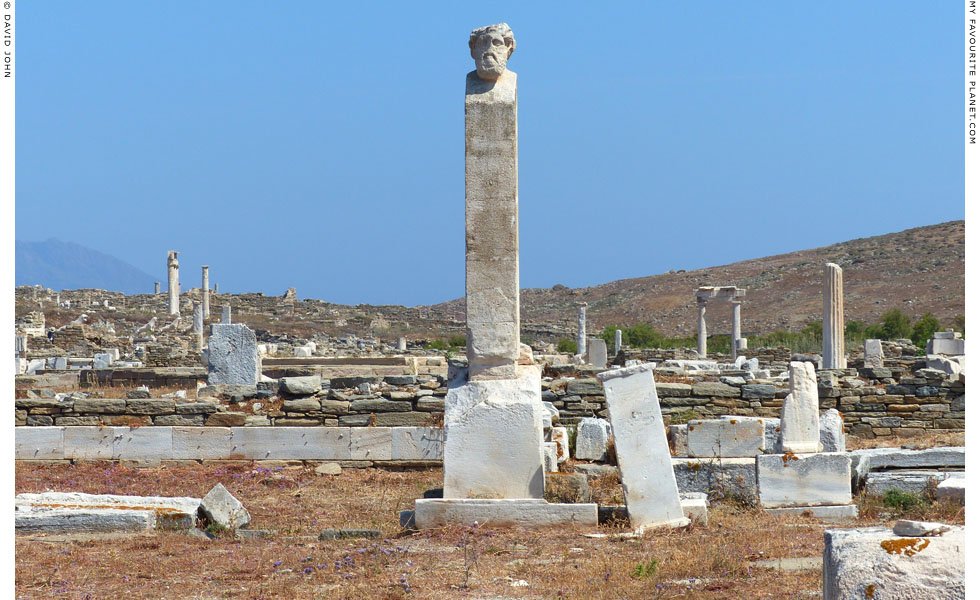
The modern copy of a large herm of Hermes among the remains
of the Prytaneion, southeast of the Sanctuary of Apollo, Delos.
The original herm is in the Delos museum (see above). |
| |

Marble Archaistic head of Hermes from Delos.
Hellenistic period, after a prototype of 430 BC.
Delos Archaeological Museum, Greece.
Inv. No. A 6960. |
|
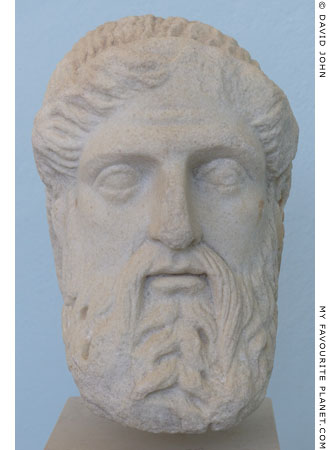
Marble Archaistic head of Hermes,
Hellenistic type.
From the Stoa of Antigonos, Delos.
Delos Archaeological Museum, Greece.
Inv. No. A 5594. |
|
| |
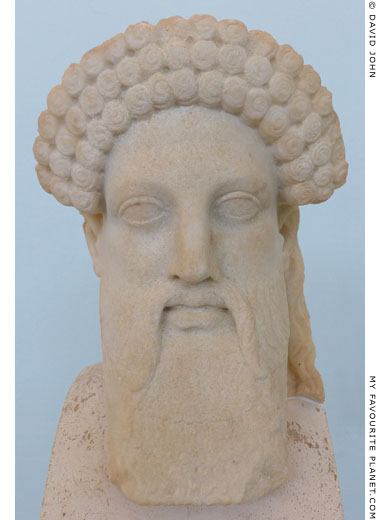
Marble Archaistic head of a herm of Hermes, from the
House of the Herms (or House of Hermes), Delos.
1st century BC, probably derived from a
work by Kallimachos, 5th century BC.
Delos Archaeological Museum, Greece. Inv. No. A 4118. |
| |
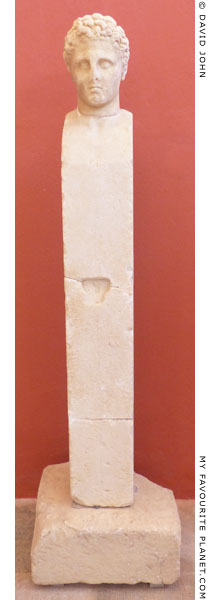 |
|
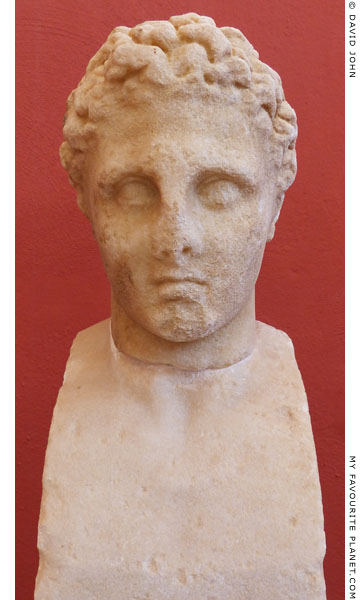 |
Marble herm from the Agora of the Competaliasts, Delos.
Late 2nd - early 1st century BC.
Delos Archaeological Museum, Greece. Inv. No. A 6992. |
|
| |
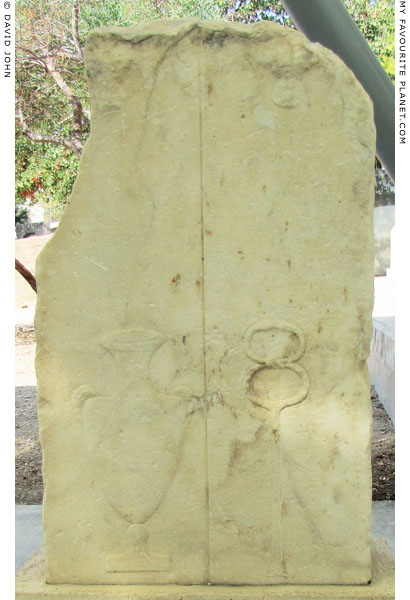
The lower part of a marble double-headed herm, found in 1914 in the area
of the Odeion of Pericles, next to the Theatre of Dionysos, Athens, during
excavations directed by Greek archaeologist Panagiotes G. Kastriotes.
The front is bisected by a vertical incised line, to the left of which is a relief
of a hydria (or stamnos), and to the right a kerykeion. It has been suggested
that the herm may have been a boundary marker between the Sanctuary of
Dionysus Eleuthereos and an unknown sanctuary of Hermes.
Theatre of Dionysos, Athens. Inv. No. NK 2342. |
| |
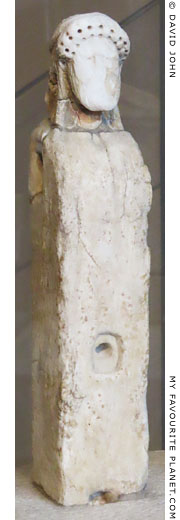
A small marble Archaistic herm
from Thessaloniki.
The head and herm body are made of marble
of different qualities, and the head may be
older, possibly 1st century BC. Found in a
niche in the underground crypt of a Roman
temple (the Serapeion?) in Thessaloniki.
Thessaloniki Archaeological Museum.
Inv. No. 1074. |
|
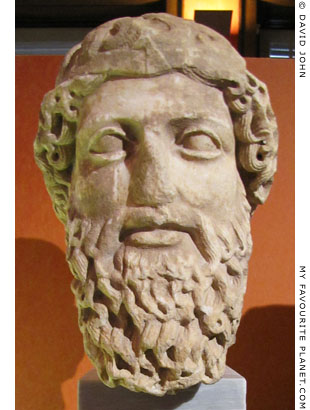
A marble head of a bearded god, thought
to be either Hermes or Zeus. Perhaps from
a herm dedicated by Python from Abdera,
Thrace, and made by Euphron of Paros.
450-440 BC. Pentelic marble. Found in
1886 in a sanctuary of Eetioneia, Piraeus.
National Archaeological Museum,
Athens. Inv. No. 332. |
|
| |
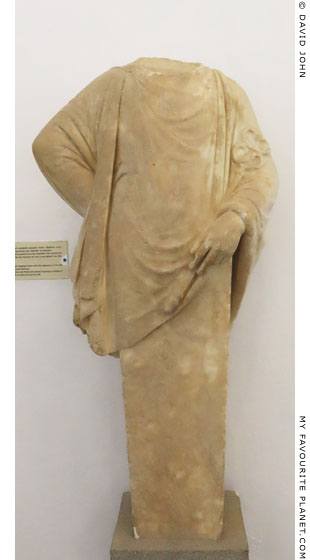
A small marble herm, now headless, wearing
a short cloak, resting his right hand on this
hip and holding a kerykeion in his left arm.
Late Hellenistic period. From the ancient
city of Kamiros, western Rhodes.
Rhodes Archaeological Museum.
Inv. No. E 21. |
|

A marble herm of Hermes, now headless,
from Chalkis, Euboea, central Greece.
The god wears a chlamys (short cloak)
over a short chiton (tunic). As with the
earlier herm stele from Kamiros (photo,
left), he rests one hand on his hip while
in the other he holds a kerykeion.
2nd century AD, Roman Imperial period.
Found in the Bei-Baxe area of Chalkis
(today Chalkida), where it is thought
to have stood in the gymnasium.
Chalkis "Old" Archaeological Museum.
Inv. No. MX 35. |
|
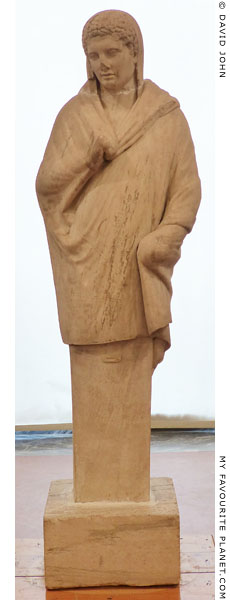
Marble herm of Mercurius
from Herculaneum.
National Archaeological Museum,
Naples. |
|
| |
 |
|
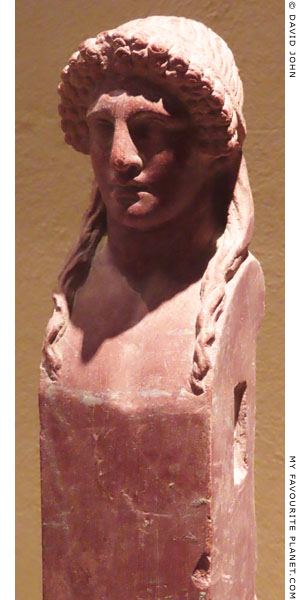 |
A small marble herm with an Archaistic head of beardless Hermes.
Roman Imperial period. Red marble (rosso antico).
Casa Romana archaeological site, Kos. Inv. No. Γ 1186. |
|
| |
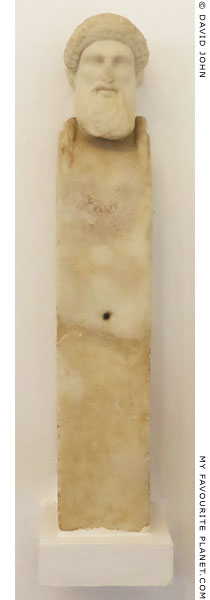
Small Archaistic marble herm from
Rhodes. Late Hellenistic period.
Rhodes Archaeological Museum.
Inv. No. E 387. |
|
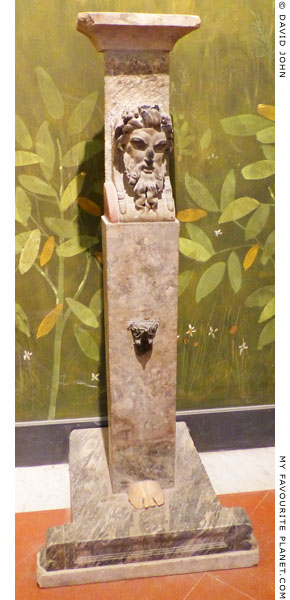
Marble herm from Pompeii. 1st century AD.
Gabinetto segreto (Secret Cabinet),
National Archaeological Museum,
Naples. Inv. No. 27730. |
|
| |
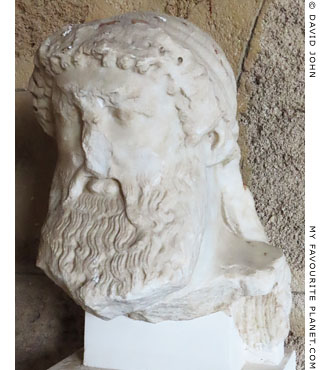
A marble head of a herm of the "Pergamon
type", one of several extant sculptures
thought to be copies of the "Hermes
Propylaios" attributed to Alkamenes.
Late Hellenistic period. From Kamiros, Rhodes.
Rhodes Archaeological Museum.
For further information about herms of this
type, see Pergamon gallery 2, page 15. |
|
|
| |

A red-figure kylix (wine cup) with a painted tondo
depicting an adorant making offerings to a herm.
5th century BC. From Akraiphnio (Ἀκραίφνιον, ancient
Akraiphia, Ἀκραιφία), Boeotia, central Greece.
Thebes Archaeological Museum. |
| |
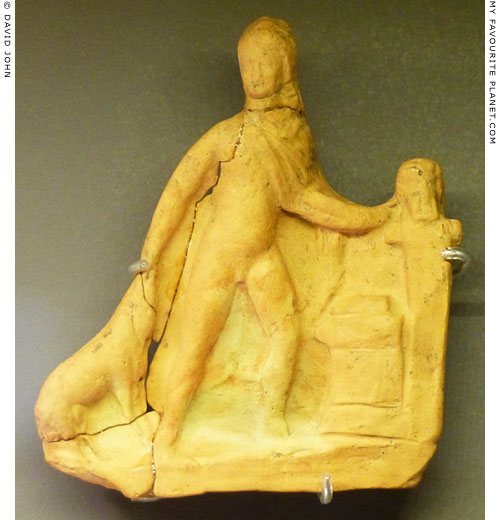
A terracotta plaque depicting a youth sacrificing
a ram at an altar next to a herm.
Around 275-250 BC. Found among grave offerings in Tomb S130 in the
South Necropolis, outside the Sanctuary of the Great Gods, Samothraki.
Samothraki Archaeological Museum. |
| |
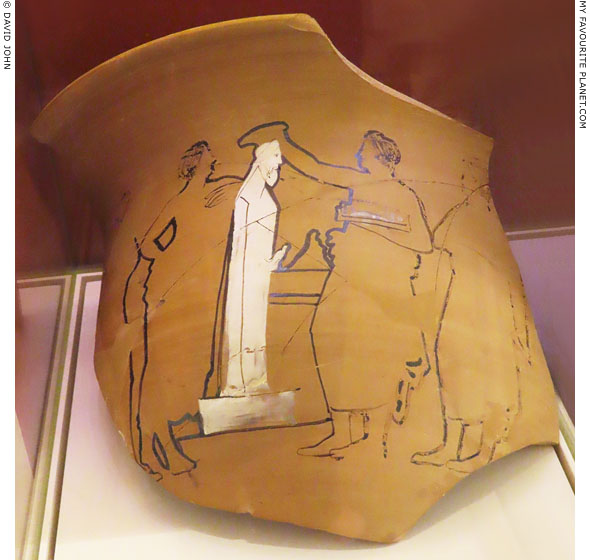
Fragments of a krater on which a painter has made
a test sketch of men standing around a herm.
Late 5th - early 4th century BC, Classical period.
From the Dipylon, Athens.
National Archaeological Museum, Athens.
Vase Collection. Inv. No. 2202. |
| |
| Hermes |
Bearded Hermes |
|
 |
|
| |
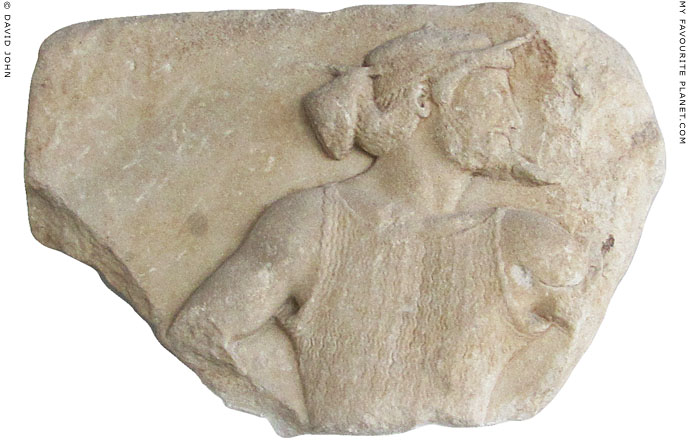
The top left corner of an Archaic marble slab with a low relief depicting Hermes.
Thought to be part of a decorative panel from the peribolos (περίβολος, perimeter
wall) of the Kekropeion (Κεκρόπειον), the tomb of the mythical Athenian king
Kekrops on the Athens Acropolis (see Athens Acropolis gallery page 19).
Around 500 BC. Island marble. Found in 1859 by the south wall of the
Acropolis, near the Propylaia. Height 44 cm, width 64 cm, thickness 28 cm.
Acropolis Museum, Athens. Inv. No. Acr. 1343.
|
The top part of the torso is shown frontally, while the head is in profile, facing right. As is usual in Archaic art, the eye is shown as if the head was facing forwards. Surviving parts of the muscular arms are extended slightly from the body, and his right arm is bent at the elbow. He wears a petasos (πέτασος, broad-brimmed hat), and his long hair is swept behind the back of the head and tied up in a style known as a krobylos (κρώβυλος). He has a moustache and the pointed tip of his beard juts forward on the level of his chin. His exomis (ἐξωμίς, sleeveless tunic) is fastened by a brooch at each shoulder. The texture of the material is shown by fine wavy vertical incisions, with every third incision carved deeper, giving the impression of ribbing.
At the time of the relief's discovery the identification of the figure was a matter of debate, and scholars made several suggestions, including Hermes, Theseus, Hephaistos and a mortal. Secure identification has been made by comparison with other similar Archaic and Archaistic depictions of Hermes. See photos below, particularly here here here and here.
Other relief fragments, including a depiction of a figure mounting a chariot (Acropolis Museum, Inv. No. Acr. 1342, see photo on Athens Acropolis gallery page 19), are thought to be parts of the same frieze. The sculptural style of the fragments has been described as a mixture of Attic and Ionic.
See: Guy Dickens, Catalogue of the Acropolis Museum, Volume I: Archaic sculpture, Nos. 1342 and 1343, pages 275-279. Cambridge University Press, 1912. At the Internet Archive. |
|
| |
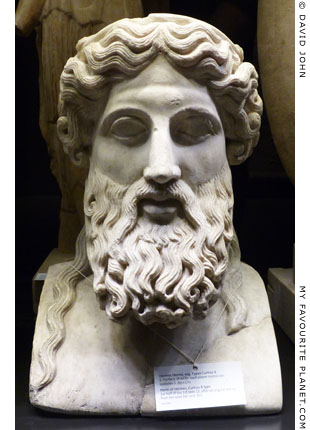
An Archaistic herm of Hermes, Curtius B type.
First half of the 1st century AD, "after an
original dating from the later 5th century BCE".
Height 47 cm, width 31 cm, depth 27 cm.
Skulpturensammlung, Albertinum, Dresden.
Inv. No. Hm 069. |
|
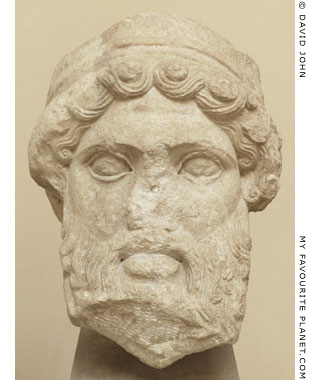
An Archaistic head of a herm of Hermes
from Ostia, near Rome.
2nd century AD. Pentelic marble.
Found in 1910 in the Decumanus,
near the theatre of Ostia.
Ostia Archaeological Museum. Inv. No. 88.
Described in the official guidebook as
"a copy of Hermes Propylaios by Alcamene".
One of many herms claimed to be copies of
an original attributed to Alkamenes, based
on a mention of a depiction of Hermes at
the Propylaea of the Athens Acropolis.
See Pergamon gallery 2, page 15. |
|
| |
| Hermes |
Hermes Kriophoros
Hermes ram-bearer |
|
 |
|
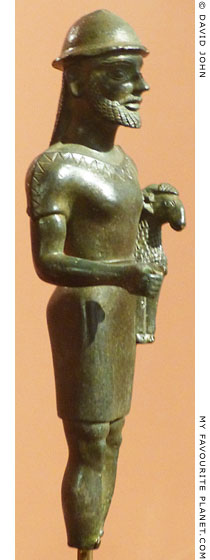
Bronze statuette of Hermes
Kriophoros (ram-bearer)
wearing a pilos (conical hat)
carrying a ram under his left
arm. This figure and that in
the photo right probably held
a kerykeion in the right hand.
Provenance uncertain,
perhaps from the same
Arcadian sanctuary as
the bronze figurine, right.
Work of a Peloponnesian
workshop, 550-525 BC.
National Archaeological
Museum, Athens.
Helen and Antonios Stathatos
Collection. Inv. No. St. 328. |
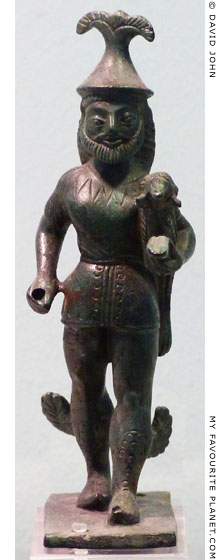
Bronze figurine of Hermes
Kriophoros carrying a ram
under his left arm. He wears
a conical hat (ϰυνέη) topped
with feathers, a short chiton
(tunic) and winged boots.
Circa 550 BC. From a sanctuary
dedicated to Pan, Hermes and
another god (perhaps Apollo),
between the villages Agios Sostis
(Άγιος Σώστης) and Berekla (today
Neda, Νέδα), on the south slopes
of Mount Lykaion (Λύκαιον ὄρος),
southwestern Arcadia, Peloponnese,
Greece (see Pan). Confiscated in
the area of nearby Andritsaina.
National Archaeological Museum,
Athens. Inv. No. 12347. |
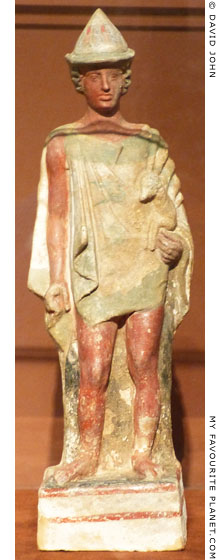
"Youth holding a ram" wearing
a pilos and short cloak.
Perhaps Hermes Kriophoros.
Painted, mould-made
terracotta statuette made
in a Boeotian workshop,
around 450 BC. [3]
National Archaeological
Museum, Athens.
Helen and Antonios
Stathatos Collection. |
|
| |
In the Archaic bronze statuettes of Hermes from the Peloponnese, he is shown wearing a conical hat similar to the pilos (πῖλος) worn by Odysseus and the twin Spartan heroes the Dioskouroi. Both figures show a bearded figure wearing a chiton (χιτών, tunic) with a zig-zag pattern around the collar and a thin belt around the waist. He carries a ram with his left arm, and originally held a kerykeion (caduceus) in his right hand. The Andritsaina figurine (centre) has an elaborate floral crest on top of the hat, high sandals with attached wings and decorated shin pieces.
Although representations of Hermes Kriophoros (Κριοφόρος, ram-bearer) have been interpreted as being associated with the solemn sacrifice of a ram, Pausanias related a local myth from the Boeotian city of Tanagra, in which the god was credited with saving the city from plague by walking around the city walls carrying a ram on his shoulders. He also mentioned a statue of Hermes Kriophoros made for the city by the 5th century BC sculptor Kalamis, which was later depicted on Roman period coins of the city.
"There are sanctuaries of Hermes Ram-bearer [Kriophoros] and of Hermes called Champion [Promachos]. They account for the former surname by a story that Hermes averted a pestilence from the city by carrying a ram round the walls. To commemorate this Calamis made an image of Hermes carrying a ram upon his shoulders. Whichever of the youths is judged to be the most handsome goes round the walls at the feast of Hermes, carrying a lamb on his shoulders.
Hermes Champion is said, on the occasion when an Eretrian fleet put into Tanagra from Euboea, to have led out the youths to the battle; he himself, armed with a scraper like a youth, was chiefly responsible for the rout of the Euboeans. In the sanctuary of the Champion is kept all that is left of the wild strawberry tree under which they believe that Hermes was nourished. Nearby is a theatre and by it a portico. I consider that the people of Tanagra have better arrangements for the worship of the gods than any other Greeks. For their houses are in one place, while the sanctuaries are apart beyond the houses in a clear space where no men live."
Pausanias, Description of Greece, Book 9, chapter 22, section 1. At Perseus Digital Library.
Pausanias also described a statue of Hermes Kriophoros at the sanctuary of Zeus in Olympia, made by the sculptor Onatas (around 480-450 BC) and dedicated by the people of Pheneos (Φενεός), Arcadia, at the foot of Mount Kyllene, the mythical birthplace of Hermes (see below):
"The Hermes carrying the ram under his arm, with a helmet on his head, and clad in tunic and cloak [chlamys], is not one of the offerings of Phormis, but has been given to the god by the Arcadians of Pheneus. The inscription says that the artist was Onatas of Aegina helped by Calliteles, who I think was a pupil or son of Onatas. Not far from the offering of the Pheneatians is another image, Hermes with a herald's wand. An inscription on it says that Glaucias, a Rhegian by descent, dedicated it, and Kallon of Elis made it (ποιῆσαι δὲ Κάλλωνα Ἠλεῖον)."
Pausanias, Description of Greece, Book 5, chapter 27, section 8. At Perseus Digital Library.
He also recorded a statue of Hermes Kriophoros ("Ἑρμῆς φέρων κριόν", "Hermes carrying a ram") in a sacred cypress grove at Oichalia (Οἰχαλία) in Messenia, southwestern Peloponnese.
Pausanias, Description of Greece, Book 4, chapter 33, section 4. At Perseus Digital Library.
Among Hermes' many epiphets, at Koroneia (Κορώνεια) in Boeotia he was worshipped as Hermes Epimelios (Ἑρμες Ἐπιμηλίος), the Keeper or Guardian of Flocks.
"On the marketplace of Coroneia I found two remarkable things, an altar of Hermes Epimelius and an altar of the winds."
Pausanias, Description of Greece, Book 9, chapter 34, section 3. At Perseus Digital Library.
Unfortunately, Pausanias did not tell us more about this name, or what he found remarkable about the altars in the agora. |
|
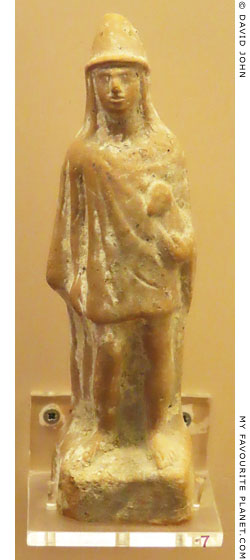
A terracotta figurine of a young
male wearing a pilos and short
cloak carrying a small animal in
his left arm. Described by the
museum labelling as "a youth
holding a dog", although the
type of animal is far from clear.
From an inhumation burial of an
infant, Macri Langoni T 66 (123).
425-400 BC. Found during
excavations in the cemetery at
Macri Langoni, near ancient
Kamiros, western Rhodes.
Rhodes Archaeological Museum. |
|
| |
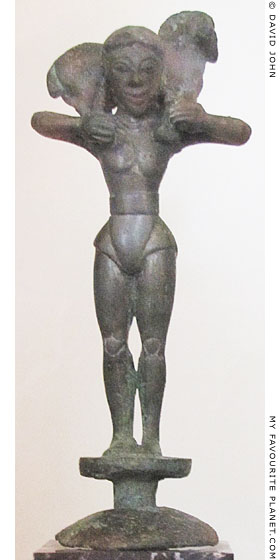
Archaic bronze statuette of a youth,
with Daedalic features (head) and
Cretan clothing, carrying a ram on
his shoulders.
Around 620 BC. From Crete.
Height 18.1 cm.
Altes Museum, Berlin.
Inv. No. Misc. 7477.
Purchased 1880 in Athens.
Several small Archaic sculptures of male
figures carrying sheep or goats have
been found at various locations around
the eastern Mediterranean. Particularly
common are "Cypro-Ionian" stone
statuettes dating from the 6th century
BC. Many depict a young beardless
male carrying a ram or (more commonly)
goat on his shoulders and holding its
legs with each hand. Such figures may
depict a worshipper (votary) bringing
a sacrifice rather than a god. [4] |
|

"The Ram-Carrier of Thasos", an
unfinished 3.5 metre tall kouros
statue made from a single piece
of marble, circa 600 BC.
Found built into a wall at the site
of the Sanctuary of Apollo on the
acropolis of Thasos, Macedonia,
Greece. As in the case of most Archaic
kouros statues, it is not known who
the colossal faceless figure represents.
Apollo has been suggested.
Thasos Archaeological Museum. |
|
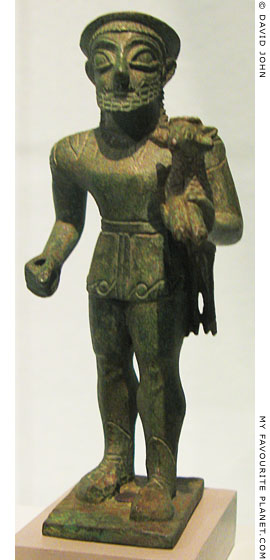
Bronze votive statuette of a bearded
man, wearing a hat, chiton and boots,
carrying a ram in his left hand. Probably
Hermes Kriophoros. The figure held a
kerykeion (caduceus) or shepherd's
staff in the right hand.
550-530 BC. From the same sanctuary
at Agios Sostis, Mount Lykaion, Arcadia
as the bronze figurine above (Athens,
Inv. No. 12347). Height 9.8 cm.
State Museums Berlin (SMB).
Inv. No. Misc. 10781.
Purchased on the art market 1906. |
|
| |
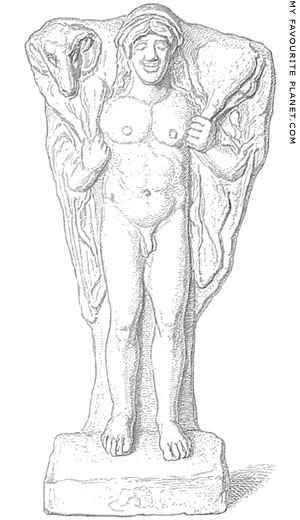
A terracotta plaque or tile in the form of
Hermes Kriophoros standing on a plinth.
Around 480 BC. From the necropolis of
Gela, Sicily. Height 19.1 cm, width 10 cm,
depth 6.2 mm, weight 400 grams.
The beardless figure, his hair parted and
waved, is naked apart from a fillet (head-
band), perhaps a cap, and a cloak hanging
from his arms. He appears to be stepping
forward, his left leg advanced and slightly
bent at the knee. He carries the ram over
his shoulders, holding its forelegs in his
right hand and hind legs in the left. The
ram's face is turned to the front. There
are are traces of red colour on his skin,
and blue on the ram's horns. The back of
the object is flat. The fact that the figure
stands on a plinth suggests that it may
be a depiction of a statue.
British Museum. Inv. No. 1863,0728.276
(Terracotta 1132, also Terracotta B410).
Excavated or purchased in Terranuova (Gela)
in 1863 by George Dennis, British explorer,
excavator, collector and diplomat (1814-1898),
who donated it to the museum soon after (see
the note about Denis in Homer part 3).
Source: Reinhard Kekule von Stradonitz,
Die antiken Terracotten, Band II, Die
Terracotten von Sicilien, Tafel III, No. 3.
W. Spemann, Berlin & Stuttgart, 1884.
At Heidelberg University Digital Library. |
|
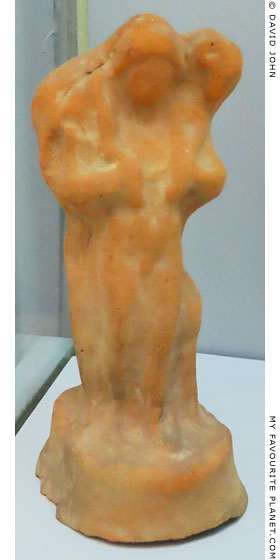
Terracotta figurine of Hermes Kriophoros
carrying a ram on his shoulders from
Chalkis, Euboea, central Greece. The
features of the figure and other details
have been worn smooth by time.
5th century BC, Classical period.
Chalkis "Old" Archaeological Museum. |
|
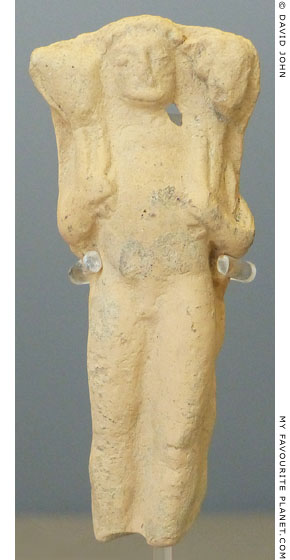
A ceramic figurine of Hermes Kriophoros
carrying a ram on his shoulders.
From the site of the Doric temple
of Athena at Prasidaki (Πρασιδάκι),
Elis, western Peloponnese.
Pyrgos Archaeological Museum. |
|
| |
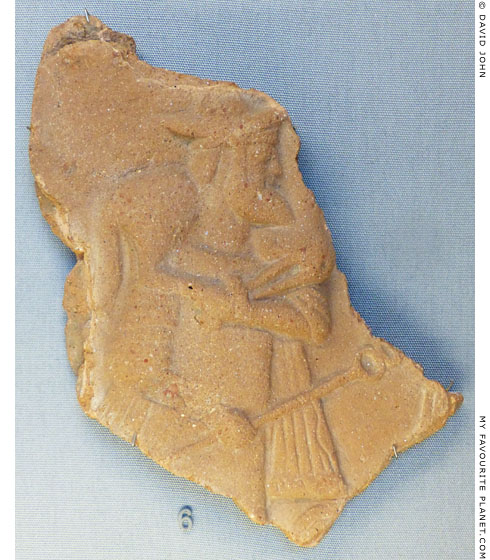
Fragment of a terracotta plaque showing a bearded Hermes carrying a ram
on his shoulders. He wears a petasos (πέτασος, broad-brimmed hat), holds
his kerykeion in his right hand, and a cloak hangs from his left arm.
Made in Medma, southern Italy, around 450 BC.
British Museum. GR 1865.7-12.29 (Terracotta 1224). |
| |
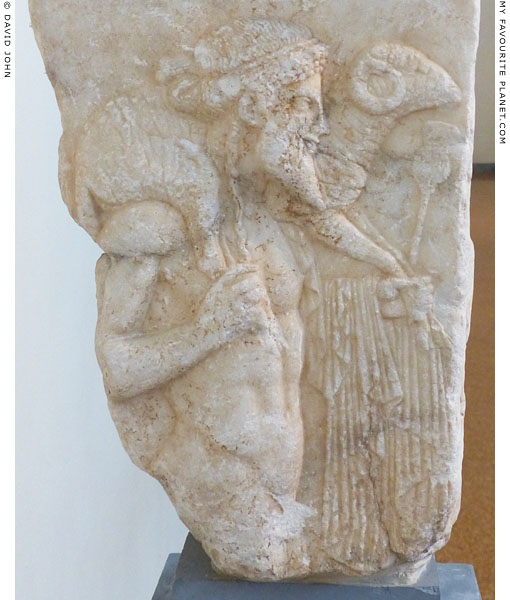
Detail of the front of a fragmentary altar with a relief of Hermes Kriophoros
carrying a ram on his shoulders. With his right hand he holds the ram's rear
legs, and with his smaller left hand the forelegs and a kerykeion (caduceus).
A Chamlys (cloak) with many delicate folds hangs over his left forearm.
1st century BC, inspired by a 5th century BC Archaistic prototype. Found in 1867,
built into a wall over the front door of a house near the Tower of The Winds,
Athens. Pentelic Marble. Present height 45 cm, width 26 cm, depth 24 cm.
National Archaeological Museum, Athens. Inv. No. 54.
|
Although the relief is badly damaged, the quality of the sculpting can still be appreciated in fine details such as the god's hair, face and torso, as well as the folds of the garment. The long hair at the back of the head is folded up and held in place by a headband. A side lock falls from behind the ear to the chest, and above the forehead are three rows of snailshell curls.
The naked, bearded Hermes holds the ram's back legs in his right arm and the front legs in the smaller left hand. Both face in the same direction, to the right, and appear quite relaxed. The god is not necessarily depicted here as very much older than on the statue below, although such bearded figures in ancient art are often referred to as "mature". Originally the altar had reliefs on three sides, and the surviving part of a relief of a female figure on the right side is thought to depict Aphrodite. |
|
| |

Fragmentary Archaistic statue of a bearded Hermes Kriophoros.
Thick side locks fall from behind each ear to the chest, and
around the forehead are two rows of snailshell curls.
1st century AD, Roman period. The first of three fragments was
found on 16th May 1904 in the Forum of Ancient Corinth, during
excavations by the American School of Classical Studies at Athens.
The head was found later. Height 40 cm, width 39 cm, depth 19 cm.
Corinth Archaeological Museum. Inv. No. S-686.
This damaged statue has been compared to the more complete
marble Hermes Kriophoros at Wilton House, Wiltshire, England,
which is said to have come from Thrace. [5]
|
Pausanias mentioned a bronze Hermes standing in the open among statues of other deities (Poseidon, Apollo, Aphrodite, Zeus and Athena) in the Forum of Corinth, and a temple built for another bronze statue of Hermes:
"There are two bronze, standing images of Hermes, for one of which a temple has been made."
Pausanias, Description of Greece, Book 2, chapter 2, section 8. At Perseus Digital Library. |
|
| |
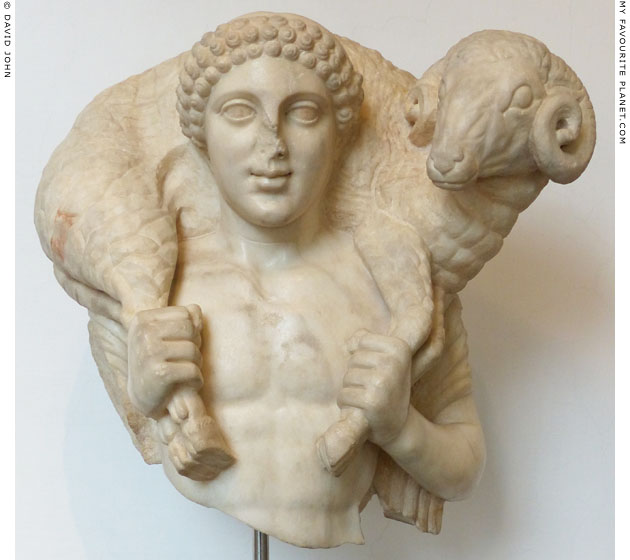
Fragmentary statue of a beardless, youthful Hermes Kriophoros (ram bearer).
Roman period, 1st century BC copy of a Classicistic original.
Found near Rome. Pentelic Marble. Height 54 cm.
Barracco Museum, Rome. Inv. No. MB 83.
|
| The naked, athletic youth appears quite radiant, and the ram too is charming. The young god has three rows of snailshell curls around his forehead, but apart from this Archaic reference the treatment of the two figures reflects the realism of the Classical period. You can almost feel the weight of the ram. |
|
| |
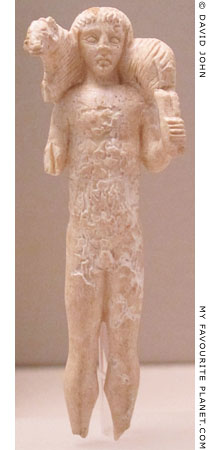
Ceramic figurine of beardless
young Hermes carrying a ram.
Amphipolis Archaeological
Museum. |
|
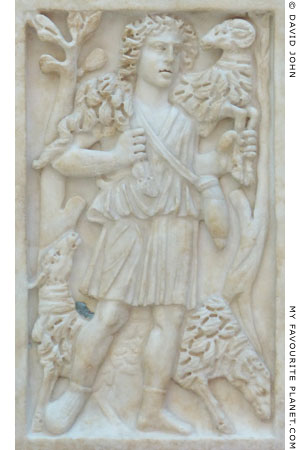
Relief of Cryophorus Pastor
on the panel of a sarcophagus.
Parian marble. 250-300 AD.
From Porta Salaria, Rome.
The young shepherd wears a short tunic,
high shoes and a shoulder bag, and carries
a ram on his shoulders. The iconograpy of
the cryophorus, known since the 7th century
BC, became associated with happiness,
kindness and philanthropy, and was adopted
as a Christian symbol of salvation through
Christ as the "good shepherd".
Centrale Montemartini,
Capitoline Museums, Rome.
This figure is similar to a marble statuette
of "The Good Shepherd" in the Museo
Pio Christiano, Vatican Museums, Rome.
Inv. No. 28590. |
|
| |
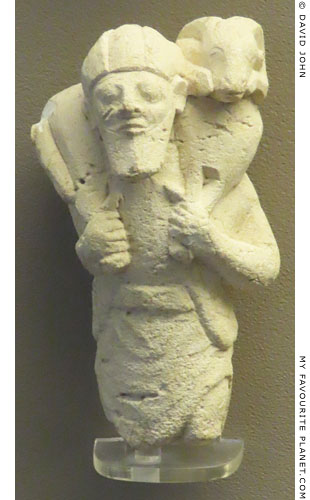
A white limestone statuette of a bearded
male worshipper carrying a sacrificial ram
on his shoulders.
Around 650-600 BC. One of a number of
Archaic limestone figurines of worshippers
and sacrificial animals made in Cyprus,
found in a votive deposit in the sanctuary
of Athena Kamiras, on the acropolis of
ancient Kamiros, western Rhodes.
Rhodes Archaeological Museum. |
|
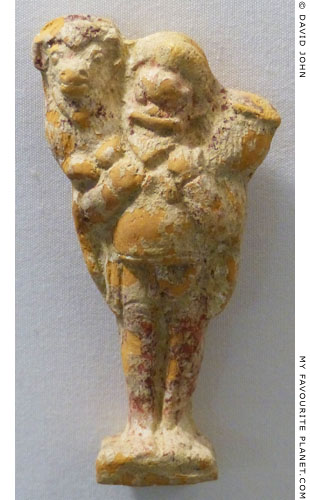
A ceramic figurine of an actor wearing a
mask, identified by the museum labelling
as Papposilenos (see Dionysus), carrying
a ram on his shoulders.
Found in Grave 4 of the necropolis
of Amphipolis, Macedonia.
Amphipolis Archaeological Museum. |
|
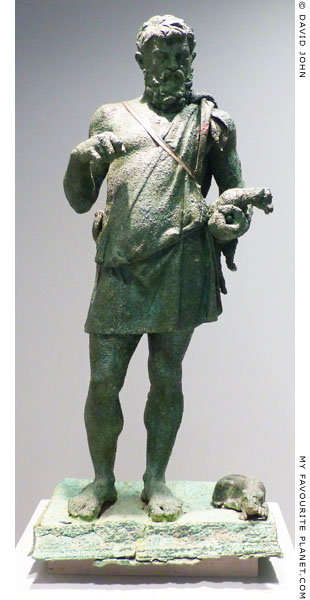
A bronze statuette of a mature, bearded
shepherd, wearing a short chiton (tunic),
fastened at his left shoulder only, holding
a lamb on his left forearm. A small dog
lies next to his left foot.
Roman period, 1st century BC, influenced
by a 3rd century BC Hellenistic work.
Part of the "Ambelokipoi Hoard" of
Roman period statuettes discovered in
the Ambelokipoi district of Athens in 1964.
National Archaeological Museum,
Athens. Inv. No. 16789. |
|
| |
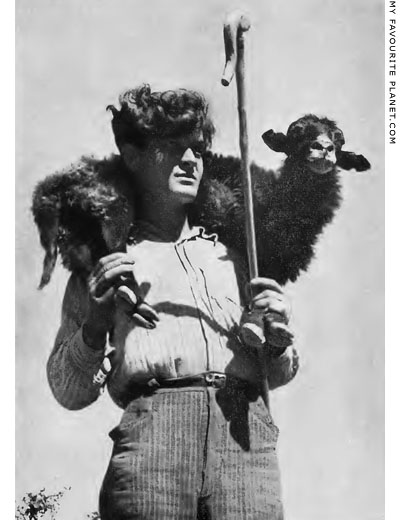
A young Greek shepherd from the area of Delphi
carrying a ewe on his shoulders. Mid 20th century.
Source: Pericles Collas, A concise guide of Delphi, illustrated
with photos by Dimitrios Harissiadis. C. Cacoulides, Athens.
Publishing date unknown. At the Internet Archive. |
| |
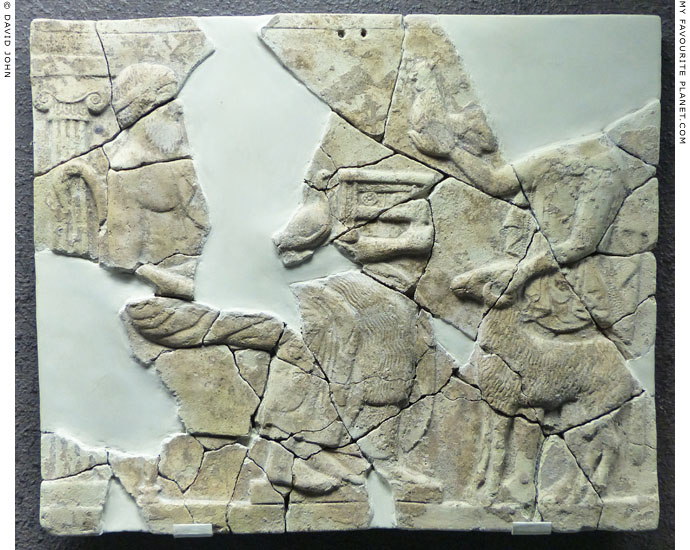
A fragmentary terracotta pinax (plaque) with a relief of Hades and Persephone
enthroned, facing right. They are approached from the right by a male figure
believed to be Hermes Kriophoros, holding a ram by one of its horns with his left
hand, and offering them a cockerel he carries in the palm of his raised right hand.
Around 470-460 BC. From Francavilla di Sicilia, Sicily.
Paolo Orsi Regional Archaeological Museum, Syracuse. Inv. No. 85638. |
| |

Marble relief of young, beardless Hermes with a ram, on a pedestal on the south side
of the "Clivus Sacer" (Sacred Way), Ephesus. Roman period, 1st - 4th century AD.
Ephesus archaeological site, Turkey.
|
Two matching marble pedestals (bases for statues or pillars, or altars?) stand on either side of the bottom of the "Clivus Sacer" (Sacred Way) in Ephesus, below the northwestern corner of the Upper "State" Agora. The west sides of the pedestals, facing downhill to the lower city, are each decorated with a similar relief of Hermes leading an animal.
The relief on the south side of the street (on the right as you come up the street, see Ephesus gallery page 12) shows Hermes with a ram (photo above).
The messenger god is depicted as a naked, athletic youth with winged sandals, walking to the left. In his left hand he holds a winged kerykeion (caduceus), around which two snakes are entwined. Above the staff, the serpents are knotted together, and their mouths meet, so that the tops of their bodies form the wand's signature figure eight, which was often stylized to abstraction.
With his right hand he holds onto the head of the reluctant-looking ram walking behind him. He steps forwards on the toes of his right foot, while his lower left leg is raised behind him, revealing the ram's rather obvious testicles. To his left is an altar, hung with a wreath and with a phiale (libation bowl) on top, indicating that the image is concerned with a sacrifice, perhaps to Apollo.
Only the bottom half of the relief on the north side (photo right) has survived. Hermes walks to the right and holds the head of a male goat with his left hand. It is almost a mirror image of the other relief, so that the depictions of Hermes face each other and the roadway.
Such Roman period images of Hermes leading an animal to be sacrificed (see also the statue from Troezen and the relief from Odessos, Bulgaria below), bring into question interpretations of the earlier Kriophoros images of the god as the "good shepherd", saving or caring for his flock, a notion developed by Christian tradition. It seems that the god was merely bringing the ram to the slaughter.
The adjacent side of each pedestal, facing the roadway, has a relief of a Delphic tripod with an omphalos and a plaque containing an image of the Mistress of Animals (Potnia Theron), a deity associated with Artemis.
The workmanship of the reliefs is quite poor, although a lot of work has been put into the details, such as the fleece of the ram.
The reliefs may refer to the healing god Asklepios, Apollo's son, and have been associated with an Asklepion or healing centre thought to have been located nearby. Alternatively, they may have been connected with the adjacent Prytaneion, or the Upper Agora.
The pedestals have been dated to somewhere between the 1st and 4th centuries AD (according to one source circa 3rd century AD), which is rather vague, and little seems to have been published about them. On one hand it is wonderful to see them on the street of Ephesus, but strange that they have been left here and not sheltered in the museum. |
|
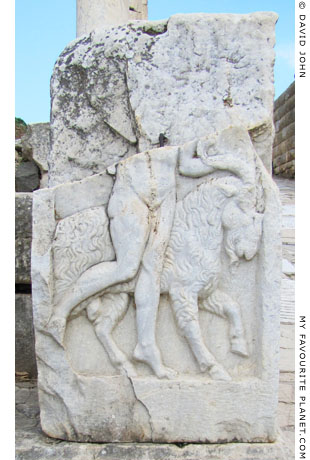
The relief of Hermes with a male goat on
the north pedestal on the Clivus Sacer. |
|
| |
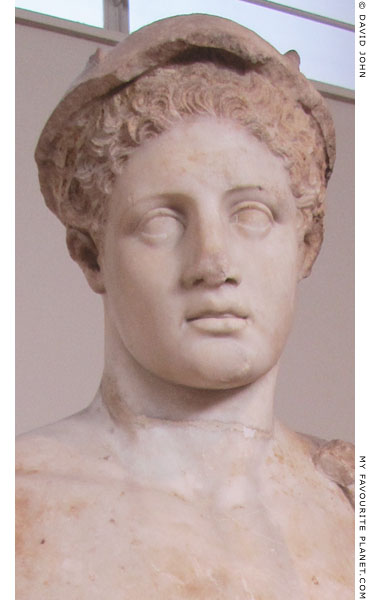 |
|
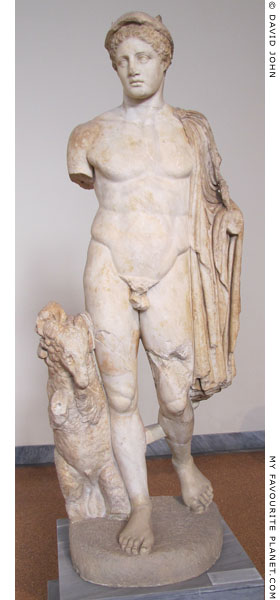 |
Marble statue of a youthful Hermes with a ram. Hermes is shown naked
except for a chlamys cloak and petasos. Most of the right arm is missing,
but the surviving part of the hand holds onto the horns of the ram.
Pentelic marble. 2nd century AD copy of a late 5th century BC original attributed
to Naukydes of Argos. Found in 1890 by archaeologists of the French School
in Athens at ancient Troezen in the northeastern Peloponnese. Height 180 cm.
National Archaeological Museum, Athens. Inv. No. 243. |
|
| |
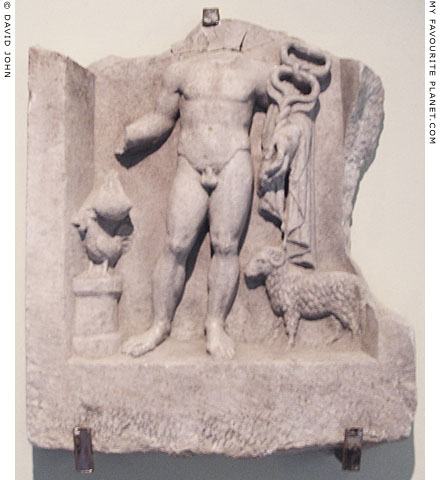
Small marble votive relief of youthful Hermes/Mercury.
Roman period, 2nd - 3rd century AD. From Odessos
(Οδησσός; today Varna, Bulgaria), a Thracian settlement
colonized by Miletus in the late 7th century BC.
Hermes stands naked, holding in his disproportionately large
left hand his caduceus, which rests on a cloak draped over the
arm. In his right hand he holds a purse, below which a cockerel
stands on a small altar. On the right stands a ram.
Varna Archaeological Museum, Bulgaria. |
| |
| Hermes |
Youthful, beardless Hermes |
|
 |
|
| |
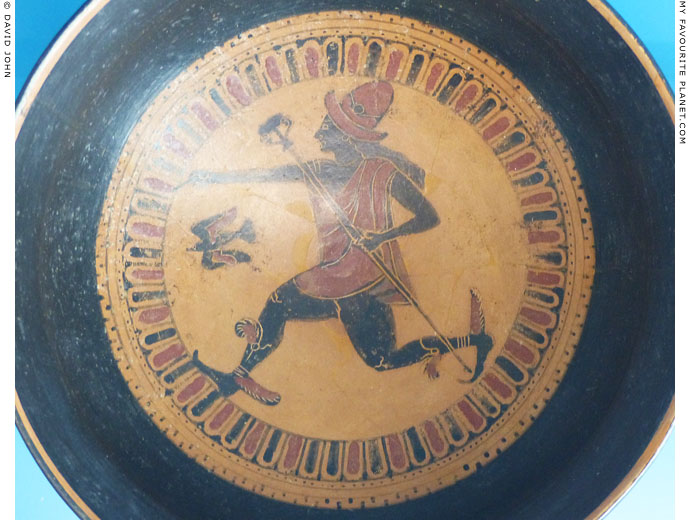
The tondo of an Etruscan black-figure ("Pontic") little master cup showing
a youthful, beardless Turms, the Etruscan equivalent of Hermes, running
or flying, wearing a tall hat, cloak and winged boots, and carrying a kerykeion.
Around 530-520 BC. A work of the "Pontic" Group (6th - 5th centuries BC), named
according to the mistaken theory that the early black-figure works found in Etruria
were made by craftsmen from the Black Sea (Pontus). The later theory that they were
made by Ionian Greeks, perhaps immigrants to Italy, is now also questioned; they may
have been created by native Etruscans themselves, influenced by various Greek styles.
Museum für Kunst und Gewerbe Hamburg. Inv. No. 1969.16.
Purchased with funds from the Campe'schen Historischen Kunststiftung.
In a recent book, Sheramy D. Bundrick has challenged the generally held assumption
that Etruscan art and culture were hellenized by the import of Greek pottery and artworks,
arguing that the exported Greek art may have been "etruscanized" in an attempt to meet
the particular requirements of customers. See:
Sheramy D. Bundrick, Athens, Etruria, and the many lives of Greek figured pottery.
University of Wisconsin Press, 2019.
See another 6th century BC Etruscan ceramic painting of Hermes below. |
| |

The tondo of an Attic red-figure kylix (drinking cup, type B) with a depiction of a youthful,
beardless Hermes, standing facing the front, with his head turned to the left. His petasos
hangs behind his head, and he wears a chlamys (cloak), fastened on the right shoulder,
over a short girdled chiton. He is barefoot. In his left hand he holds a kerykeion, and in
his right hand a phiale from which he pours an offering of wine onto the ground.
Around 465-455 BC. Restored from fragments. Attributed to the Sabouroff Painter
(active around 470-430 BC) by Sir John Beazley. From Vulci, Etruria, Italy.
Diameter of tondo, including maeander border, 14.2 cm.
Rijksmuseum van Oudheden, Leiden, Netherlands. Inv. No. PC 77.
From the Canino collection, No. 1578. Acquired from Lucien Bonaparte in 1839.
See: Beazley Archive Database, Vase No. 212211 |
| |

A bronze statuette of youthful Turms,
the Etruscan equivalent of Hermes,
wearing a petasos and pointed
winged boots.
5th century BC. Ploughed up at Uffington,
Oxfordshire in the 19th century.
Ashmolean Museum, Oxford.
Inv. No. AN1943.38.
Mrs A. E. Preston bequest. |
|
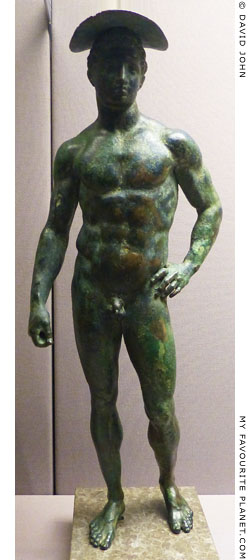
A bronze statuette of a nude,
youthful and athletic Hermes
wearing a petasos.
About 150 BC. Said to be from
Saponara, Basilicata, southern Italy.
The lean musculature and elongated
proportions indicate the influence
of Lysippos (mid-late 4th century BC).
British Museum.
Inv. No. GR 1849.6-22.1 (Bronze 1195).
Presented by R. Goff Esq. |
|
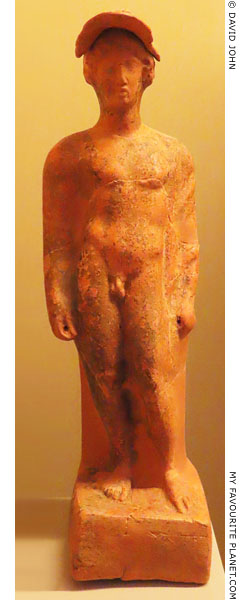
A terracotta statuette of a nude,
youthful Hermes wearing a petasos.
From ancient Abdera, Thrace,
northeastern Greece. Roman period. [6]
Abdera Archaeological Museum. |
|
| |
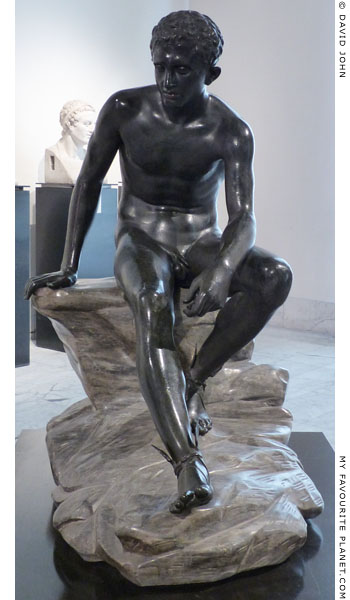 |

A winged sandal (Latin, talaris, of the ankle;
plural talaria) on Hermes' right foot. |
Bronze statue of youthful, athletic Hermes resting.
End of the 1st century BC. Found in 1758 in the rectangular peristyle of the Villa of the Papyri,
Herculaneum. Thought to have been made locally, modelled on a work by Lysippos or his school
(perhaps the original of the Hermes in the Kunsthistorisches Museum, Vienna). Height 105 cm.
Hermes, naked apart from his winged sandals (talaria), sits on a rock, leaning forward and
resting his right hand on his seat. He appears to be catching his breath from the exertions
of his tasks as messenger of the gods, rather like a young mortal athlete after training or
competing in a competition. He originally held the kerykeion (caduceus) in his left hand.
In World War II the statue was moved for safety to a bomb shelter at Montecassini,
from where it was stolen. It was recovered and returned to the museum in 1947.
National Archaeological Museum, Naples. Inv. No. 5625. |
|
| |
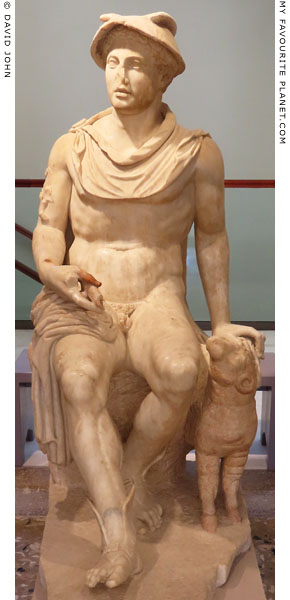
A marble statue of youthful Hermes seated
on a rock, with a ram standing to his left.
Around 150-200 AD. A monolithic staue of
white marble (perhaps Proconnesian marble)
on a low trapezoidal plinth. Height 139 cm,
height of ram 57 cm.
Kos Archaeological Museum.
Inv. No. 91 (Γ 3117). |
| |
Found in June 1937, along with six other marble statues, in Room VIII of the House of the Rape of Europa (la Casa considdetta del Ratto di Europa), in the centre of Kos Town, during excavations 1936-1940 directed by Italian archaeologist Luigi Morricone. The statue was found almost intact, with a few parts missing, such as fingers and toes. Some fragments were found separately. The large two-storey villa (area 550 square metres) was named after a floor mosaic found in Room XI, a thalamus (Latin, cubiculum; a private room for the mistress of the house) with a depiction of the mythical abduction of Europa by Zeus in the form of a bull. It is thought to have been occupied continuously from the 3rd century BC to the 3rd century AD, when it was destroyed by a landslide from the city's acropolis. [7]
Hermes is naked apart from a winged hat or helmet, winged talaria (sandals) and a himation (cloak) covering his shoulders and back, with part draped over his right thigh. The remains of a kerykeion can be seen in his right hand and on his right upper arm. Traces of rust on the hand and arm indicate that was partly made of metal. His left arm rests on the back of a ram, depicted at a smaller scale, standing at his side with its head raise to look at the god. His pose is similar to the bronze Hermes resting from Herculaneum (see above). The left leg is bent back, with the wight resting on his toes; while the right leg is extended forward, the weight resting on the heel. However, the torso of the Herculaneum figure is bent forward to show his exhaustion and the tension of the moment, while this young god sits upright, serene, majestic.
As is often the case, his cloak has been referred to as a chlamys (χλαμύς) and the headgear as a petasos (πέτασος). However, a chlamys is usually defined as a short cape or riding cloak, and a petasos as a broad-brimmed sun hat, or traveller's hat. This cloak is rather long, so that the distinction between himation and chlamys is moot. As can be seen from other images of Hermes on this page, the god was depicted wearing a variety of hats or caps, although modern commentators nearly always say that he is wearing a petasos. One imagines that the Greeks and Romans had other more specific names for the various hats, some of which appear quite fashionable, even though many of these names may now be unknown. The hat on this statue is very thick, far too thick to be a "sun hat", and is brimless, thus providing little protection from sun or rain. Hermes is often depicted wearing such bowl-shaped hat (see above), either brimless or with a narrow brim, sometimes with wings attached to either side (see photos here here here here here here ...), which look more like helmets. Pausanias, for example, described the statue of Hermes Kriophoros by Onatas at Olympia as wearing a helmet (see above).
It has been suggested that this sculpture may be have been inspired by a bronze statue of a seated Hermes with a ram standing next to him, seen by Pausanias on the Lechaion Road in Corinth, and thought to be the image shown on Corinthian coins of the 2nd century AD (see photo, right).
"Proceeding on the direct road to Lechaeum we see a bronze image of a seated Hermes. By him stands a ram, for Hermes is the god who is thought most to care for and to increase flocks, as Homer puts it in The Iliad:
'Son was he of Phorbas, the dearest of Trojans to Hermes,
Rich in flocks [πολυμήλου], for the god vouchsafed him wealth in abundance.'
Homer, Iliad, Book 14, line 490.
The story told at the mysteries of the Mother about Hermes and the ram I know but do not relate."
Pausanias, Description of Greece, Book 2, chapter 3, section 4. At Perseus Digital Library.
According to another theory, apparently supported by the labelling and literature of the Kos museum, the figure may depict Hermes Eumelos (Ἑρμῆς Εὔμηλος or Hermes Eumelios, Ἑρμῆς Εὔμηλιος, Rich in sheep; similar to Hermes Epimelios, Ἑρμες Ἐπιμηλίος, Keeper or Guardian of Flocks, see above). A cult of Hermes under this name, which perhaps absorbed an older local cult, is known from literary and epigraphic sources to have existed on Kos from at least the Hellenistic period. A mythological story, perhaps a local tale from Kos, known only from a short summary in the Metamorphoses (Μεταμορφώσεων Συναγωγή, Metamorphoseon Synagoge, literally Collection of Transformations) by the ancient Greek grammarian Antoninus Liberalis (Ἀντωνῖνος Λιβεράλις, probably 2nd or 3rd century AD). He, in turn credits an otherwise unknown book, Origins of Birds by Boios. [see note 7]
The story concerns the family of Eumelos, son of Merops (Μέροψ, Mankind, Mortals or Dividing the voice) who was a mythical king of Kos. Eumelos had a son, Agron (Ἄγρων, Wild or Rustic), and two daughters, Byssa and Meropis. They lived in the countryside, away from other people, worshipping only the earth goddess Gaia, refusing to sacrifice to Athena, Artemis or Hermes, who they regularly insulted. Angry at these blasphemers, the three deities visited them incognito, Hermes disguised as a shepherd and the goddesses as maidens (κόραι), and gave them a last chance to repent. When the three children persisted in their impiety, the gods transformed them and their father into birds.
"Eumelus, son of Merops, had children who were haughty and arrogant: Byssa, Meropis and Agron. They lived on Cos, the Meropid isle. Their land furnished them with plentiful crops because they worshipped its goddess [Gaia] alone and cultivated her soil diligently.
They had nothing to do with people and did not go to town for solemn banquets and festivals of the gods, instead, if someone about to sacrifice to Athena invited the girls, their brother would decline the invitation. He said he had no affection for a goddess with grey eyes because these girls had black eyes — and he utterly disliked the owl as a bird. If there were invitations to a feast of Artemis, he said that he hated a goddess who wandered about at night. If asked to go to pour libations to Hermes, he said he did not respect a god who was a thief. They frequently went in for this this sort of insult.
Hermes and Athena and Artemis were infuriated and one night made their way to their house. Athena and Artemis were in the shape of girls while Hermes wore the smock of a shepherd. He addressed Eumelus and Agron, inviting them to go to a banquet, to offer sacrifices to Hermes with other shepherds. He also urged him to send Byssa and Meropis to join the other girls of their age at the grove sacred to Athena and Artemis. So spoke Hermes. Meropis when she heard the name of Athena poured scorn on it. The goddess turned her into a little owl. Byssa is now the bird of Leucothea, called by the same name as before. When Agron became aware of all this he snatched up a spit and ran out but Hermes turned him into a plover. Eumelus abused Hermes for changing his son, so the god turned him into a long-eared owl, omen of evil.
NOTE: Boeus [Boios] tells this tale in the first book of his Origins of Birds."
Antoninus Liberalis, The Metamorphoses of Antoninus Liberalis, § 15, Meropis. Translation and commentary by Francis Celoria. Routledge, London and New York, 1992. At Topostext.
See also a ceramic relief of Hermes sitting on a rock in a similar pose below. |
|
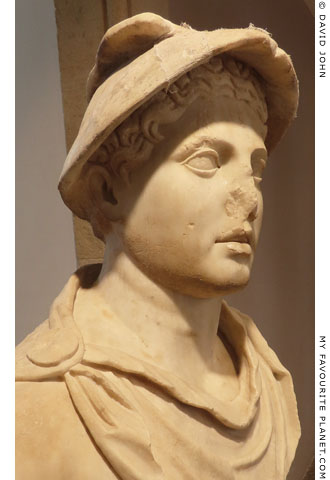
Hermes wears a thick, bowl-shaped
winged cap or helmet. |
| |
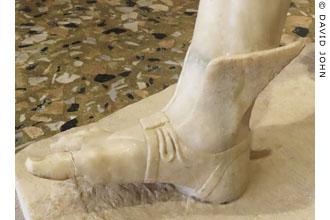
The right foot of the Hermes statue
with a winged sandal (talaris). |
| |
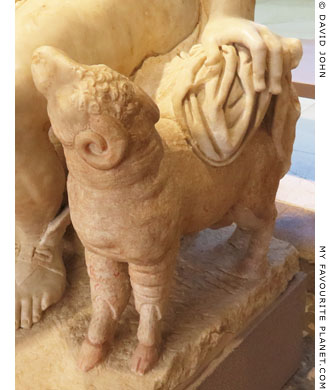
Hermes' left hand on the back of the ram
at his side which raises its head to look at
the youthful god. |
| |
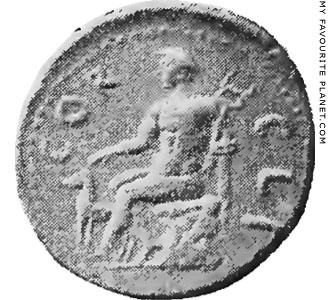
A copper coin of Corinth with a depiction of
Hermes, wearing a bowl-shaped hat and a
cloak, seated on a rock, holding a kerykeion
in his left hand and his right hand above a
ram which stands beside him.
Roman Imperial period, reign of
Marcus Aurelius, 161-180 AD.
Image source: Pausanias's Description of
Greece, Volume 3 (of 6), translated with a commentary by J. G. Frazer, fig. 13, page 25. Macmillan and Co., London, 1898.
Frazer commented on the statue of Hermes on
the Lechaion road mentioned by Pausanias:
"This group is represented on Corinthian
copper coins of the reigns of Marcus Aurelius,
Lucius Verus, Caracalla and Severus Alexander [Among the emperors who reigned 161-235 AD].
Hermes appears seated on a rock, holding the
caduceus in his left hand, while his right rests
upon a ram which stands beside him. On a coin
of the reign of Antoninus Pius [138-161 AD]
the same group is represented, but enclosed
within a distyle temple."
Both coin types are mentioned and illustrated in:
Friedrich Imhoof-Blumer and Percy Gardner,
A numismatic commentary on Pausanias.
page 23 and plate F, CX and CXI. Richard
Clay and Sons, London and Bungay, 1887.
At the Internet Archive. |
| |

A smaller than lifesize marble portrait
statue of a draped woman found next
to the Hermes statue in Room VIII of
the House of the Rape of Europa in Kos.
Roman Imperial period, reign of
Marcus Aurelius, 161-180 AD.
Kos Archaeological Museum. |
| |
| |
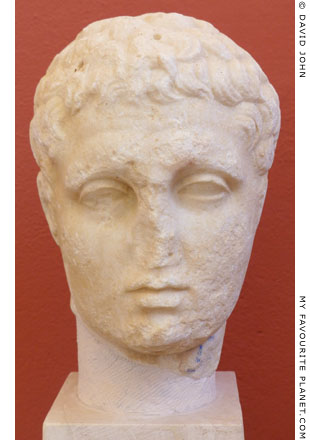
A marble head of Hermes or
an idealized portrait of a youth.
From Delos, Greece. Early 1st century BC.
Delos Archaeological Museum.
Inv. No. 4183. |
|

An Archaistic marble head of Hermes,
perhaps from a herm. The eyes, now
missing, were originally inlaid.
From Rhodes. Late Hellenistic period.
Rhodes Archaeological Museum.
Inv. No. E 187. |
|
| |
 |
|
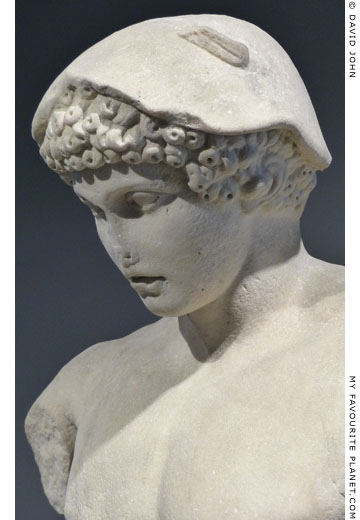 |
Marble statue of the "Hermes Ludovisi" type or "Hermes Loghios" type.
Flavian period, 2nd half of the 1st century AD, copy of a 5th century BC
Greek original, traditionally attributed to the young Pheidias. Found
in 1932 at the Villa Imperiale, Anzio. Italic marble. Height 130 cm.
Naked youthful Hermes wears a winged petasos and carries a cloak and caduceus
on his left arm. The lower legs and feet are missing, and as in the "Hermes Loghios"
statue above, it is thought that his right arm was extended forward.
Palazzo Massimo alle Terme, National Museum of Rome. Inv. No. 124479. |
|
| |
 |
|
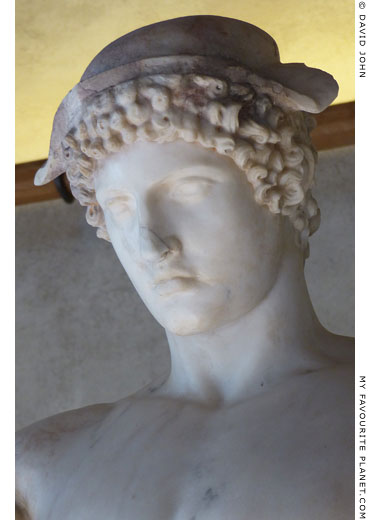 |
Marble statue known as the "Hermes Ludovisi", also referred to
as "Hermes Loghios" ("Mercurio Oratore", Mercury the Orator).
2nd century AD copy of a 5th century BC bronze original attributed to Pheidias,
around 440 BC. Thought to be one of the earliest statues of Hermes as
youthful and beardless. Pentelic marble. Height 166 cm, with base 183 cm.
Found near the Porta Tiburtina (Porta San Lorenzo), Rome. The statue was acquired in
the 17th century by Cardinal Ludovico Ludovisi. It was restored by Alessandro Algardi,
who added the arm, outstretched with an oratorical gesture. This led to the interpretration
of the figure as Hermes Loghios, the god of eloquence. The vast Boncompagni Ludovisi
Collection was auctioned in 1901, and many objects, including this statue, were acquired
by the National Roman Museum.
Palazzo Altemps, National Museum of Rome. Inv. No. 8624. Boncampagni Ludovisi Collection. |
|
| |
 |
|
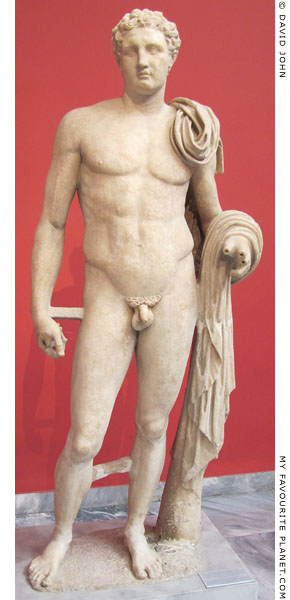 |
"The Atalante Hermes"
Found at Atalante (Αταλάντη), Phthiotis (Φθιῶτις), central Greece.
Pentelic Marble. 2nd century AD copy of a 4th century BC type
with Lysippean features. Height 196 cm.
A funerary statue of a youth depicted as Hermes. The nude figure has
a chlamys (riding cloak) over his left shoulder and wound around his
left arm. In his left hand he probably held a caduceus, Hermes' wand.
National Archaeological Museum, Athens. Inv. No. 240. |
|
| |
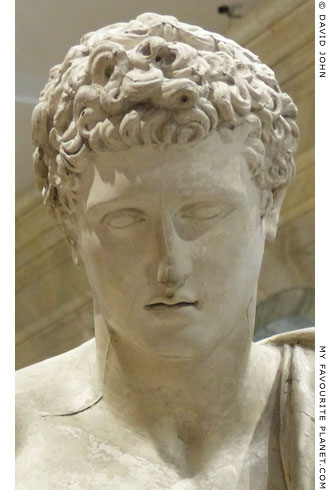
A plaster cast of the "Belvedere Hermes",
also known as the "Belvedere Antinous"
or "Hermes of the Museo Pio-Clementino",
a marble statue of Hermes previously
believed to portray Antinous.
Abguss-Sammlung, Semperbau, Dresden.
Inv. No. ASN 2356.
From the plaster cast collection of Anton
Raphael Mengs (see Niobe for further details). |
|
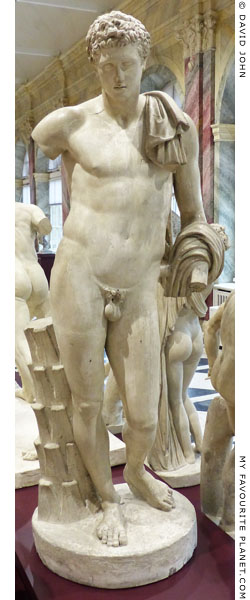 |
|
| |
The original is in the Pio Clementino Museum, Vatican Museums, Rome. Inv. No. 907.
Reign of Emperor Hadrian (117-138 AD). Height 195 cm.
The original statue was found in 1543 in the gardens around the Mausoleum of Hadrian (Castel Sant' Angelo) and thus long believed to be a portrait of Antinous, Emperor Hadrian's deified favourite. It was purchased in 1543 by Pope Paul III (Alessandro Farnese, 1468-1549, Pope 1534-1549) to decorate a niche in the Cortile del Belvedere (the Belvedere Courtyard, also known as the Cortile delle Statue, Courtyard of Statues) of the Vatican Palace. It was at first referred to as the "Antinous Admirandus". Now believed to depict Hermes as Psychopompos, and to have been modelled on bronze statues of the school of Praxiteles.
The nude figure stands in a contrapposto pose, within a chlamys (cloak) draped over his left shoulder and wrapped around the left forearm. His right leg leans against the palm tree stump support. It has been compared to other statues of Hermes associated with Praxiteles: the statue of Hermes carrying the infant Dionysus (see below); and the Andros (or Andros-Farnese) type statues of Hermes, named after the "Hermes Chthonios" in the Andros Archaeological Museum, Inv. No. MA 245 (formerly in the National Archaeological Museum, Athens, Inv. No. 218). |
|
| |
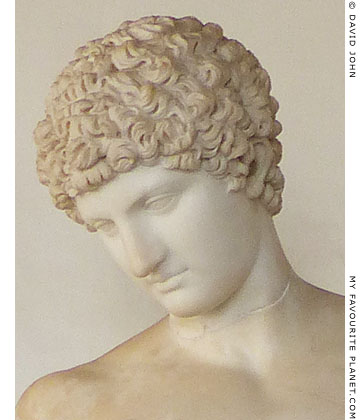
The so-called "Capitoline Antinous", a marble statue
of Hermes previously believed to be a portrait of
Antinous, Emperor Hadrian's deified favourite.
Roman period copy of a 4th century BC Greek
original. Luni (Carrara) marble. Height 180.1 cm.
Found at Hadrian's Villa, Tivoli in 1738 during
excavations financed by Cardinal Alessandro
Albani, and restored by Pietro Bracci. Albani ceded
his right to it to Pope Clement XII who donated
it to the Capitoline Museums. Taken to the Louvre,
Paris by Napoleon, following the Treaty of Tolentino
in 1791, and returned to the Capitoline in 1816.
The restored figure is thought to have originally
held an inverted kerykeion (with the top pointing
downwards) in his right hand, perhaps conducting
a deceased person to Hades.
Palazzo Nuovo, Capitoline Museums, Rome.
Inv. No. MC 741. From the Albani Collection. |
|
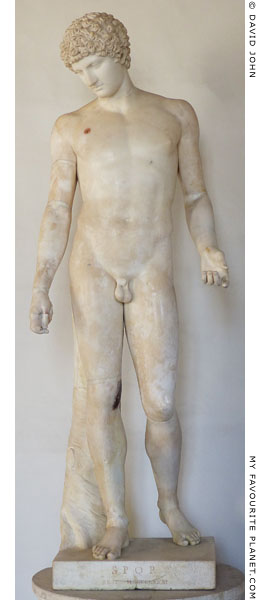 |
|
| |
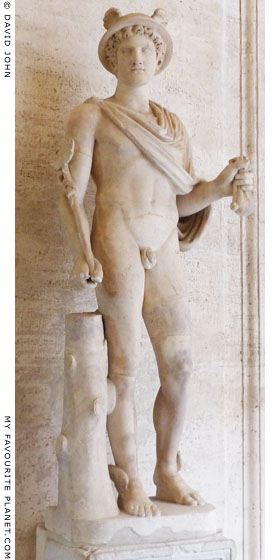
Marble statue of Mercury/Hermes,
with winged ankles, wearing a
winged helmet and a short cloak
over his shoulders, and carrying
a caduceus and a purse.
Roman copy of an early
4th century BC Greek original.
Palazzo Nuovo, Capitoline Museums,
Rome. Inv. No. MC 60. |
|
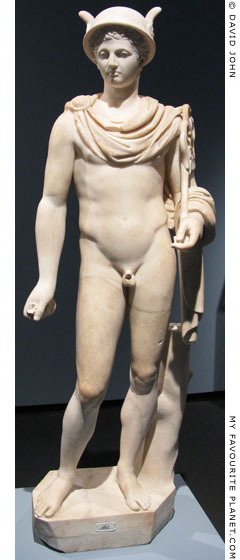
Restored marble statue of Hermes,
wearing a winged helmet and short
cloak, and carrying a caduceus.
2nd century AD, Antonine age,
with forms and motifs of the
Classical period. Height 150 cm.
width 52 cm, depth 42 cm.
Pergamon Museum, Berlin.
Inv. No. Sk 198.
From the Natali collection, Rome.
Acquired in 1766 by the art dealer
Giovanni Ludovico Bianconi for King
Friedrich II of Prussia (Frederick
the Great) who placed it in the
Neue Palais, Sanssouci, Potsdam. |
|
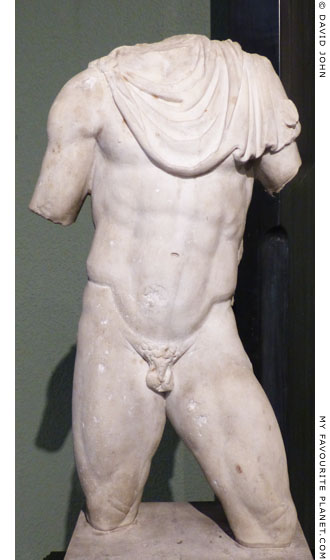
Marble torso of a statuette of Mercury/Hermes.
1st - 2nd century AD. Found in 1934 in a well
between Via San Giovanni in Laterano and
Via Visconti, in the area of the present
Piazza Diaz, Milan (ancient Mediolanum).
Perhaps part of the sculptural decoration of
a Roman house. A fragment of a caduceus
is preserved on the cloak. Height 56.5 cm.
Civic Archaeological Museum, Milan.
Inv. No. A 0.9.1161. |
|
| |
 |
|
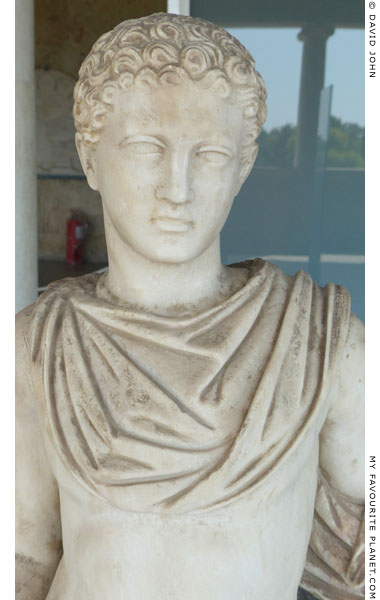 |
Marble statue of a youthful Hermes, wearing a cloak
and carrying a kerykeion (caduceus) on his left arm.
2nd century AD, copy of a 4th century BC original.
From the Athens Agora.
Agora Museum, Athens. Inv. No. S 1054. |
|
| |
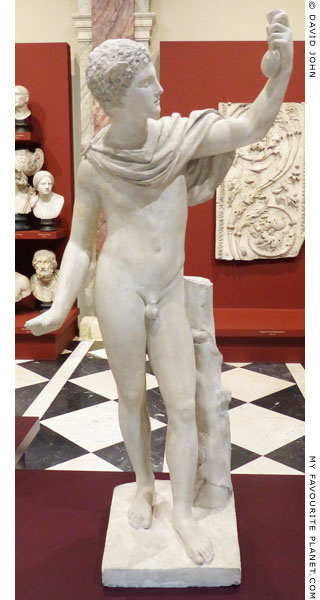
Plaster cast of a marble statue of Hermes
of the "Tegel-Stockholm" type in Berlin.
Abguss-Sammlung (Cast Collection),
Semperbau, Dresden. Inv. No. ASN 2251.
|
The original is in the Antikensammlung, State Museums Berlin. Inv. No. Sk 531. Height 153.5 cm.
The nude Hermes, with a winged head and wearing a chlamys cloak over his shoulders, looks up at a purse which he holds in his raised left hand. The original statue in Berlin is a concoction produced in the Roman workshop of the prodigious sculptor and restorer Bartolomeo Cavaceppi (circa 1715 - 1799), who added the unrelated ancient head, the purse, arms, legs and other parts to the ancient torso. It was purchased in Rome in by Markgräfin Friederike Sophie Wilhelmine von Brandenburg-Bayreuth (1709-1758), who left it in her will, along with other objects from her collection, to her brother King Friedrich II of Prussia (Frederick the Great). It was first set up at Friedrich's Sanssouci palace in Potsdam, and then in the Marmorpalais in Potsdam. It entered the Berlin museum in 1830.
Cavaceppi later sculpted a head based on this one, perhaps copied from a cast, when restoring a statue group of Perseus and Andromeda, found in Rome in 1760. It was sold to Graf Johann Ludwig von Wallmoden-Gimborn in 1765, and is now in the Landesmuseum Hannover. |
|
| |
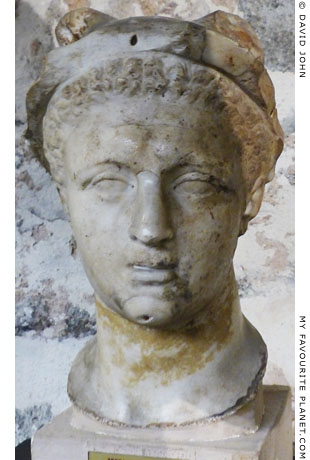
Marble head of Mercury/Hermes
wearing a winged helmet.
Roman copy of an early
4th century BC Greek model.
Museo Civico, Castello Ursino, Catania,
Sicily. From the Biscari Collection. |
|
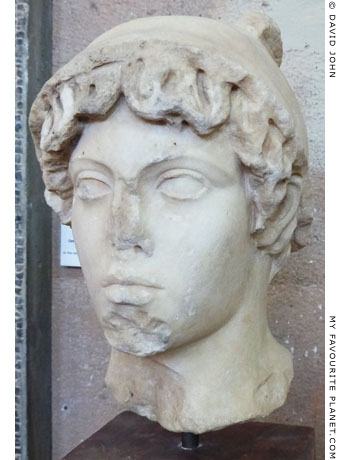
Marble head of Hermes or Perseus
wearing a winged cap or helmet.
Found 1972 in the Forum of Ancient Corinth.
2nd century AD "copy of a 5th century BC
original". Height 30.6 cm.
Corinth Archaeological Museum. Inv. No. S-72-4. |
|
| |
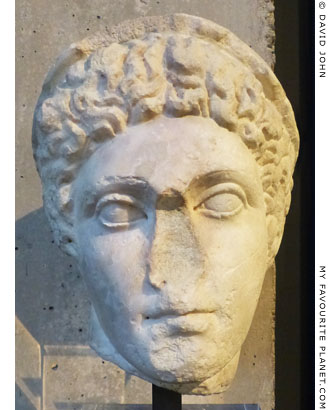
Marble head from a statue of Hermes/Mercury.
2nd century AD. Origin unknown.
Civic Archaeological Museum, Milan.
Inv. No. A 0.9.1412. |
|

Small marble head of Hermes.
Roman creation based on a 4th century BC
Greek original. Insular marble.
Barracco Museum, Rome. Inv. No. MB 141. |
|
| |
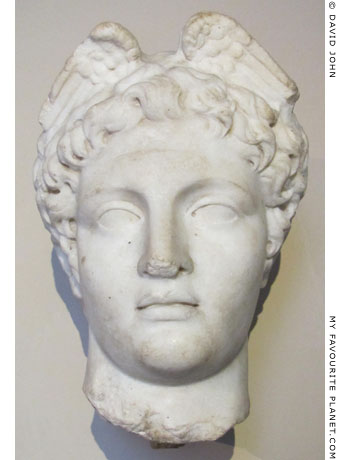
Marble winged head of Hermes from Pergamon.
Roman Imperial period, 1st century AD.
Found at the Sanctuary of Demeter,
Pergamon in 1909. Height 29 cm.
Istanbul Archaeological Museum.
Inv. No. 2162 T. Cat. Mendel 555. |
|
|
| |
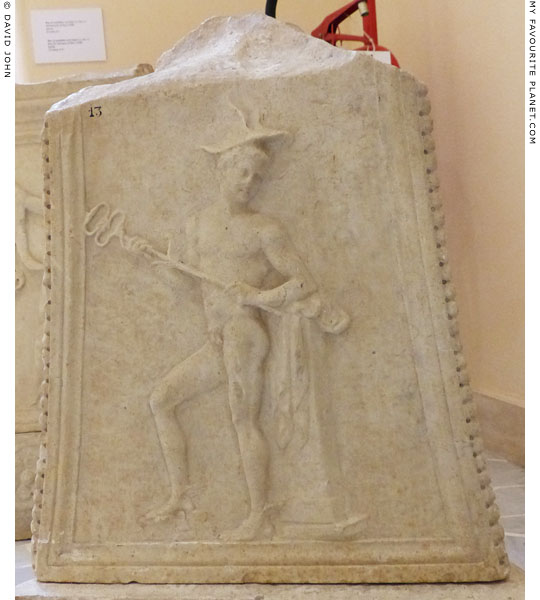
Relief of Mercury with winged cap and ankles, cloak,
and caduceus, on the base of a marble candelabrum.
Roman, 2nd century AD. Found in 1940 in the Sanctuary of Attis, Ostia.
One of two large marble candelabra bases found in the sanctuary,
with reliefs of gods and satyrs on each of the three sides. On this
base are Apollo, Mercury and Hercules; on the other are satyrs.
Ostia Archaeological Museum. |
| |
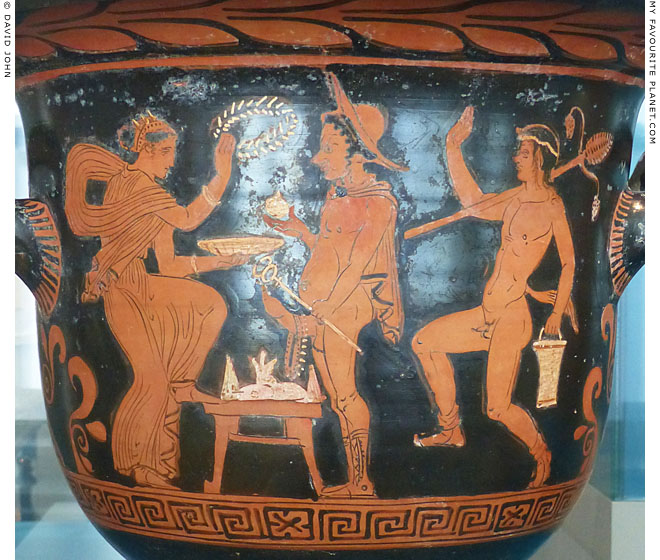
Detail of a Lucanian red-figure bell krater showing a priestess offering a wreath to a grotesquely
caricatured Hermes, who wears a petasos and cloak and has another wreath hanging from his
oversize erect penis. The table serves as an altar. A Satyr with a thyrsos staff (see Dionysus)
approaches from the right. The irreverent scene probably represents a farce.
Probably made in Metapontion (Μεταπόντιον) on the gulf of Tarentum, Italy,
around 380-360 BC. Attributed to the Brooklyn-Budapest Painter.
Museum für Kunst und Gewerbe Hamburg. Inv. No. 2008-404.
Justus Brinckmann Gesellschaft. |
| |

Neck of a Paestan red-figure neck amphora showing Hermes with a female figure.
Made in Paestum, 340-330 BC. Excavated in 1969 in Tomb 69 at Licinella.
The body of the amphora depicts the birth of Aphrodite in quite a different style.
On the neck, a youthful Hermes stands naked apart from a cloak, golden wreath
and a petasos hat hanging from his neck. He has winged ankles and holds a
kerykeion in his right hand. With his left hand he gestures to an elegantly
dressed young woman, sitting on rocks and holding a casket in her right hand.
The seaside city Poseidonia (Ποσειδωνία) in Magna Graecia (on the west coast of
southern Italy) was founded around 600 BC by Greek colonists from either Sybaris
(Σύβαρις, Gulf of Taranto, itself founded by Achaeans and Troezenians in 720 BC;
today Sibari, Calabria, Italy) or Troezen (Τροιζήν, Argolid Peninsula, northeastern
Peloponnese), or perhaps by Achaeans and Troezenians together. In the late 5th
century BC it was conquered and renamed Paiston (Παῖστον) by the Lucanians, an
Italic people whose culture is known as Oscan. However, archaeological evidence
indicates that both cultures continued to thrive alongside each other. The city
became known as Paestum following conquest by the Romans in 273 BC.
National Archaeological Museum of Paestum, Campania, Italy. |
| |
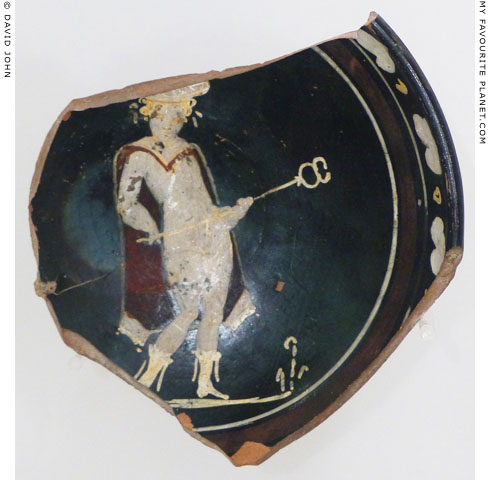
Fragment of a small ceramic plate with a painting of Hermes.
1st half of the 3rd century BC. Found in the Tiber River, near the Temple of Portunus
(and the location of the ancient Pons Aemilius bridge) of the Forum Boarium, Rome.
Baths of Diocletian, National Museum of Rome. |
| |
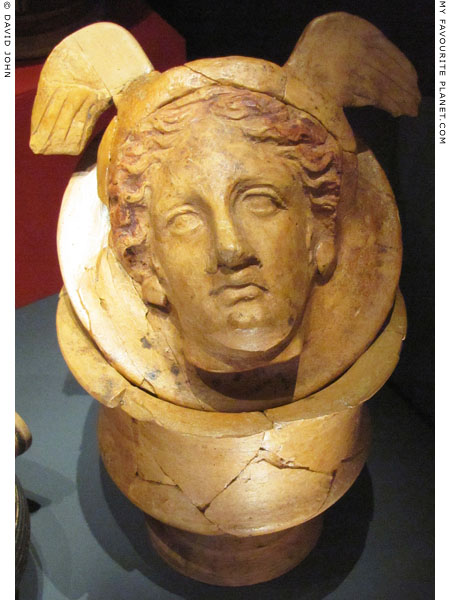
A high relief of the head of Hermes wearing a
winged helmet on the lid of a ceramic vessel.
4th century BC. One of several vessels from a Samnite cremation burial,
found in Tomb 23 in the necropolis at Larino, the location of the Samnite
city Larinum, Campobasso province, Molise region, south-central Italy. [8]
Grave goods found in the tomb relate to banqueting and the cult of Dionysus,
adopted by the Samnites from the Greeks of Magna Graecia (southern Italy).
See also:
Pan on the lid of a lebes from Larino
Dionysian imagery on ancient artefacts from Samnium |
| |
| Hermes |
Hermes Nymphopompos Leader of Nymphs |
|
 |
|
| |

Marble votive relief depicting Hermes Nymphopompos (Νυμφοπομπός,
Leader of Nymphs), leading three Nymphs in a dance.
From Greece, 410-400 BC. Found on the Quirinal Hill, Rome.
Height 57 cm, width 78 cm, depth 10 cm.
Hermes is naked apart from a chlamys (χλαμύς, short cloak) hanging from his left shoulder
and a petasos (πέτασος, broad-brimmed hat) hanging behind his head. He leads three Nymphs
towards the much smaller figure of the worshipper (the dedicator of the relief) on the far left.
On the right stands the river God Acheloos as a bull with a horned human head. The top right
corner of the relief is missing, but the crossed legs of Pan sitting on a rock ledge can be seen.
Altes Museum. Inv. No. Sk 709 a. Acquired in 1889. |
| |
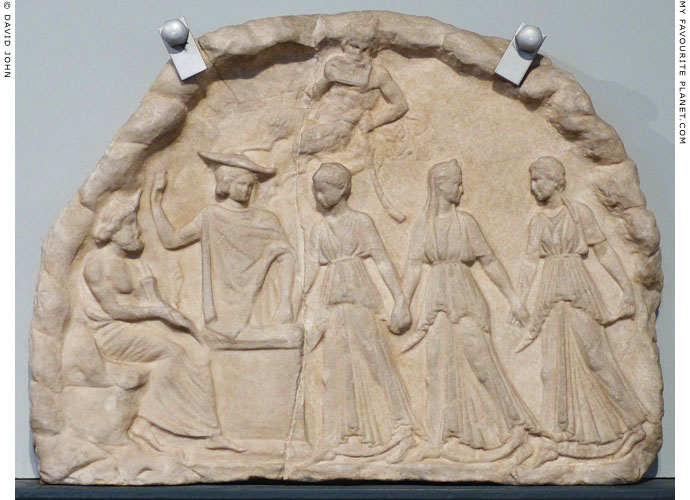
An Archaistic votive relief showing three Nymphs walking hand-in-hand and being led by Hermes,
as Nymphopompos, into a cave representing the underworld. They stand before an altar, to the
left of which sits Plouton (Πλούτον, also known as Hades, ᾍδης), the god of the underworld,
holding a rhyton (drinking horn). Pan looks on from above, playing his syrinx (pan pipes), with a
lagobolon (curved hunting stick) in his left hand. Hermes wears his trademark petasos (πέτασος,
broad-brimmed hat) and a chlamys (χλαμύς, short cloak).
Hellenistic period. Pentelic marble.
Barracco Museum, Rome. Inv. No. MB 176.
See similar reliefs depicting Hermes, Pan, Nymphs
and other deities below and on the Pan page. |
| |
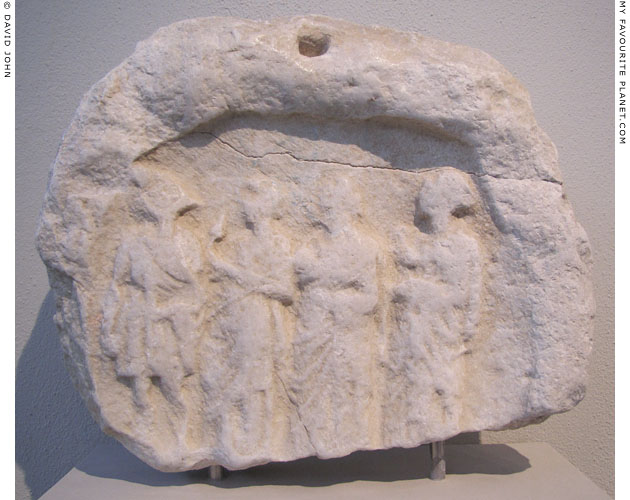
A votive relief depicting Hermes Nymphopompos with three Nymphs in a cave.
End of the 4th century BC. Unknown provenance. Height 44 cm.
Thasos Archaeological Museum. Inv. No. 30. |
| |

Fragment of a marble votive relief from Rhodes depicting Hermes
Nymphopompos (left) leading Nymphs in a dance in a cave, above
the roof of which appear the heads of goats.
Hellenistic period, second half of the 2nd century BC. From the ancient
city of Rhodes. Found in the Nymphaea (Νυμφαία), a complex of cavelike
constructions cut into bedrock for the worship of the Nymphs and other
rural deities, on the northwest slope of the acropolis.
Rhodes Archaeological Museum.
Currently (2022) part of the extended exhibition "Ancient Rhodes - 2400 years"
in the Palace of the Grand Master, Rhodes. |
| |
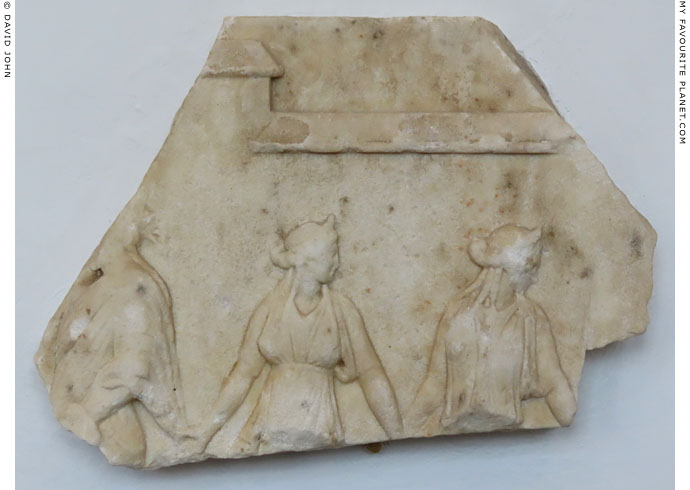
Fragment of an Archaistic votive relief from Rhodes depicting Hermes Nymphopompos
(left) leading Nymphs in a dance. Above the figures is what appears to be the top of
a wall, perhaps the perimeter of a sanctuary.
Roman period, 1st century BC.
Rhodes Archaeological Museum. Inv. No. E 605. |
| |
| Hermes |
Hermes Psychopompos Guide of Souls |
|
 |
|
| |
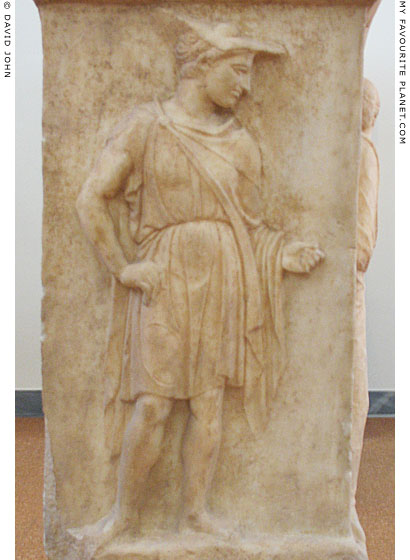
Detail of one side of a base for a funeral vase with a relief of
Hermes as Psychopompos (Ἑρμῆς Ψυχοπομπός, Guide of Souls).
Marble. 410-400 BC. Found in Moschato, Athens.
Hermes wears a short chiton tunic, chlamys cloak and petasos hat. It is thought that
his herald's staff was rendered in paint. Two other sides of the base also have reliefs:
the front shows a young girl and a youth picking apples from a tree, an allusion to
the Elysian Fields and the afterlife; the third shows a priest holding a sacrificial knife.
National Archaeological Museum, Athens. Inv. No. 4502. |
| |
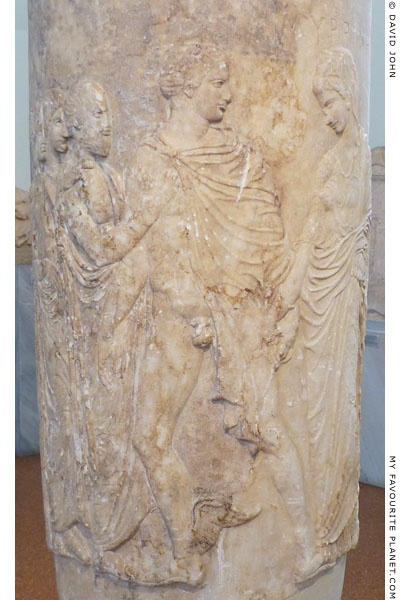 |
|
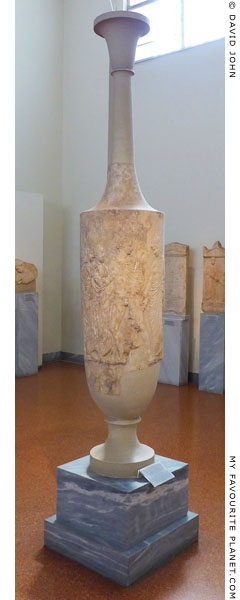 |
The Myrrhine lekythos, a 5th century BC inscribed marble
funerary vase found in Syntagma Square, Athens.
Hermes Psychopompos (Ἑρμῆς Ψυχοπομπός, Guide of Souls) leads the
deceased Myrrhine to the underworld (Hades). Her name, Μυρρίνε (Myrtle),
is inscribed above her head. On the left her relatives bid her farewell.
National Archaeological Museum, Athens. Inv. No. 4485.
See Athens Acropolis gallery page 11. |
|
| |
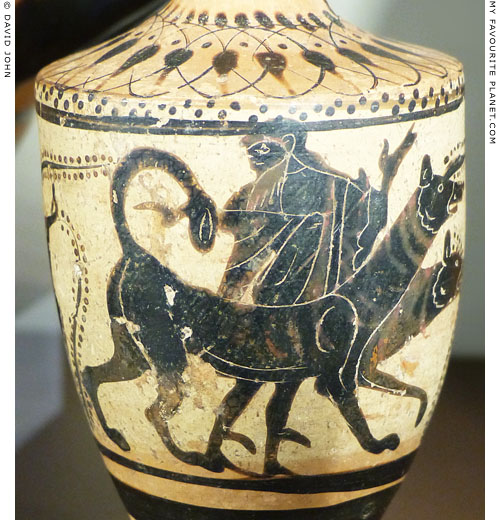
Detail of a black-figure lekythos with a depiction of Hermes in the
Underworld with Kerberos, the hound of Hades, in front of a seated
female figure (not visible in museum display). Bearded Hermes is
depicted in a kind of visual shorthand of his Archaic form, identifiable
by his winged ankles. Pride of place in this painting appears to be
preserved for the monstrous, long-bodied, double-headed Hell
hound strutting across the vessel's body.
5th century BC. From Eleonas, Boeotia.
Thebes Archaeological Museum. |
| |
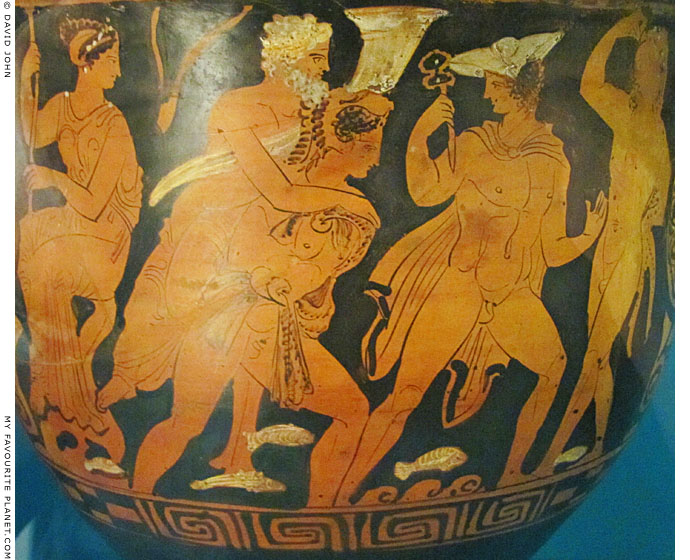
Hermes and Herakles in a scene from the underworld.
Detail of an Attic red-figure bell krater, circa 370 BC. Attributed to the Pourtalès Painter.
Height (restored with modern foot) 35.3 cm, diameter 35.1 cm.
Side B shows three youths draped in cloaks, one holding a strigil and another a diskos.
Antikensammlung, Berlin State Museums (SMB). Inv. No. 31094.
Purchased 1928. Formerly in the Giovanni Carafa Collection, Naples; Champernowne
Collection, London. Known since 1737 when it was in the possession of Matteo Egizio, Naples.
|
| Hermes Psychopompos leads Herakles, who is carrying a bearded male with a cornucopia, probably Plouton (Πλούτον, also known as Hades, ᾍδης), the god of the underworld, through the River Styx. Hermes wears a petasos (πέτασος, a broad-brimmed sun hat, originally from Thessaly) and a chlamys (χλαμύς) cloak, and holds a kerykeion in his right hand. |
|
| |

Relief of Hermes Psychopompos and a female figure on a marble column
drum from the later Temple of Artemis, Ephesus. 325-300 BC.
Height 1.84 metres, diameter 1.97 metres.
British Museum. Inv. No. GR 1872.8-3.9 (Sculpture 1206).
|
Found by the British archaeologist John Turtle Wood at the southwest corner of the later temple, during excavations in 1871. According to Pliny the Elder (Natural history, Book 36, chapter 21), thirty six of the temple's columns were decorated with sculpture, one of which was sculpted by Skopas. Around this column drum, the best preserved, is a sculpted relief of seven figures, two of which have been destroyed.
The three figures in the photo above seem to be the focus of the group. A woman is flanked by two male figures. To her left, the naked, winged youth with a sheathed sword at his side is thought to be Thanatos (Death). The figure to her right is clearly Hermes as Psychopompos. The theme of the scene appears to be the death of the woman, whose identity is unknown, but is thought to be one of the tragic heroines of Greek myth, perhaps Eurydike, Alkestis or Iphigenia.
Hermes stands naked with a cloak wrapped around his left arm and holding a kerykeion in his right hand. He appears to be stepping forward and looking up - at what can only be guessed. |
|
| |
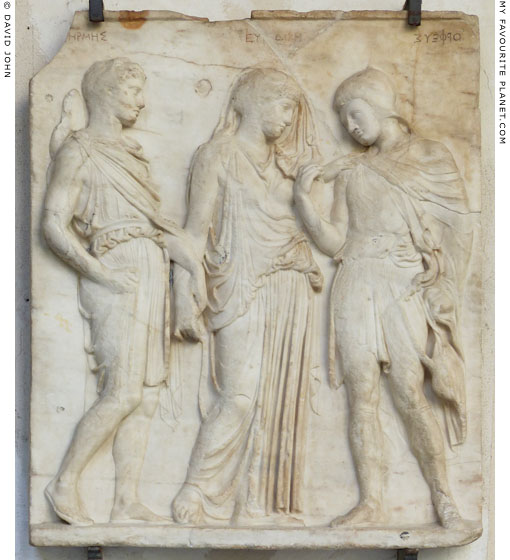
Marble relief, known as the "Orpheus Relief", depicting
Hermes, Eurydice and Orpheus in the Underworld.
1st century AD. Found at Torre del Greco, near Herculaneum in the Bay of Naples. Pentelic marble.
Height 118-119 cm, width 96 cm (bottom 99 cm, top 92.5 cm), depth 7.5 - 8 cm.
National Archaeological Museum, Naples. Inv. No. 6727. Carafa di Noja Collection.
|
The relief is believed to have made in the 1st century AD, during the Augustan period, and before the eruption of Vesuvius in 79 AD. It is thought to be a copy of a Greek original of the second half of the 5th century BC, in the High Classical style of the sculptures of the Parthenon, and has been attributed to Alkamenes, pupil of Pheidias. It was found some time before before 1641 on a farm near the "Royal Road" to Salerno, at Torre del Greco, around 3.6 km southeast of Herculaneum. By 1645 it had been moved to the royal collections in Naples where it was restored. In 1734 excavations were begun at the site of the find which proved to be location of a luxurious seaside villa, perhaps belonging to the imperial family, which has been named the Villa Sora.
This is one of six almost identical surviving Roman period three-figure reliefs; two other almost complete examples are in the Villa Albani, Rome, Inv. No. 1031, and the Louvre, Paris, Inv. No. MA 960 (MR 817). The type is the earliest extant depiction of the well-known myth of Orpheus and Eurydice in the Underworld (Hades).
Distraught with grief by the death of his bride Eurydice, Orpheus descended to the Underworld in search of her. He charmed the gods there with his music and they permitted him to return with Eurydice to the land of the living, on the condition that he did not look back at her during the long journey. However, when they had almost reached the boundary of the Underworld, Orpheus could not resist his longing to see her face. He turned and lifted her veil to look at her, breaking the condition set by the gods, and she was forced to remain in the realm of the dead.
In the relief Eurydice is shown unveiled, and she and Orpheus touch each other tenderly. But Hermes, as Psychopompos (Guide of Souls), has already taken hold of her arm to lead her back down to Hades.
The names of the figures are inscribed in Greek above their heads, although the inscriptions are probably modern additions. Hermes is also identifiable by the petasos (broad-brimmed sun hat) hanging behind his head. The name of Orpheus, with his Phrygian cap and lyre, is written back-to-front, perhaps to indicate that he comes from the world of the living. |
|
| |
| Hermes |
Hermes with other gods |
|
 |
|
| |
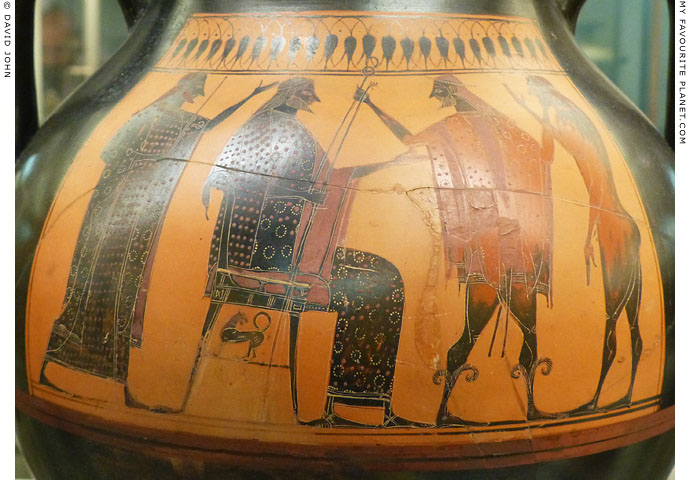
Detail of an Attic black-figure amphora with a depiction of
Hermes standing before Zeus, who is sitting on his throne.
Made in Athens around 540-520 BC. Attributed to The Affecter.
British Museum. GR 1837.6-9.66 (Vase B 149). |
| |
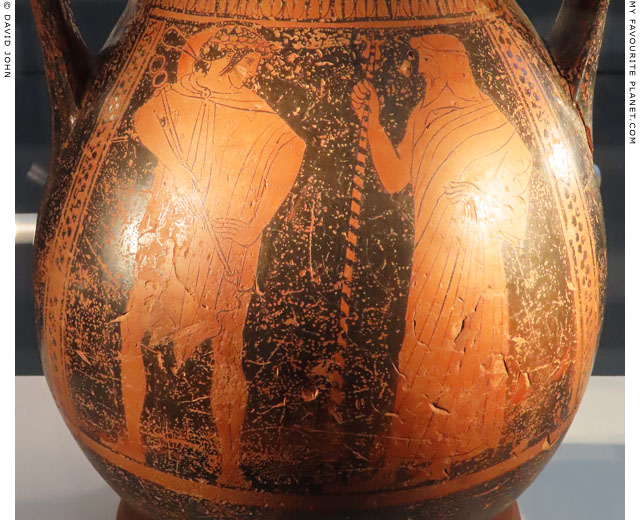
Detail of an Attic red-figure pelike with a depiction of a youthful Hermes (left) standing and facing
Zeus to the right. Hermes wears a wreath and chlamys, with a petasos hanging behind his head.
His left hand rests on his hip, and with his right hand he holds a kerykeion. Zeus, with long white
hair and beard, stands facing him. He is wrapped in a himation, holds a sceptre in his right hand
and also rests his left hand on his hip. The painting on side B shows Nike and Iris (see below).
Around 475-450 BC. Possibly from Olynthos, western Halkidiki, Macedonia, Greece.
Polygyros Archaeological Museum. From the Lambropoulos Collection. |
| |
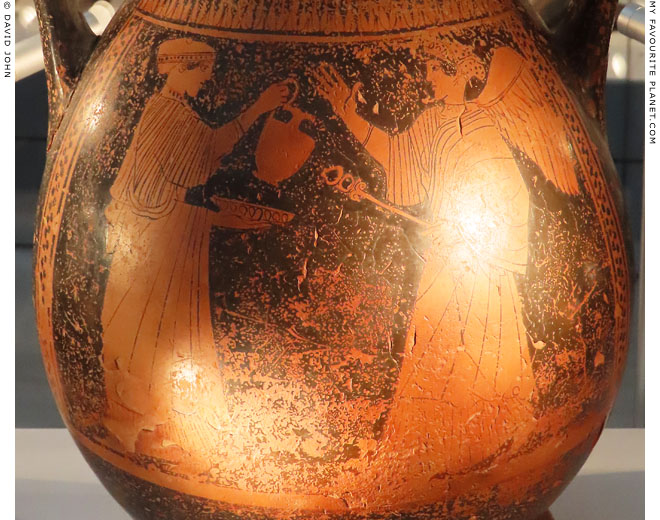
Nike and Iris on Side B of the Attic red-figure pelike above. Both figures are shown in side view,
their faces in profile and facing each other. Nike, here without wings, stands on the left, facing
right, wearing a himation (cloak) over a chiton (tunic). In her raised right hand she holds an
oinochoe (wine jug), and on the upturned palm of her left hand is a phiale (libation bowl). She
appears to be offering sacrifice to winged Iris (Ιρις, Rainbow) as she walks towards her from
the right. The "swift-footed" rainbow goddess is is similarly dressed, her right hand raised in
greeting, and in her left hand she carries a kerykeion.
Iris was a female counterpart of Hermes as a messenger of the Olympian gods, particularly
Hera, hence her herald's staff. She is described by Greek and Roman authors as carrying
messages to deities and mortals. However, although she was mentioned by Hesiod and
several times in Homer's Iliad, she appears far less often in ancient literature than Hermes,
and is seldom represented in surviving artworks. Nike also ran errands for the gods, often
depicted delivering wreaths and palm branches to humans as tokens of victory in war and
competitions. She is also shown busily serving Athena, for example in the balustrade
reliefs of the Temple of Athena Nike on the Athens Acropolis.
Around 475-450 BC. Possibly from Olynthos, western Halkidiki, Macedonia, Greece.
Polygyros Archaeological Museum. From the Lambropoulos Collection. |
| |
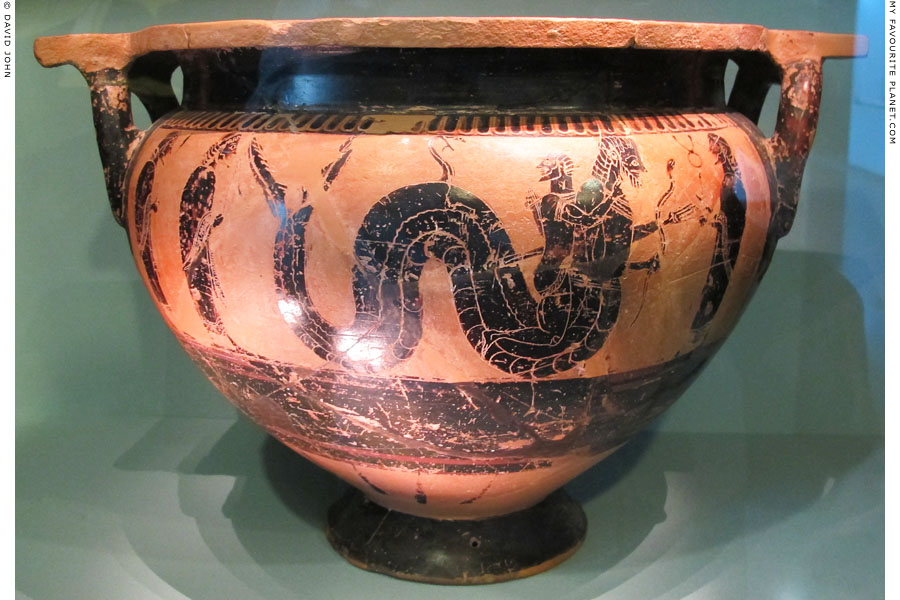
Herakles wrestles with the sea god Nereus (Νηρεύς), watched by two bearded
male figures (left) holding spears and bearded Hermes holding a kerykeion (right).
An episode from the hero's wanderings in the land of the Hesperides.
An Attic black-figure column krater painted by Sophilos around 590 BC.
Provenance unknown. Height 36 cm, diameter of rim 42 cm, diameter of base 19.4 cm.
National Archaeological Museum, Athens. Inv. No. 12587.
|
Exhibited during the temporary exhibition The Europe of Greece: Colonies and Coins from the Alpha Bank Collection (Η Ευρώπη της Ελλάδος Αποκίες και Νομίσματα από τη Συλλογή της Alpha Bank), Thessaloniki Archaeological Museum, 11 April 2014 - 19 April 2015.
Nereus had the power to change form. One of the twelve labours of Herakles was to obtain the Golden Apples of the Hesperides, but he first has to capture Nereus to discover from him the location of the Garden of the Hesperides. Herakles, dressed in a short chiton (tunic) and with a sword and quiver, jumps on the sea god who changes his form in an attempt to escape. Here Nereus is depicted in a similar way to Triton, with the body of a bearded man, while his lower half is in the form of a long fish-like sea creature. He holds a serpent in his right hand, and his left arm is extended towards Hermes.
According to the Roman mythographer Hyginus (see the note in Homer part 2), Hermes introduced the sport of wrestling to humans:
"The same Mercury first taught wrestling to mortals."
Hyginus, Fabulae, sections 200-277, section 277, First inventions. At the Theoi Project. |
|
| |
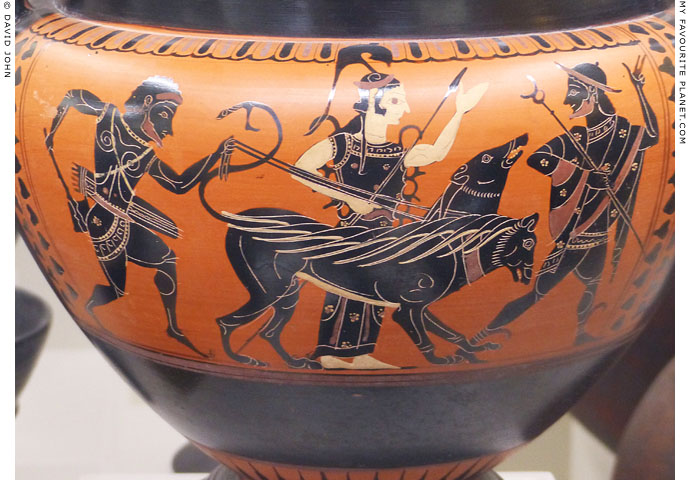
Detail of an Attic black-figure krater showing Herakles holding
Cerberus on leashes in the presence of Athena and Hermes.
National Etruscan Museum, Villa Giulia, Rome. |
| |
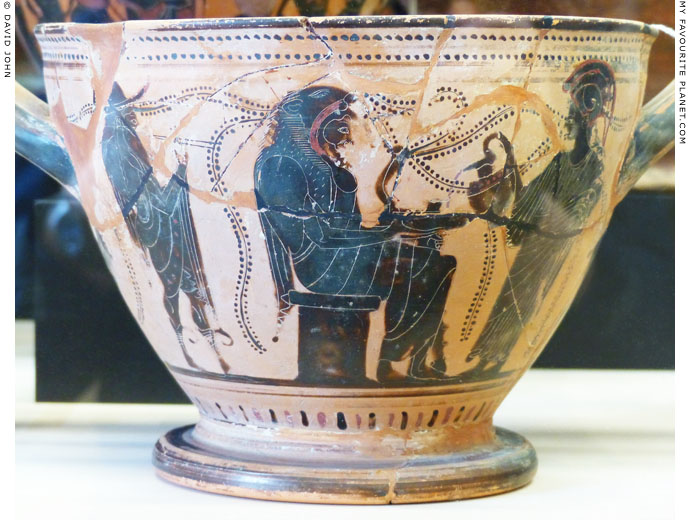
Detail of an Attic black-figure skyphos (deep drinking cup) depicting Hermes and Athena
attending the apotheosis of Herakles, the hero's deification and introduction to Olympus.
Second half of the 6th century BC. Height 18.6 cm.
Studiendepot, Skulpturensammlung, Albertinum, Dresden. Inv. No. Hm 240 (Zv 1680).
|
| |
In the centre, Herakles, wearing the skin of the Nemean Lion, sits on what appears to be a small altar. He holds his wooden club in his left hand, and in the right he holds a phiale (libation bowl), into which Athena, standing to the right, pours wine from a jug. Behind the phiale is the stem of an ivy plant, the branches of which extend between and behind the figures.
Hermes, with long hair and beard, stands on the left playing an aulos (double pipes). He wears a petasos (broad-brimmed hat), himation (cloak) and winged high sandals. |
|
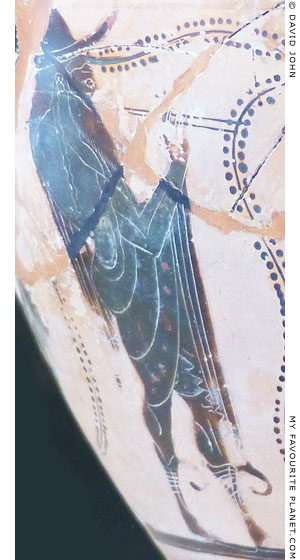
Hermes playing an aulos. |
|
| |
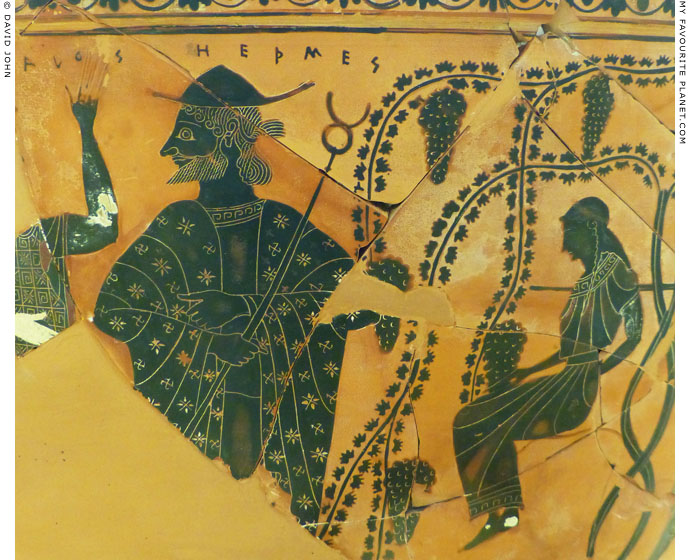
Detail of a fragmentary inscribed Attic black-figure calyx-krater painted by Exekias,
depicting Hermes and other deities taking part in the apotheosis of Herakles.
Around 530 BC. Found in 1937 in a well on the
North Slope of the Athens Acropolis. Height 44.5 cm.
Museum of the Ancient Agora, Athens. Inv. No. AP 1044.
|
The name ΗΕΡΜΕΣ (Hermes) is painted clearly above the god's head. Typical of Exekias' style are the bold composition and the finely incised drawing of contours and details, such as Hermes' hair and beard, and the patterns of his garments: the meander on the collar of his tunic, and flowers/stars and swastikas on his cloak.
Hermes is finely dressed for the special occasion. He carries a long kerykeion (caduceus), and wears a petasos over his elaborately styled hair. To the right, tendril-like vines, loaded with bunches of grapes, fill the space and seem to dance in the breeze. The grapes are made plastic by the simple trick of indicating the highlights of individual fruits with C-shaped incisions. Among the vines sits a small female figure in profile, her head now just a silhoutte.
To the left of Hermes (not shown in photo) Athena drives the chariot carrying Herakles to Mount Olympus.
Side B of the krater shows the fight between Greek and Trojan warriors over the body of the fallen Patrokles (see Homer part 2); in the lower zone lions attacking a bull. |
|
| |
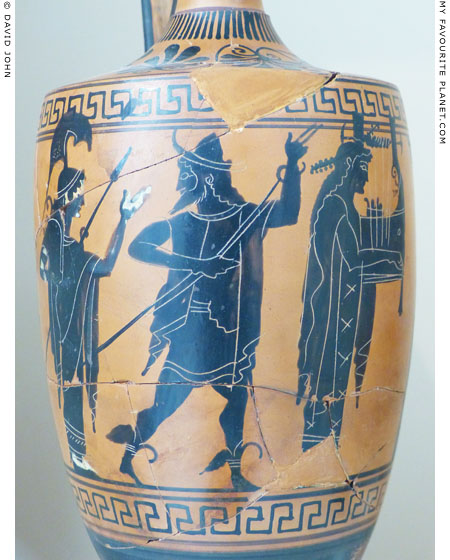
Detail of an Attic black-figure lekythos with a depiction of Athena,
Hermes and Apollo taking part in the apotheosis of Herakles.
Around 500 BC. Found in the Athenian Agora.
Museum of the Ancient Agora, Athens. Inv. No. P 24104.
Currently exhibited in the Museum of the History
of the Ancient Olympic Games, Olympia. |
| |
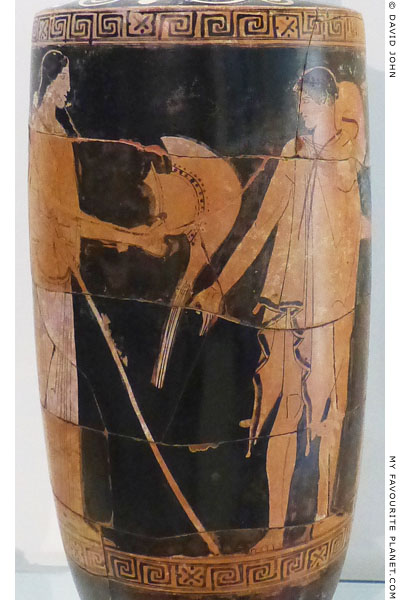 |
|
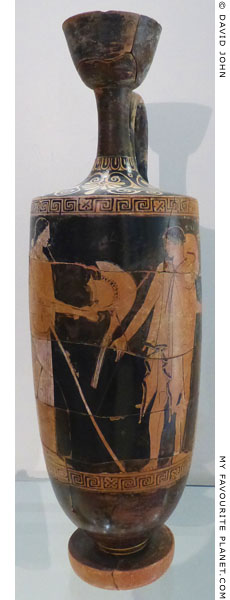 |
Athena and Hermes on an Attic red-figure lekythos. Made in Athens 475-460 BC.
From the cemetery at Poggio Giache, Akragas (Agrigento), Sicily.
Attributed to the Providence Painter.
On the left Athena, wearing a peplos with a decorated border and
a quiver over her shoulder, holds a spear and offers a helmet to
Hermes. He wears a chlamys, a petasos tied to his neck hangs behind
his head, and he holds a spear in his left hand (not visible in photo).
Agrigento Regional Archaeological Museum, Sicily. |
|
| |
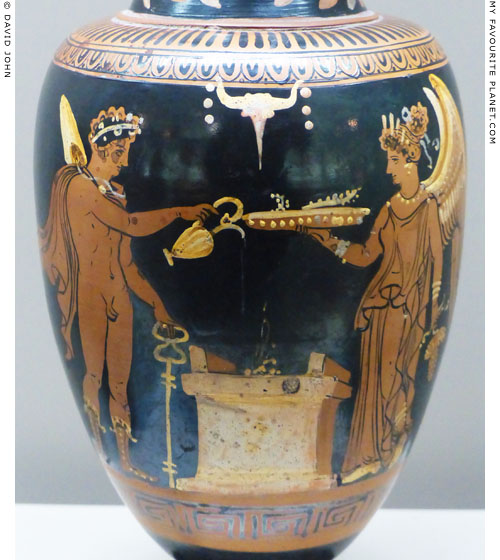
Detail of an Apulian red-figure, long-necked oinochoe (wine jug) depicting
Hermes and Nike making sacrifices and offerings of first fruits at a burning altar.
Mid 4th century BC.
Hermes wears a wreath, cloak and high sandals, with a petasos hanging from
his neck, and holds his kerykeion in his left hand. He stands to the left of a small
altar, notably shown in perspective, pouring a liquid (wine?) from a jug onto the
flames. Winged Nike, wearing a wreath and peplos, stands to the right of the altar
holding a bowl with offerings in her right hand, and a bunch of grapes in the left.
A garlanded boukranion (ox skull) hangs above them.
Civic Archaeological Museum, Milan. Inv. No. A 1997.01.215. From the Lagioia Collection. |
| |

Turms (Hermes) and Hercle (Herakles) engraved on the back of an Etruscan bronze mirror.
Probably from Vulci, Etruria, Italy. Around 325-275 BC. Height 17.6 cm, diameter 17.1 cm.
Allard Pierson Museum, Amsterdam. Inv. No. APM 15001.
|
The two divine half-brothers, are shown as young, beardless and almost naked. They appear to be seated on rocks which are suggested rather than shown. Facing each other, they lean forward, in almost mirrored poses, and seem to be engaged in a discussion. Turms (left) wears a winged helmet and a cloak, and with his lowered left hand loosely holds his kerykeion, which stands upright in the centre between the two figures. Hercle (also known as Heracle or Hercl) wears the skin of the Nemean Lion over his head and shoulders, the front paws tied below his throat. With his lowered left hand he touches the handle of his club, which appears to be resting on the ground and against the rock on which he is sitting. He gestures with his right hand, the index finger raised. Or his he also touching kerykeion?
So far I have found no study of this mirror or any suggestions on the significance of the scene. Does it depict a specific meeting of Turms/Hermes and Hercle/Herakles in a mythological tale or play, or does it represent a particular aspect of their relationship?
The scene is surrounded by a wreath of two twigs which meet at the top where they are joined by what has been described as a "bowtie" motif, below which is what may be a letter resembling the Greek lamda (Λ). The well-preseved engraving has been executed with fine, confidently drawn outlines. As with many Etruscan mirror engravings, the drawing style is comparable with that of Classical Greek vase paintings (see for example a vase by the Athenian Orpheus Painter), but the subject matter has been treated in a particularly Etruscan manner. Only part of the top of the tang has survived, attached to the mirror by rivets.
The mirror is displayed in "The Hellenistic Cabinet" of the Allard Pierson Museum, among a large number of objects from various places, including Greece, Italy and Egypt, ranging from the early Hellenistic period to the Roman period. Unfortunately, most of the objects are not labelled individually. The collection database of the museum's website provides photos of the mirror and basic information in Dutch:
https://hdl.handle.net/11245/3.1434
See also an Etruscan bronze mirror with an
engraving of the Judgement of Paris below. |
|
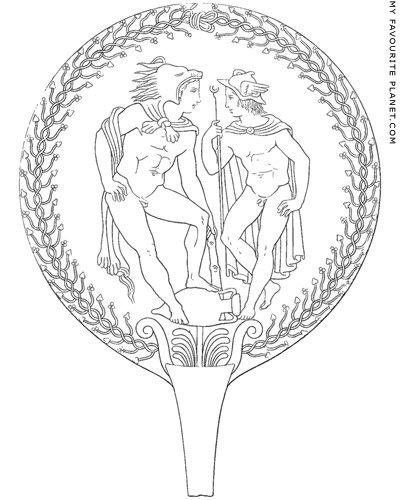
A similar depiction of Hercle and Turms, with their
positions reversed, engraved on the back of an
Etruscan bronze mirror in the National Archaeological
Museum, Naples. Hercle's left foot rests on an amphora.
From a book of prints from drawings of exhibits
in the Real Museo Borbonico, Naples, 1824. |
|
| |
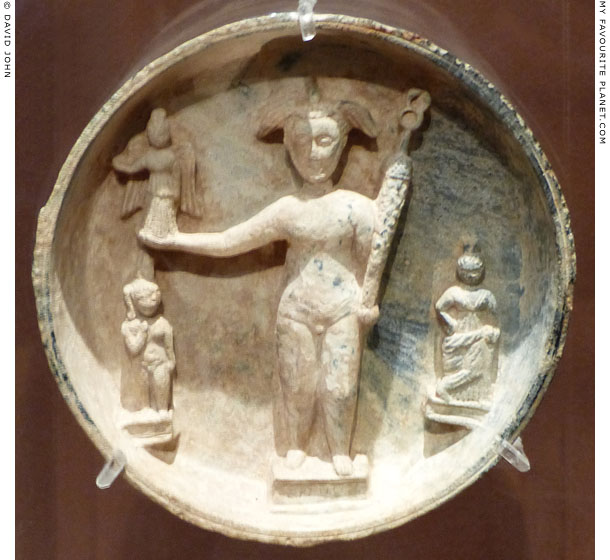
The inside of a steatite phiale (libation bowl) with a relief of a statue of Hermes
holding Nike (Victoria) in his outstretched hand. The plinth on which he stands
is inscribed ΕΡΜΗC (Hermes). Either side of him stand a female and male figure.
From Asia Minor, 2nd - 3rd century AD. Diameter 11.4 cm.
National Archaeological Museum, Athens.
Stathatos Collection. Inv. No. St. 198.
See: Pierre Amandry (editor), Collection Hélène Stathatos III. Objets Antiques
et Byzantins (1963), Cat. No. 198, page 276 onwards, and Plate XL. |
| |

Detail of a circular marble base, with an Archaistic relief
depicting Hermes, Apollo and Artemis around a flaming altar.
Roman Imperial period, 2nd century AD.
Salone, Palazzo Nuovo, Capitoline Museums, Rome.
Inv. No. MC1995. From the Albani Collection.
|
| Hermes, shown in profile walking on tiptoe to the left, holds a small kerykeion (caduceus) delicately between the forefinger and thumb of his raised right hand. He approaches a flaming altar, to the left of which can be seen the rear of the figure of Artemis who holds a long torch. On the other side of the base, between Artemis and Hermes, Apollo walks holding a bow and an arrow. The base has been used since the time it entered the museum as a pedestal for a black marble statue of "Zeus", Inv. No. MC655 (see Asklepios). |
|
| |
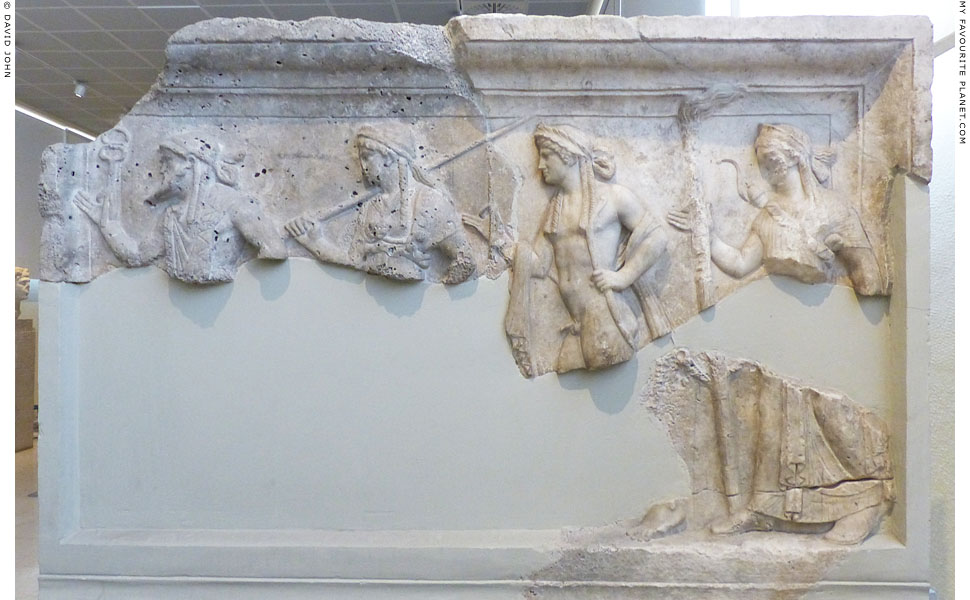
Fragments of a large Archaistic marble relief depicting
Hermes leading Athena, Apollo and Artemis in a procession.
From Piraeus, Attica, Greece.
Piraeus Archaeological Museum. Inv. Nos. 2087 and 2088. |
| |
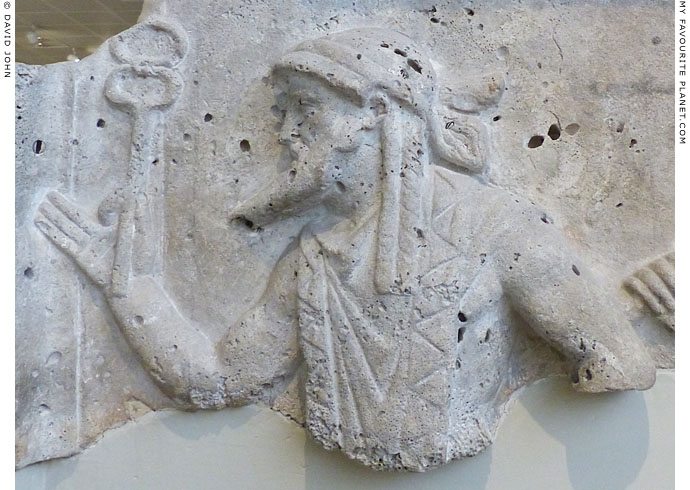
Hermes on the relief from Piraeus. With his long beard he
appears older than the other three youthful-looking deities.
See also Athena wearing the aegis and Gorgoneion
from this relief on the Medusa page. |
| |
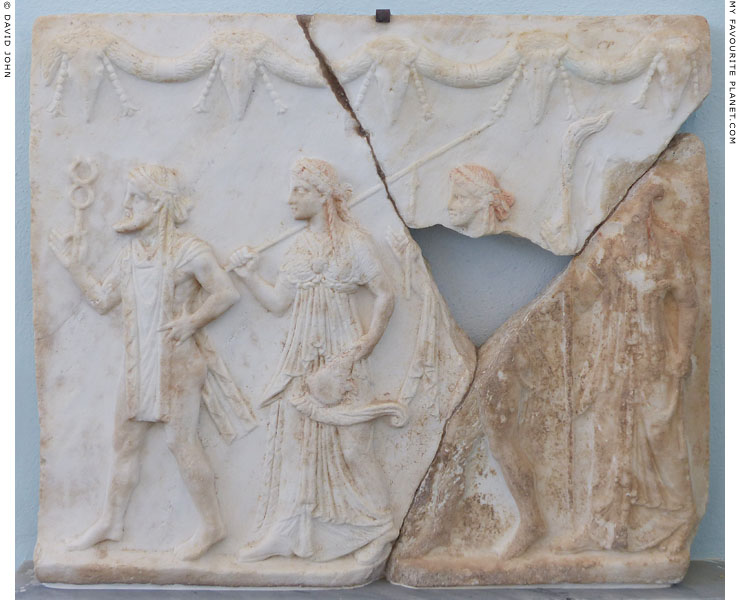
An Archaistic relief depicting Hermes leading Athena, Apollo and Artemis in a procession.
Above the figures hangs a row of five boukrania (ox skulls) hung with swags.
Second half of the 2nd century - early 1st century BC. From the House of the Lake, Delos.
The style of the relief and the pose and dress of the figures is similar to the
reliefs in Rome and Piraeus (see above), although not as finely executed.
Delos Archaeological Museum, Greece. Inv. No. A 9. |
| |
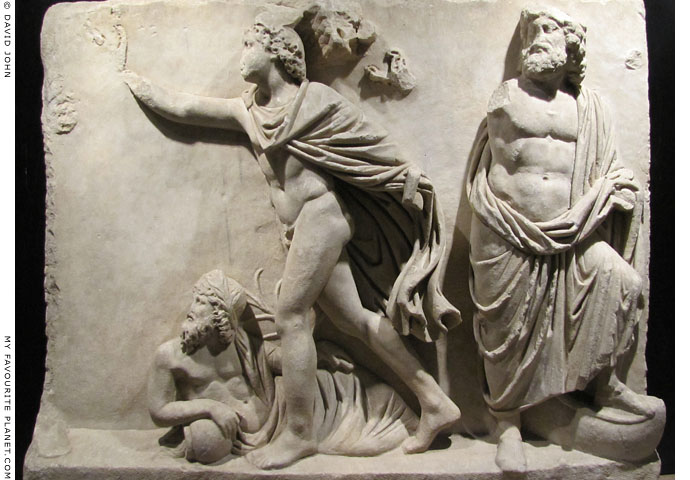
Marble relief of the gods Okeanos (god of the rivers), Hermes and Poseidon.
From Nikomedia (Izmit), Turkey. Roman Imperial period, 2nd century AD.
Istanbul Archaeological Museum. Inv. No. 5344 T. |
| |
| Hermes |
Hermes with the infant Dionysus
See other depictions of the infant Dionysus on the Dionysus page. |
|
 |
|
| |
 |
|
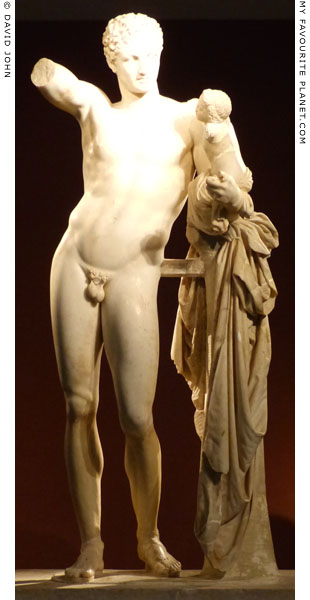 |
The statue of Hermes carrying the infant Dionysus in Olympia.
From the sanctuary of Zeus at Olympia, Peloponnese, Greece.
Parian marble. Height 213 cm (according to the museum label).
Olympia Archaeological Museum, Greece. Inv. No. D 176.
|
|
The statue of highly polished Parian marble was found on 8th May 1877, during excavations by German archaeologists led by Gustav Hirschfeld, in the remains of the Archaic temple of Hera, in the Altis, the sanctuary of Zeus at Olympia. Hermes' right foot was found on 23rd December 1879, and the head of the infant on 27th March 1880. The legs below the knees and left foot have been restored with plaster.
Hermes stands contrapposto, with his left leg bent and the back of the foot raised, so that his weight is supported by his straight right leg, the toes of the left foot and his left elbow, which rests on a tree stump. His torso leans to his left, towards the infant dionysus, who sits on his left forearm. His missing raised right hand is thought to have held a bunch of grapes, an allusion to Dionysus' later role as the god of wine, for which the missing left arm of the infant was reaching. In his left hand he may have been holding a kerykeion.
This may be the marble statue seen by Pausanias in the 2nd century AD (Description of Greece, Book 5, chapter 17, section 3), who wrote that it was made by Praxiteles (around 340 BC), although it is thought to be a Hellenistic copy. [9] It has also been argued that it may have been made during the Roman period, as late as the 1st century BC or even the 1st century AD.
According to one version of Greek myths about Dionysus, after his birth, Zeus ordered Hermes to take the infant to be raised secretly either by King Athamas and his wife Ino (Dionysus' aunt), or according to another version, to the Hyades, rain Nymphs of Nysa (a mythological place in Phoenicia, Arabia, Ethiopia or Libya). See the Dionysus page.
A bronze statue of Hermes holding the infant Dionysus made by Kephisodotos the Elder (around 400-360 BC) was mentioned by Pliny the Elder (see below).
According to Pausanias, a statue of Hermes of the Marketplace (Ἑρμῆς Ἀγοραῖος, Hermes Agoraios) carrying Dionysus as a child stood in the agora of Sparta (Description of Greece, Book 3, chapter 11, section 11). This statue may be represented on Spartan coins of the Roman Imperial period which show Hermes carrying the infant Dionysus on his left arm and holding a kerykeion in his left hand. He also wrote that among the many reliefs on the Throne of Apollo Amyklaios made by Bathykles at Amyklai, south of Sparta (around 550 BC), was an image of Hermes carrying the infant Dionysus to heaven (Book 3, chapter 18, section 11).
See also a mosaic showing Pan carrying the infant Dionysus in Istanbul. |
|

The head of the Hermes statue in Olympia. |
|
| |
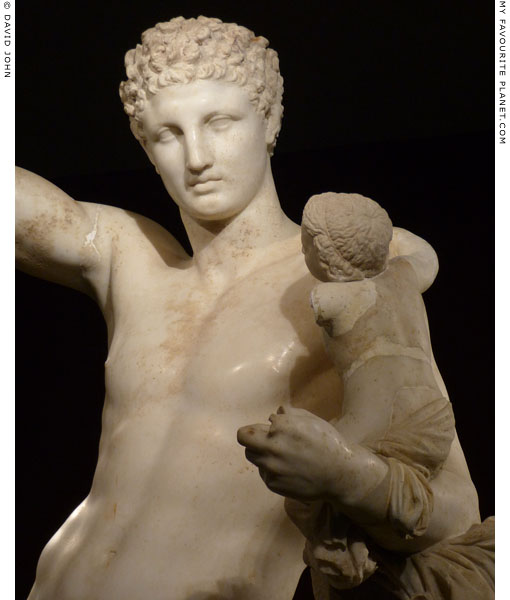
Hermes holding Dionysus on the statue in Olympia. |
|
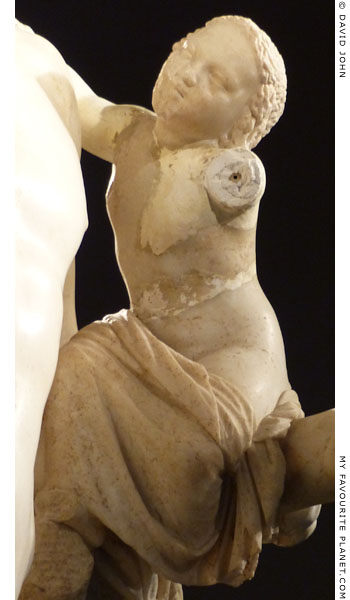
The infant Dionysus in Olympia |
|
| |
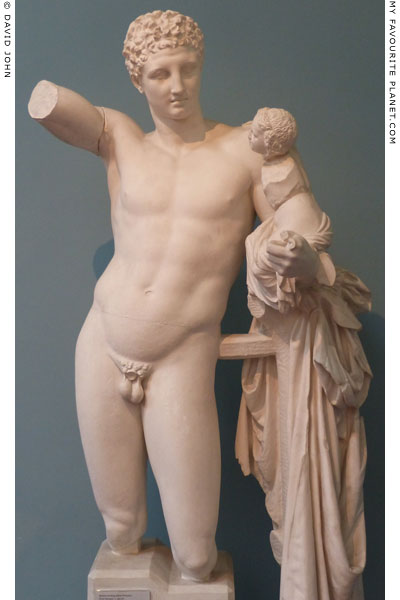 |
|
 |
A plaster cast of the statue of Hermes holding the infant Dionysus
from Olympia. One of the casts made soon after the statue was
discovered, and before the lower legs were restored.
Ashmolean Museum, Oxford. Inv. No. C113. |
|
| |
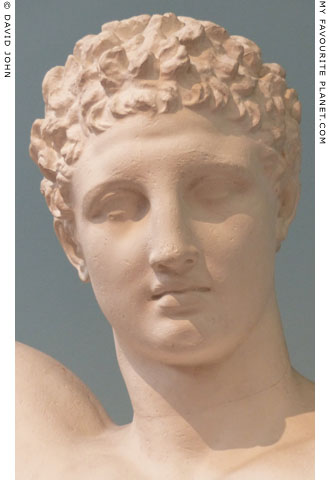
Head of the Ashmolean plaster cast of the
Hermes statue from Olympia (see above). |
|
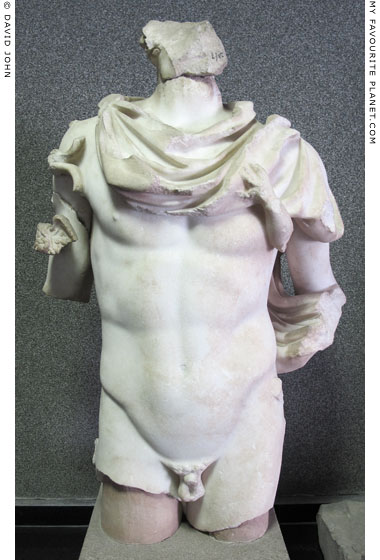
A marble torso of a statue of Hermes carrying the
infant Dionysus. From the Pergamon Asclepieion.
Roman period.
Bergama Archaeological Museum. |
|
| |
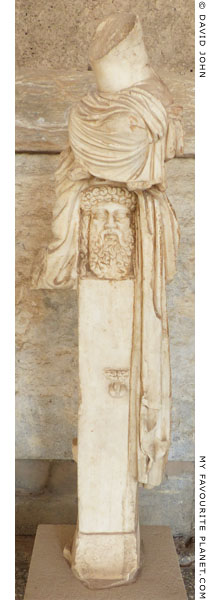 |
|
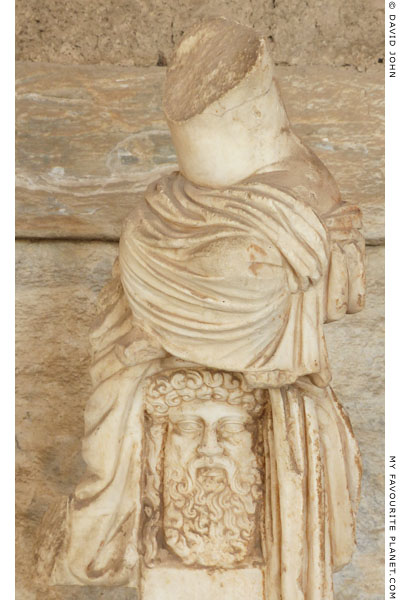 |
A marble herm of Hermes as a base for a statue of Hermes carrying the infant Dionysus.
Roman period copy, perhaps of a statue group by Kephisodotos the Elder (flourished
around 400-360 BC), thought to be the father or uncle of Praxiteles. His bronze
statue of Hermes holding the infant Dionysus was mentioned by Pliny the Elder:
"There were two artists of the name of Cephisodotus: the earlier of them made
a figure of Mercury [Hermes] nursing Father Liber [Dionysus] when an infant."
Pliny the Elder, Natural History, Book 34, chapter 19.
Museum of the Ancient Agora, Athens. Inv. No. S 33.
See more photos and information about herms on Pergamon gallery 2, page 15. |
|
| |
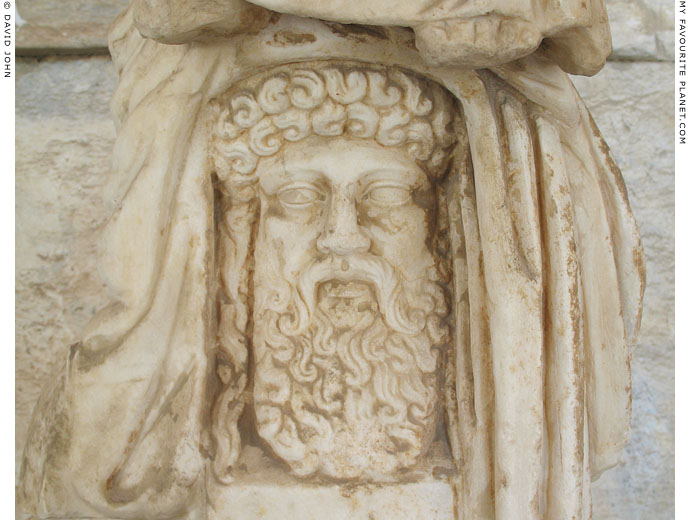
The head of Hermes on the herm base in the Athenian Agora above. |
| |
|
| |
A modern copy of a relief on a Late Hellenistic relief marble puteal (well-head;
Greek, περιστόμιον, peristomion) showing Hermes carrying the infant Dionysus,
followed by a dancing Maenad playing a tympanon and a Satyr playing a double
flute (aulos). In front of Hermes a seated Nymph, identified by some scholars
as Leucotoe, waits to receive the infant, holding out a cloth to cover him.
This copy, now in the Dresden State Art Collection (Staatliche Kunstsammlungen
Dresden, SKD), was made in Rome around 1870-1880, following the discovery
of the fragmentary original around 1867, during excavations by the teacher and
amateur archaeologist (or treasure hunter) Lorenzo Fortunati (1819-1886) in
Ariccia (Latium), 25 kilometres from Rome.
White, fine crystalline marble, probably from Carrara.
Height 82.5 cm, diameter 82.0 cm.
Skulpturensammlung, Albertinum, Dresden. Inv. No. ZV 4125.
Currently (2023) displayed in the "Gläsernes Depot" along with
several ancient sculptures and modern copies.
The copy is known to have been since 1905 in the garden of Ahlsdorf Palace
(Schloss Ahlsdorf), Brandenburg, home of the parents-in-law of the German
archaeologist Theodor Wiegand. It was acquired by the SKD in 1985.
The original puteal, thought to be of Pentelic marble and dated to the
4th - 3rd century BC, was formerly in the Palazzo Chigi, Rome, and
acquired by Pope Pius IX in 1872. It is now in the Galleria dei
Candelabri, Vatican Museums, Rome. Inv. No. 2576. [10] |
|
| |
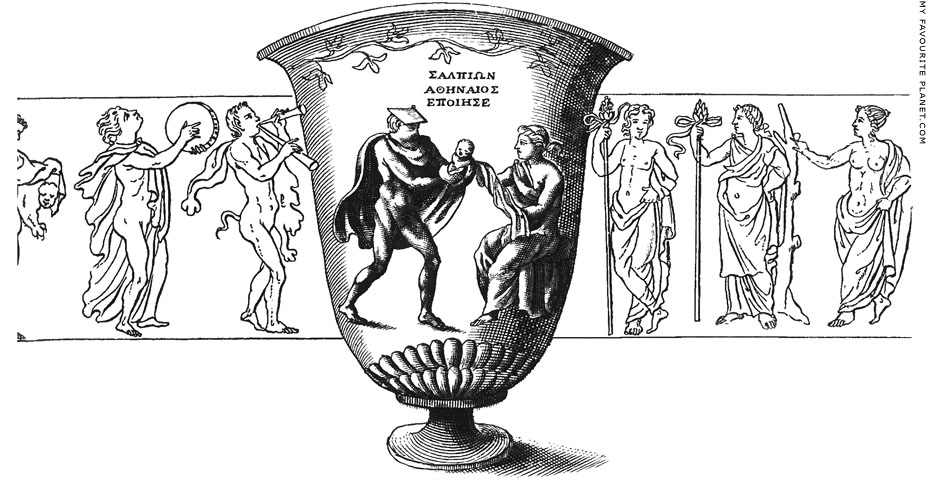
A relief of the same scene of Hermes carrying the infant Dionysus, flanked by Nymphs,
Maenads and Satyrs, on a large marble calyx krater found in the ruins of a seaside villa
at the site of ancient Formia (Greek, Ὁρμίαι, Hormiai, Landing Place), near Gaeta, Lazio,
Italy. In this engraving the other figures around the side of the vase are also shown.
The krater is signed by Salpion of Athens (Σαλπίων Ἀθηναῖος). It has
been variously dated from the late 2nd century BC to the 1st century AD,
perhaps after an original of around 330 BC. Height 127 cm, width 85 cm. [11]
National Archaeological Museum, Naples. Inv. No. 6673.
Image source: An engraving illustrating a dissertation on the vase by Jacob Spon
1647-1685), Sur un grande vase de marbre, representant la naissance de Bacchus.
In: Jacob Spon, Recherches curieuses d'antiquité, Vingt-neuviéme dissertation,
page 469. Chez Thomas Amaulry, Lyons, 1683. At the Internet Archive.
|
"It was found near Gaeta under the ruins of ancient 'Formia'; it stood for many years neglected and was thought worthless, while lying near the beach; mariners tied ropes round it, to fasten their boats, and that barbarous treatment defaced this monument for ever; it was after that period, removed from the sea side and used as a font in the cathedral at Gaeta [in the baptistery], and at length brought to the National Museum."
Museo nazionale di Napoli, Principal monuments in the National Museum of Naples, page 40 and plate 44 (see images, right and below). John Testa, Naples, 1882. At the Internet Archive.
Inscribed in Greek above Hermes, Dionysus and the Nymph is the artist's signature:
Σαλπίων Ἀθηναῖος ἐποίησε
Salpion the Athenian made this
Inscription IG XIV 1260.
This is one of only three surviving classical marble vases inscribed with an artist's signature. The other two are:
A large krater known as the "Amphora of Sosibios", circa 50 BC. Height 67 cm. Louvre, Inv. No. Ma 422.
A Neo-Attic fountain in the shape of a rhyton (drinking horn) by Pontios of Athens, late 1st century BC. Height 112 cm. Palazzo dei Conservatori, Capitoline Museums, Inv. No. 1101. |
|

A drawing of the krater by Salpion as
displayed in the Naples museum, standing
on an unrelated cylindrical marble altar
or puteal (well head), around the side
of which is a low relief of Zeus enthroned
and flanked by six other gods (see below).
National Archaeological Museum, Naples. |
|
| |
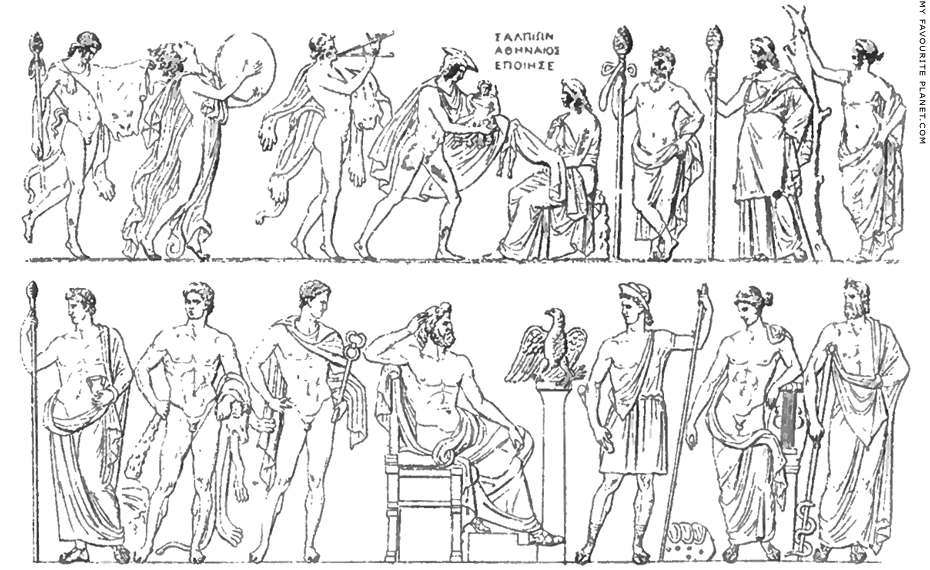
The top drawing shows the relief of Hermes handing over the infant Dionysus to
the Nymphs on the marble krater by Salpion. To either side of the three central
figures stand three "stock" figures, familiar members of Dionysus' thiasos.
The drawing below it shows the relief around the outside of the later and unrelated
cylindrical marble altar or puteal (well head) on which the krater was displayed in the
museum. In the centre Zeus sits enthroned, his symbolic eagle, clutching a thunderbolt
in its left talon, standing on a pillar to his right. He is flanked on each side by six male
deities, each depicted in a form known from extant classical statue types. To his left
stand Dionysus, Herakles, Hermes; to the right stand Ares, Apollo, Asklepios. Although
the object is shaped like a well head, the depiction of the gods has been taken as an
indication that it had a sacred function.
National Archaeological Museum, Naples. Inv. No. 6670. From the Farnese Collection. |
| |
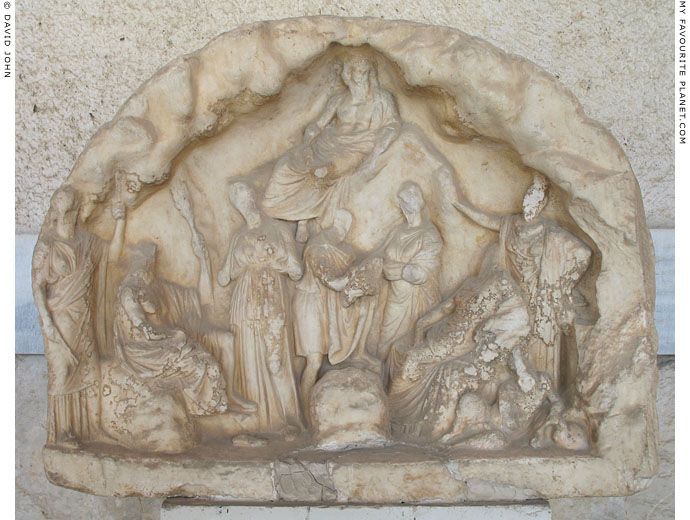
Inscribed marble votive relief thought to depict Hermes presenting
the infant Dionysus to a Nymph in a cave, witnessed by other deities.
From Athens. Dedicated to Pan and the Nymphs by Neoptolemos
of Melite, about 340-330 BC. Pentelic marble. Height 64.5 cm.
Museum of the Ancient Agora, Athens. Inv. No. I 7154.
Exhibited in the lower portico (ground floor) of the
Stoa of Attalus, in which the museum is housed.
|
Excavated in 1970 south of the Athenian Agora, in the remains of a Late Roman house on the north slope of the Areopagus. It is possibly from the Cave of Pan, above the the Klepsydra on the north slope of the Acropolis.
The relief is thought to have been deliberately mutilated, perhaps by Christians. The faces and objects held by most of the ten figures are missing, making identification difficult. The scene has been described simply as "ten figures watching or participating in a sacrifice in a cave". However, it has also been interpreted as Hermes bringing the infant Dionysus to safety and into the care of a Nymph (perhaps one of the Hyades or Ino). The figures have been identified (with some alternative identifications) by comparison with similar reliefs and other sculptures.
Zeus reclines on a rock above the other figures. Below him, from left to right: Persephone (Kore) standing; Dionysus (or Silenus?) seated, holding a thyrsos; Demeter standing (both arms missing), looking down at Dionysus; Hermes, holding the infant Dionysus in both arms, his left foot resting on a rock behind an altar so that his raised left knee can support the infant; a Nymph facing him receives the infant; Apollo (or a Nymph) seated, facing left; Artemis (or a Nymph) stands behind him with her right arm raised; Pan sits below them with a wineskin. There may have been another figure, perhaps a Nymph, on the broken right side of the relief.
The figures thought to be Nymphs (including the supposed Apollo and Artemis) have been described as smaller in scale than the others. But the only figure who appears smaller is the supposed Hermes, who is half a head shorter than the female figure facing him. It seems unlikely that this figure could be the dedicator of the relief, as in such reliefs mortal worshippers are usually shown considerably smaller and separated from deities, usually standing on the edge of the scene (see, for example, reliefs on the Pan page).
Two of the few artworks to show a mortal among gods are the much later Apotheosis of Homer (3rd or 2nd century BC) and the so-called "Ikarios reliefs" (perhaps 2nd century BC).
The inscription on the lower border of the relief is a dedication by Neoptolemos, son of Antikles, of the Attic deme of Melite, thought to be the wealthy Athenian citizen known from literary sources and other inscriptions.
[Νεο]πτόλε[μος] [Ἀν]τικλέ[ους] [Με]λιτε[ὺς] [ἀν]έθη[κεν]
Inscription IG II(2) 4901. |
|
| |
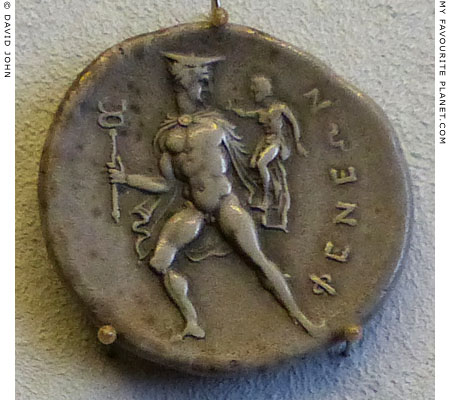
A silver stater of Pheneos showing Hermes
carrying the infant Arkas. Circa 360-340 BC.
Numismatic Collection, Bode Museum, Berlin.
|
Hermes, nude except for a petasos and a chlamys (short cloak), holds a kerykeion in his right hand and the infant Arkas in the left. He moves to the left, his head turned back to the right to look at Arkas, who raises his right hand towards Hermes' face. On the right is the inscription ΦΕΝΕΩΝ.
Pheneos (Φενεός, Feneos) was a city in Arcadia, northeastern Peloponnese, Greece. Today it is in the Prefecture of Corinthia. It stood at the foot of Mount Kyllene, the mythical birthplace of Hermes, was an important cult centre for the god, and the location of an annual festival of the Hermaea. It also had sanctuaries for Demeter and Asklepios.
The obverse side of the coin shows the head of Demeter (see the photo of another coin of this type in Demeter part 2).
In mythological tales similar to those concerning Hermes and the infant Dionysus, the messenger god also rescued Arkas, the son of Zeus and the Nymph Kallisto (and therefore his half-brother). After either Artemis or Zeus' jealous wife Hera had turned Kallisto into a bear, Zeus asked Hermes to take the infant Arkas (Αρκάς; from Arktos, bear) to safety at the home of his mother Maia on Mount Kyllene. Arkas became king of Arkadia, which was named after him, and taught people the art of weaving and bread-baking. Zeus later transformed Kallisto and Arkas into the constellations Ursa Major (Great Bear) and Ursa Minor (Little Bear). |
|
| |
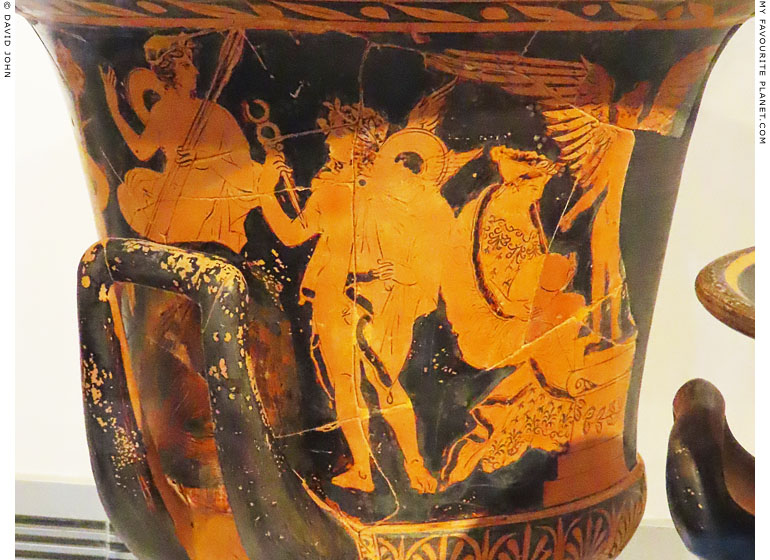
Detail of an Attic red-figure calyx-krater with a depiction of Leda (right), seated, and in her lap
a large egg from which Helen of Troy will be hatched (see The Dioskouroi). Eros, as a winged
youth, stands to the right. In the centre stands Hermes, naked apart from a short cloak and a
winged hat hanging behind his shoulders. In his right hand he holds a kerykeion (caduceus).
Around 420-400 BC. Found in Ierissos (Ιερισσός; ancient Akanthos, Ἄκανθος), Halkidiki, Macedonia
(see History of Stageira and Olympiada - Part 1). Restored from several fragments.
Thessaloniki Archaeological Museum.
|
There are several versions of the Greek myths concerning Leda (Λήδα), wife of King Tyndareos of Sparta (Τυνδάρεως), and the beautiful Helen (Ἑλένη), later to become known as "Helen of Troy". The best-known version is that Zeus took the form of a swan in order to have sex with Leda, and on the same night she also slept with her husband. The result was the conception and birth of two sets of twins: Kastor and Polydeukes (the Dioskouroi); and Klytaemnestra (Κλυταιμνήστρα), who was to become the wife (and then murderer) of Agamemnon, and Helen, who was to marry Agamemnon's brother Menelaos, and then became the cause of the Trojan War (see Homer part 2). Leda's children are said to have hatched from one or more eggs.
In other versions, it was Nemesis (Νέμεσις), the goddess of retribution, who was raped or seduced by Zeus as a swan and produced an egg from which Helen hatched. The egg was then found by or given to Leda, who became Helen's nurse. In the Poeticon astronomicon (Poetical Astronomy, also known as De Astronomia, On astronomy), conventionally attributed to the Roman mythographer Hyginus (see note in Homer part 2), Hermes takes on the task of delivering the egg to Leda's safekeeping. Although the reason for this is not stated, perhaps it was similar to that which caused the infant Dionysus to be secretly placed in the care of the Nymphs: fear of vengeance by Zeus' jealous wife Hera on his illegitimate offspring.
"Constellation Swan (Cygnus).
When Jupiter [Zeus], moved by desire, had begun to love Nemesis, and couldn't persuade her to lie with him, he relieved his passion by the following plan. He bade Venus [Aphrodite], in the form of an eagle, pursue him; he, changed to a swan, as if in flight from the eagle, took refuge with Nemesis and lighted in her lap. Nemesis did not thrust him away, but holding him in her arms, fell into a deep sleep. While she slept, Jupiter [Zeus] embraced her, and then flew away. Because he was seen by men flying high in the sky, they said he was put in the stars. To make this really true, Jupiter put the swan flying and the eagle pursuing in the sky.
But Nemesis, as if wedded to the tribe of birds, when her months were ended, bore an egg. Mercurius (Mercury = Hermes] took it away and carried it to Sparta and threw it in Leda's lap. From it sprang Helen, who excelled all other girls in beauty."
Pseudo-Hyginus, Astronomica, 2. 8, translated by Mary Grant. At the Theoi Project. |
|
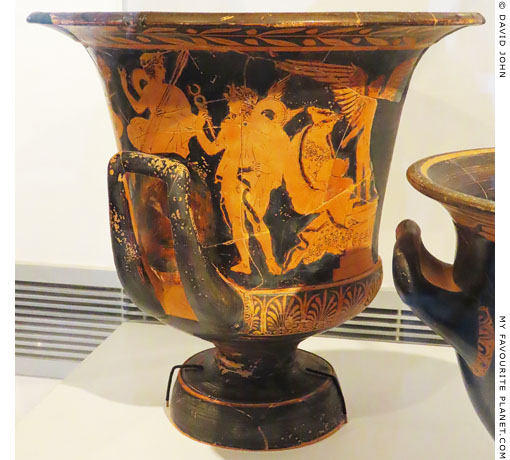
The Leda krater in Thessaloniki. |
|
| |
| Hermes |
Inscriptions and dedications to Hermes |
|
 |
|
| |
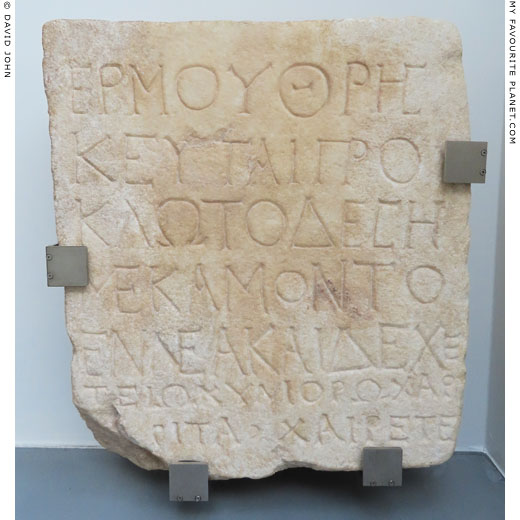
Part of an inscribed funerary stele set up by an association of votaries of Hermes
for one of its members named Proklos (Πρόκλος), who died at the age of 19.
Ἔρμου θρησ
κευ ται Προ
κλω το δεση
μεκαμοντο
εννεα και δεχε
τειωχυλιορωχαε
ριτα χαιρετε
Roman Imperial period. Found in the cemetery of Akanthos (Ἄκανθος; Latin,
Acanthus; near modern Ierissos, Ιερισσός) on the west coast of Halkidiki,
Macedonia, Greece (see History of Ancient Stageira parts 1-3).
Polygyros Archaeological Museum. Inv. No. 1.138.205. |
| |
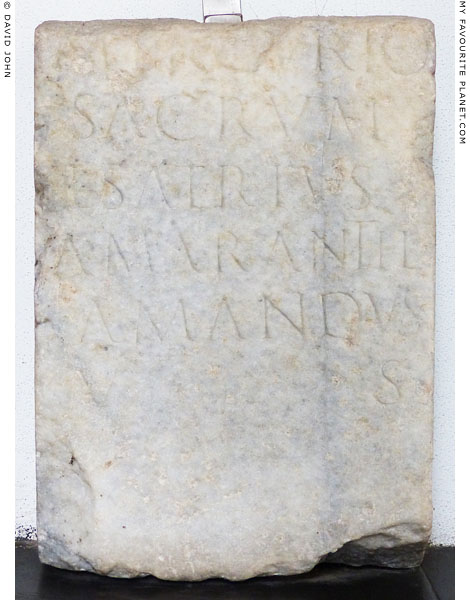
An inscribed marble tablet with a dedication to Mercury.
Candoglia marble. 1st century AD. Thought to have been found
at the church of Santo Stefano, Milan (ancient Mediolanum).
The ex-voto dedication to Mercury was made by the freedman
Lucius Satrius Amandus in thanks for the granting of a request.
Mercurio
sacrum
L(ucius) Satrius
Amaranti l(ibertus)
Amandus
v(otum) s(olvit)
Civic Archaeological Museum, Milan. Inv. No. A 0.9.11008. |
| |
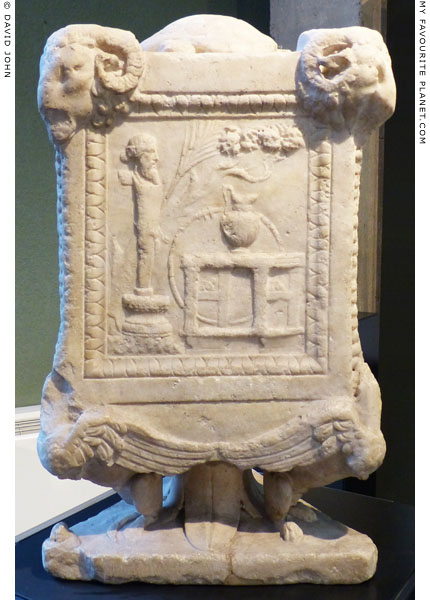
A triangular marble base dedicated to Mercury.
Mid 1st century AD. Origin unknown, possibly from the
ancient Roman city Mediolanum (Milan). Height 62 cm.
Civic Archaeological Museum, Milan. Inv. No. A 0.9.1072.
|
The base, thought to have originally stood in a sanctuary of Mercury, supported an offering of a large tripod and gold serpents weighing five Roman pounds (1650 grams). The base is supported at each of the three corners by an eagle with outstretched wings, and in the centre by a lotus blossom (symbols of Zeus/Jupiter). Above each corner is a ram's head, and on the top stands a tortoise. On one side is a dedicatory inscription by Sextus Veracilius, a member of the college of four magistrates in charge of the administration of justice (iure dicundo), the supply of foodstuffs and public works:
Mercurio
Sex(tus) Veracilius
Sex(ti) F(ilius) Ouf(entina tribu)
Priscus IIII vir i(ure) d(icundo)
ex voto don(o) ded(it)
dracones aureos
libr(arum) quinque
adiectis ornament(is)
[e]t cortina On the other two sides are reliefs:
The relief in the photo above depicts a bearded herm of Mercury or Dionysus/Bacchus in front of a table on which stands a jug for libations or as a prize for a contest, suggested by the victory palm above. Behind the table is a trochus, a large circle with rings, a gymnastic apparatus which was turned with a pole. The tripod, victory palm and trochus indicate that the monument honoured Mercury as the protector of athletic games.
The relief on the other side (see photo below) depicts a herm of Mercury (without a beard), the head draped with a cloth which hangs from a tree, with a ram and a caduceus beside it. |
|
| |
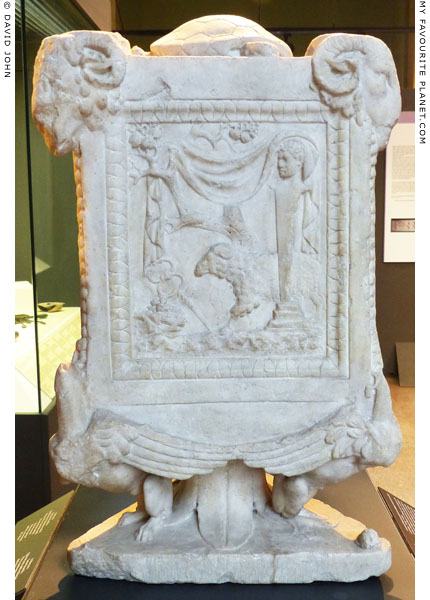
The relief on one of the other sides of the
triangular base dedicated to Mercury in Milan. |
| |
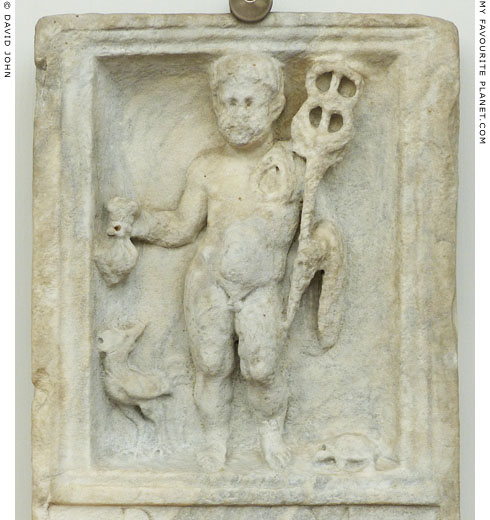
Relief on the top of the inscribed funeral stele of Sextus Rufius Achilleus,
who died at the age of 7 years and 9 days. The deceased child is
depicted as Hermes, with a chlamys, caduceus and a purse. To the left
is a cockerel, and to the right a tortoise.
"To the divine Spirits, to Sextus Rufius Achilleus. He lived seven months,
nine days. Sextus Rufius Decibalus made this for his sweetest son."
Inscription CIL VI, 25572.
100-150 AD. Unknown origin. It has been suggested that the child's father
Decibalus may have been a freed slave from Dacia (today Roumania).
Baths of Diocletian, National Museum of Rome. From the Kircherian Museum. |
| |
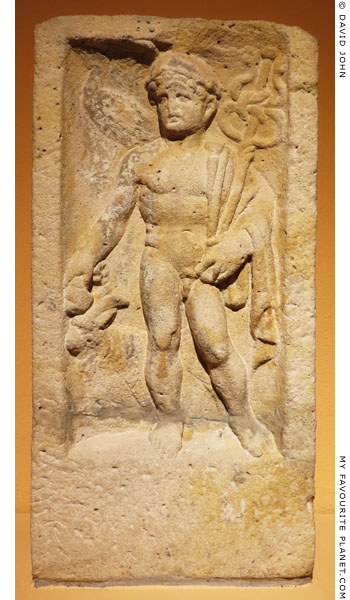
A sandstone votive relief of youthful Mercury.
Roman. 2nd - 3rd century AD. From Speyer
(ancient Noviomagus / Civitas Nemetum,
Germania Superior), Rheinland-Pfalz, Germany.
Height 58 cm, width 30 cm, depth 11 cm.
The god stands naked, his head facing slightly
to the left. He wears a winged cap, and a cloak,
draped over his left shoulder and arm. In his left
hand he holds a caduceus, around which two
entwined snakes are joined in the middle by a
knot, their heads rising to either side of the top
of the staff. He also holds one or two other
objects resembling pipes. In his lowered right
hand he holds a purse, below which stands
a male goat. Behind his right shoulder, in much
shallower relief, is a bird, thought to be a cockerel.
If there was originally a dedicatory inscription
below the relief it is no longer visible.
Historisches Museum der Pfalz, Speyer, Germany.
Inv. No. 1927/34.
See other Roman reliefs from Rheinland-Pfalz:
A relief from Rheinzabern depicting Mercury
with four other gods, on the Hephaistos page.
A relief of one of the Dioskouroi from Speyer. |
|
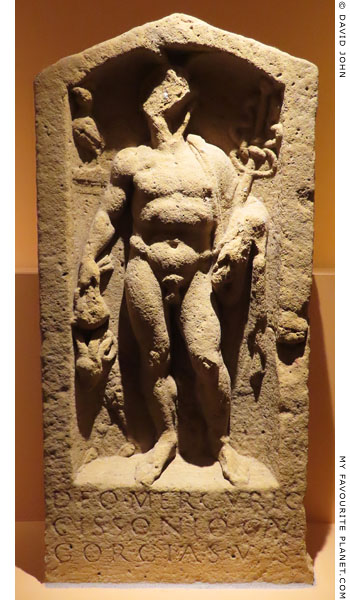
A sandstone votive relief of Mercury
with a dedication to Mercury Cissonius.
Roman. Late 2nd century AD. From Rheinzabern
(ancient Rhenanae Tabernae, Germania Superior),
Kreis Germersheim, Germany. Height 107 cm,
width 53 cm, depth 14 cm.
Historisches Museum der Pfalz, Speyer, Germany.
The Celtic god Cissonius, whose name has been
interpreted as courageous, remote or carriage
driver, became identified with Mercury under
Roman occupation, and he may also have been
associated with trade and the protection of
travellers. Dedications to him have been found
in France, Germany and Switzerland. He was
also depicted as bearded and helmeted, riding
a ram and carrying a wine cup.
The iconography of the relief is almost the same
as that from Speyer in the photo, left. However,
the image is in higher relief, and here a ram is
shown standing to the left of the god. The bird
next to his right shoulder stands on a ledge, and
resembles a crow more than a cockerel. On the
tabula below the relief is a dedicatory inscription:
DEO MERCURIO
CISSONIO C[aius] ATU[lius?]
GORGIAS V[otum] S[olvit]
To the God Mercurius
Cissonius. C[aius] Atu[llius?]
Gorgias [has] fulfilled [his] vow.
Inscription CIL XIII, 6085
at Epigraphik-Datenbank Clauss / Slaby (EDCS). |
|
| |
| Hermes |
Hermes, Io and Argos |
|
 |
|
| |
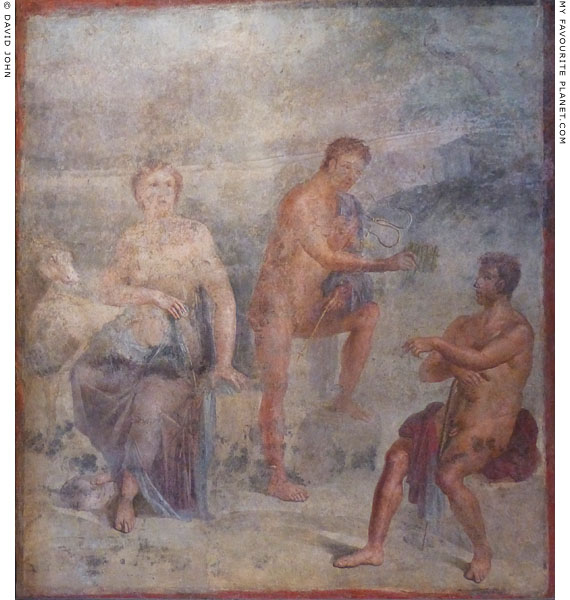
Fresco depicting Io, Hermes and Argos Panoptes.
From the central area of the north wall of the ekklesiasterion in the
Temple of Isis, Pompeii. 1st century AD. 4th Pompeian style (62-79 AD).
National Archaeological Museum, Naples. Inv. No. 9548 (Cat. 1.69).
|
As with other Greek myths, there are several versions of the story of Io (Ἰώ). She was a Nymph and/or a priestess of the goddess Hera in the Argolid (northeast Peloponnese) who became a reluctant lover of Zeus. He transformed her into a heifer in order to hide her from his jealous wife Hera (in another version Hera transformed her). Seeing through the ruse, Hera sent the never-sleeping, hundred-eyed giant Argos Panoptes (Ἄργος Πανόπτης, Argos the All-seeing) to watch her and prevent Zeus from visiting her.
Not to be outwitted, Zeus sent Hermes to kill Argos by first lulling him to sleep with the enchanting music of the syrinx (Pan pipes) and telling stories, or by charming him with his kerykeion (caduceus). Hera honoured her watchman by putting his eyes on the tails of the peacock, her sacred bird. Hermes earned the epiphet Argeiphontes (Ἀργειφόντης, Argos Slayer), first mentioned by Homer (Iliad, Book 2, line 103). [12]
In the fresco, Io, seated left, is shown in human form but with small horns. Argos, also in human form and naked, sits on the right with a red cloak and a stick. Hermes, in the centre holding his kerykeion in his left arm, bends forward to offer Argos the syrinx. In the background, right, the Argolid temple of Hera stands on a hill. [13] Depictions of this scene are thought to have been influenced by a work of the 4th century BC Athenian painter Nikias.
This myth is thought to be the origin of Hermes' epiphet Argeiphontes (ἀργεϊφόντης), Slayer of Argos, first mentioned by Homer in The Iliad and The Odyssey. However, it has been suggested that the word originally had a different meaning, perhaps Swift-appearing or Sky-clearing, but that the meaning and possibly another myth associated with it was lost, and a new etymology and associations were invented. [14]
See also the painting Mercury and Argus by Rubens below. |
|
| |
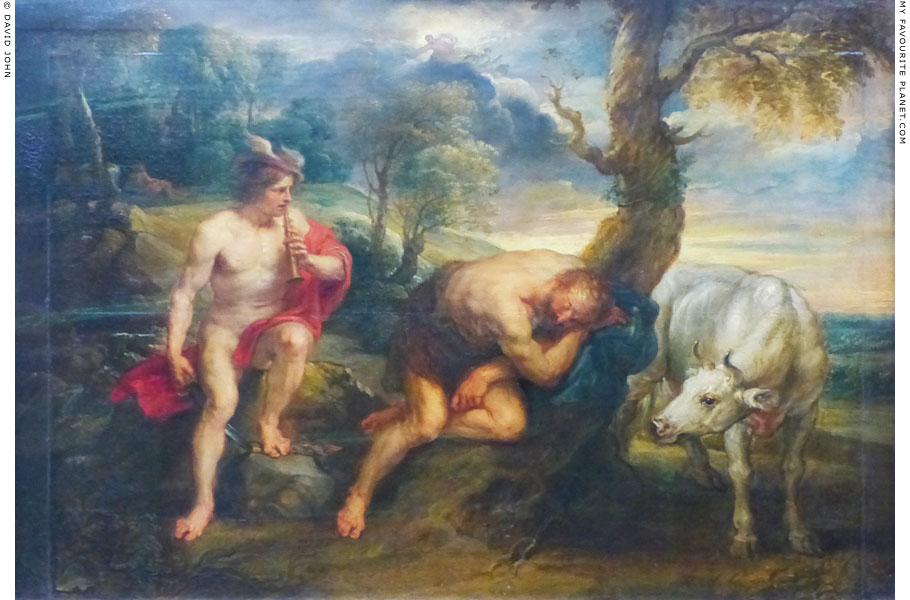
Mercury and Argus by Peter Paul Rubens (1577-1640).
Oil on oak panel, circa 1635/1638. Height 63 cm, width 87.5 cm.
Old Masters Gallery (Gemäldegalerie Alte Meister), Semperbau, Dresden. Inv. No. 962 C.
Purchased in Paris in 1742 from the art dealer Noel Araignon.
|
Mercury, with winged cap and red cloak, lulls the all-seeing Argus to sleep with the music of his pipe or flute, while Io, transformed into a white cow by Zeus, looks on. High above the idyllic pastoral landscape, Zeus is already on his way to his date with Io, driving through stormy clouds in a chariot drawn by two eagles.
The painting appeared on a 15 pfennig postage stamp of the German Democratic Republic (Deutsche Demokratische Republik, DDR), issued on 28th June 1977 to commemorate Rubens' 400th birthday, and to earn hard currency from stamp collectors worldwide.
The story of Hermes and Argos was also depicted by other artists, including Jakob Jordaens around 1620 (Musée des Beaux-Arts, Lyons), Diego Velazquez in 1659 (Museo del Prado, Madrid) and Barent Fabritius in 1662 (Gemäldegalerie alte Meister, Museumslandschaft Hessen Kassel, Inv. No. GK 262).
Rubens had already painted Juno and Argus around 1611, depicting Juno (Hera) with her retinue, collecting the head of the decapitated Argos, whose many eyes were to appear on the tail of the peacock, her symbolic animal (Wallraf-Richartz-Museum, Cologne, Inv. No. WRM 1040). |
|
| |
| Hermes |
The Judgement of Paris |
|
 |
|
| |
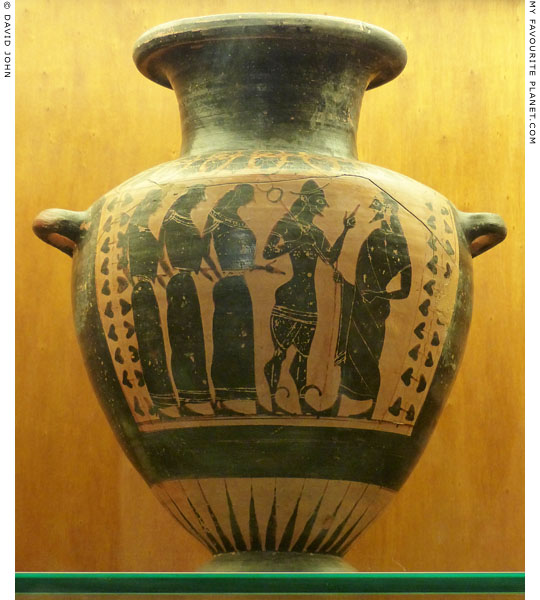
An Attic black-figure hydria (water jar) with a depiction of a scene
from the myth of the Judgement of Paris. Around 550-540 BC.
Paris, right, is approached by Hermes, leading Athena, Hera and Aphrodite.
Palazzo dei Conservatori, Capitoline Museums, Rome. Inv. No. 59. |
| |
The wedding of Peleus and Thetis, the future parents of the Homeric Greek hero Achilles, was attended by all the gods except Eris (Ἔρις, Discord, Strife; Roman equivalent, Discordia), the goddess of Discord, who was not invited. She nevertheless appeared at the wedding feast and stirred up trouble by encouraging the rivalry between Hera, Athena and Aphrodite by offering the Golden Apple from the Garden of the Hesperides (referred to by later writers as the Golden Apple of Discord, μῆλον τῆς Ἔριδος) as the prize for the most beautiful of the three goddesses. To settle the matter, it was decided to hold a beauty contest between the three.
Wishing to avoid the risk of angering any of the females, Zeus refused to judge the competition, and the task was given to Alexander (Ἀλέξανδρος, Alexandros), the mortal son of King Priam of Troy, who had been secretly raised and renamed Paris (Πάρις) by the Trojan herdsman Agelaos (see Homer part 2). Hermes led the three goddesses to Paris who was herding animals on Mount Ida, near Troy (Ilion), and ordered him to judge which of them was the most beautiful.
Hera and Athena attempted to bribe Paris with power, wealth and fame, but Aphrodite, the goddess of love and beauty, promised him the love of the most beautiful woman in the world. He chose Aphrodite, and his decision eventually led to him falling in love with and abducting Helena (Ἑλένη, Eleni, later known as Helen of Troy), the wife of Menelaos, king of Sparta. This affront was used as a pretext by Agamemnon, Menelaos' brother, to gather an army of Greek allies and wage war against Troy.
The Roman mythographer Hyginus (see the note in Homer part 2) summarized the story:
"Jove [Zeus] is said to have invited to the wedding of Peleus and Thetis all the gods except Eris, or Discordia. When she came later and was not admitted to the banquet, she threw an apple through the door, saying that the fairest should take it. Juno [Hera], Venus [Aphrodite], and Minerva [Athena] claimed the beauty prize for themselves. A huge argument broke out among them.
Jupiter ordered Mercury [Hermes] to take them to Mount Ida to Paris Alexander, and bid him judge. Juno promised him, if he should judge in her favour, that he would rule over all the lands and be pre-eminent wealth. Minerva promised that if she should come out victorious, he would be bravest of mortals and skilled in every craft. Venus, however, promised to give him in marriage Helen, daughter of Tyndareus, most beautiful of all women.
Paris preferred the last give to the former ones, and judges Venus the most lovely. On account of this, Juno and Minerva were hostile to the Trojans. Alexander, at the prompting of Venus, took Helen from his host Menelaus from Lacedaemon to Troy, and married her. She took with her two handmaids, Aethra and Thisiadie, captives, but once queens, whom Castor and Pollux [the Dioskouroi] had assigned to her."
Hyginus, Fabulae, sections 50-99, section 92, Judgement of Paris. At the Theoi Project.
In this myth Hermes fulfills his duties as a messenger of the gods as well as intermediary between gods and mortals. Although not much has been made of his other functions in this context, he was also the god of herdsmen and shepherds (see Hermes Kriophoros above) which made him the natural choice as the deity chosen to approach Paris in this matter.
The myth of the Judgement of Paris is in itself a good yarn with more than one moral, and includes narrative strands of several ancient tales describing chains of cause and effect in the affairs of mortals influenced by those of the gods. Such stories provided the core of ancient Greek religion, mythology, literature and art, and they were continually developed, reworked and embellished by poets, dramatists and artists into Roman times.
Helena was a sister of the Dioskouri. |
|
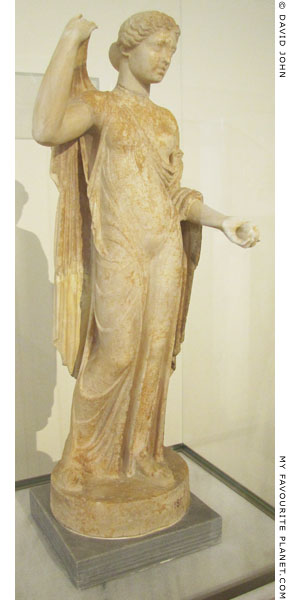
A marble statuette of the "Venus Genetrix"
type, depicting Aphrodite holding out an
apple with her left hand. The type is
thought to have been inspired by a
bronze statue made by Kallimachos
around 410 BC (Classical period),
depicting her either as a goddess of
vegetation and fertility or a participant
in the Judgement of Paris. She wears a
long chiton (tunic), with her left shoulder
and breast bare, and a himation (cloak),
an edge of which she lifts over her right
shoulder with her right hand.
1st century AD, Roman Imperial period.
Found in the sanctuary of Apollo Maleatas
(Ἀπόλλων Μαλεάτας), on the slope of
Mount Kynortion, east of the Sanctuary
of Asklepios at Epidauros. Height 55 cm.
The statue has been restored: the head
has been reattached, and the arms and
part of the himation have been restored
with plaster.
National Archaeological Museum,
Athens. Inv. No. 1811. |
|
| |
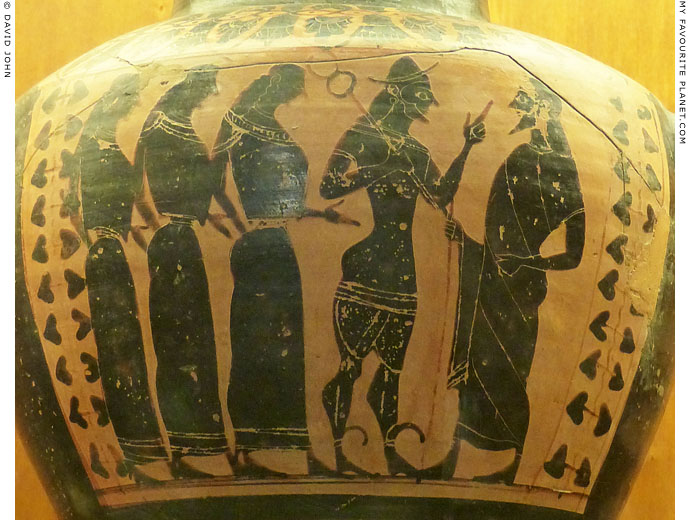
Detail of the painting of the Judgement of Paris on the hydria above.
See a fragment of a relief from Delphi below, with Hermes
in a scene thought to depict the Judgement of Paris, and a
relief of the Judgement of Paris in the Palazzo Altemps, Rome. |
| |
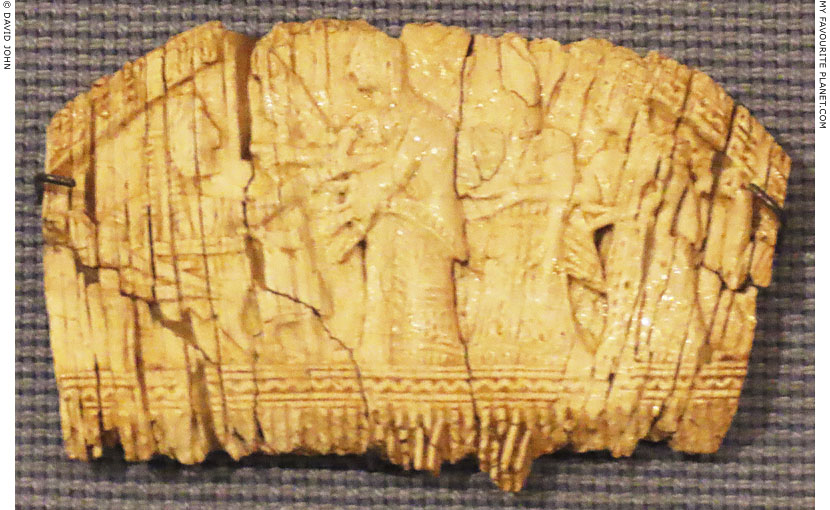
A fragment of an Archaic Laconian ivory comb with a relief depicting the Judgement of Paris.
Around 630-600 BC. Excavated at the Sanctuary of Artemis Orthia in Sparta. Width 8 cm.
National Archaeological Museum, Athens. Inv. No. 15368. |
| |
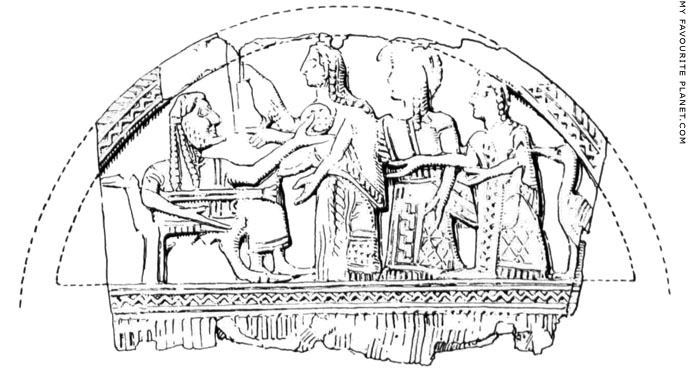
A drawing of the relief of the Judgement of Paris on the Laconian ivory comb.
|
This is one of the oldest depictions of the Judgement of Paris so far found, although Hermes is not included in the small carving. The three goddesses in the beauty contest stand facing Paris, the judge, who is seated on the left. In front is Aphrodite holding a dove, one of her attributes. Athena, in the centre, wears her crested helmet. In the rear Hera is followed by a long-necked bird, either her symbolic peacock or a water fowl. Alternatively, Hera may be in front with a cuckoo, and Aphrodite last with a goose. The bearded Paris holds out the Golden Apple from the Garden of the Hesperides as the prize for the goddess he must judge to be the most beautiful. However, the interpretation of the "large spotted sphere" in this drawing as an apple has been challenged.
The carving on the other side of the comb shows two sphinxes holding a male figure upside down in their claws. It has been suggested that the image may be a comment on the consequences of Paris' decision, which led to the Trojan War.
It is clear from looking at this small artwork that is was originally a wonderfully detailed tiny masterpiece, with many painstakingly executed details which the millenia have worn away. Most photos (including this one) do not do it justice. Luckily for us, someone studied and drew the object over a century ago.
For some reason this and several other fascinating small Archaic objects of ivory and bone from a number of locations in the Peloponnese are displayed in the museum in a case (number 54), which an information board informs visitors contains "small artefacts from the sanctuary at Perachora", i.e. the Sanctuary of Hera at Perachora, near Corinth. However, some of the artefacts, such as this one, are certainly not from Perachora, but there is no distinction or further information on the (very old) labelling. Still, it is always wonderful to see these invaluable works of art.
Image source (drawing): Richard MacGillivray Dawkins (editor), The Sanctuary of Artemis Orthia at Sparta, excavated and described by members of the British School at Athens, 1906-1910, Plate 127 and text on page 223. The Society for the Promotion of Hellenic Studies, Supplementary Paper No. 5. Macmillan, London, 1929. At the University of Chicago Library.
See also:
An ivory comb from the sanctuary with a carving of the suicide of Ajax in Homer part 2.
Early depictions of Gorgons from the sanctuary in Medusa part 2.
Other objects considered to show the earliest known depictions of the Judgement of Paris include:
The "Chigi vase", a fragmentary Late Protocorinthian olpe (jug), around 640 BC, with fragments of the Judgement scene. National Etruscan Museum, Villa Giulia, Rome. Inv. No. 22679.
A polychrome crateroid-amphora, in the Melian (Cycladic) style, thought to have been made in a Parian workshop. 7th century BC. The bold painting on the body of the amphora shows three goddesses walking in line behind a male figure, presumably Hermes, who is unusually accompanied by a lion. Paros Archaeological Museum. Inv. No. 2652. |
|
| |
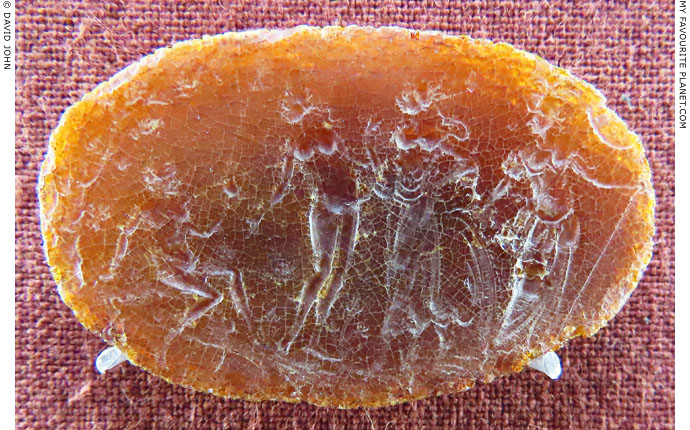
A carnelian gemstone engraved with a depiction of the Judgement of Paris.
On the left Paris, in heroic nudity, sits on an ill-defined seat on which he rests his
right hand, facing right. With his left hand he holds up the Golden Apple. On the
right stand the three goddesses, awaiting his judgement on which of them is the
most beautiful. They are depicted in forms known from ancient statues and other
artworks. The leftmost is Aphrodite, posing nude, holding a wreath in her right
hand. In the centre, Hera, wearing an elegant, transparent dress, appears to
be dancing or stepping towards Paris. On the right Athena wears a helmet,
cuirass and long chiton (tunic). In her left hand she holds a spear and with her
right hand she supports a large round shield which stands upright on the ground.
It appears that in the museum the gem is displayed with the reverse side
visible, so that the image is seen mirrored. [15]
Roman Imperial period. Height 2.2 cm, width 4.2 cm.
Numismatic Museum, Athens.
Formerly in the National Archaeological Museum, Athens. Inv. No. 881.
From the collection of Konstantinos Karapanos (Κωνσταντίνος Καραπάνος, 1840-1914). |
| |
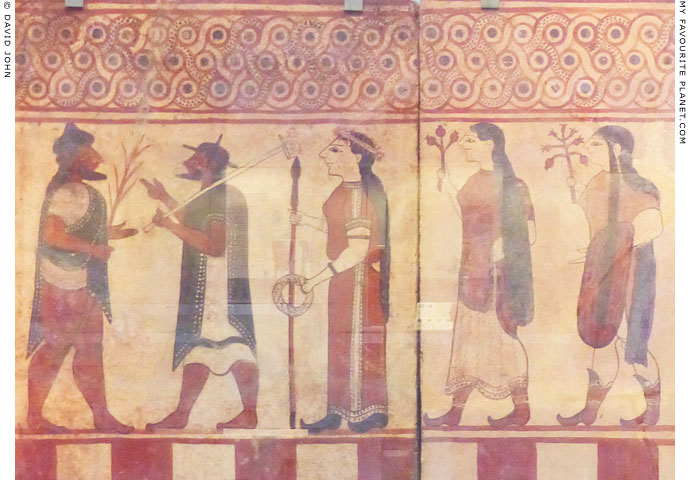
Etruscan terracotta plaques, around 560-550 BC, showing a scene from the Greek myth
of the Judgement of Paris. Paris, left, is approached by a procession of gods (left-right):
Hermes (known to the Etruscans as Turms), Athena, Hera and Aphrodite.
Height 98 - 102 cm, width of each of the three middle panels 56 - 57 cm.
British Museum. GR 1889,0410.1-5 (Paintings 5a-e).
|
From a series of five painted terracotta plaques from a small Etruscan chamber tomb in the Banditaccia cemetery, Cerveteri (ancient Caere), Tuscany. They are known as the Boccanera plaques after the two brothers who discovered them in 1874. The style and colours reflect Corinthian vase painting; other features, such as clothing details, are typically Etruscan. Hermes carries a herald's staff or sceptre topped by a figure of a bull.
To the right of these figures (not shown in photo), on the right side of the second (right-hand) plaque and the third, are four women, pehaps attendants of the goddesses, walking to the right. Above the scene is a guilloche pattern and below are crimson and cream stripes. On each of the outer two plaques is a painting of a Sphinx.
Purchased for the British Museum in 1889 from the German archaeologist Professor Wolfgang Helbig (1839-1915), Director of the German Archaeological Institute in Rome.
See also The Jugement of Paris by Rubens below. |
|
| |
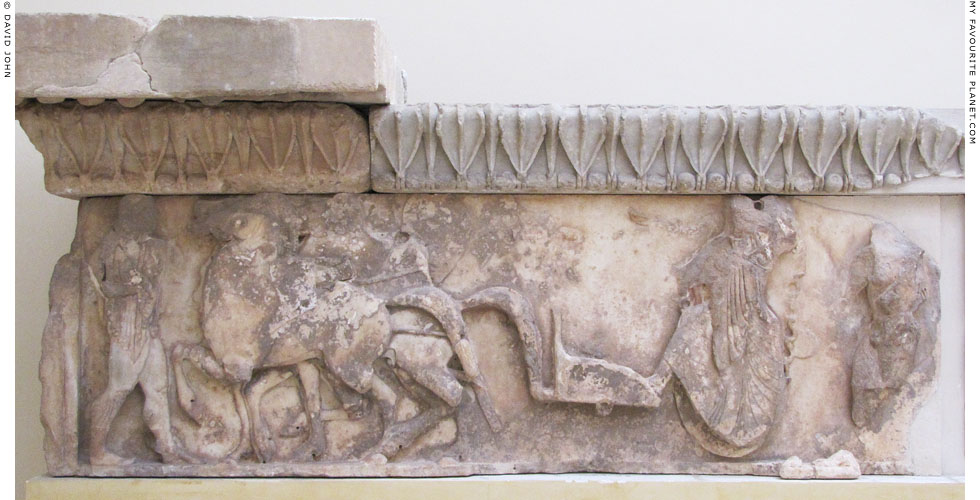
Hermes depicted on a fragmentary Archaic relief thought to show the
myth of the Judgement of Paris, from the Siphnian Treasury, Delphi.
Fragmentary slab of the left (north) end of the west frieze of the Ionic treasury,
built for the people of Siphnos around 525 BC (before 524 BC). Parian marble.
The sculptor of the south and west friezes, referred to as "Master A",
is thought to have been from Ionia (see the Aristion of Paros page).
Hermes stands on the left, wearing a chiton and holding his kerykeion in his right hand.
On the right, a headless female figure, thought to be Athena, appears to be mounting her
chariot. The next slab shows another female figure, perhaps Aphrodite, stepping off her
chariot, and the missing third slab possibly depicted the third contestant Hera and Paris.
Delphi Archaeological Museum, Greece. |
| |
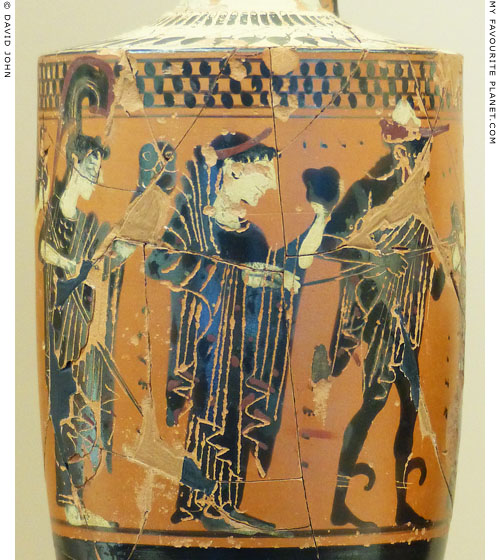
A depiction of the Judgement of Paris on the body of an inscribed Attic
black-figure lekythos. Hermes (right), holding his kerykeion horizontally,
leads Hera, holding an apple in her left hand, and Athena, wearing a
high-crested helmet and carrying an owl with her left hand. Around the
other side of the lekythos, not visible in the photo: to the right Paris
walking to the right; Aphrodite walking to the right behind Athena.
Around 500-490 BC. Attributed to the Diosphos Painter.
From a grave in the necropolis of Kerameikos, Athens.
Kerameikos Archaeological Museum, Athens. |
| |

The "Antikythera Youth", also known as the "Antikythera Ephebe"
(Έφηβος των Αντικυθήρων), a bronze statue of a god or hero.
Paris holding the Golden Apple of Discord in his raised right
hand, or Perseus holding the severed head of Medusa are
among the many suggested identifications.
Around 340-330 BC, late Classical period. Cast in separate parts,
it was probably made in a Peloponnesian workshop. Euphranor is
among those suggested as the sculptor. Found in 1900 by sponge
divers in the ancient Antikythera shipwreck (see Medusa part 1).
It has since been restored twice. Height 194 cm.
National Archaeological Museum, Athens. Inv. No. X 13396. |
| |
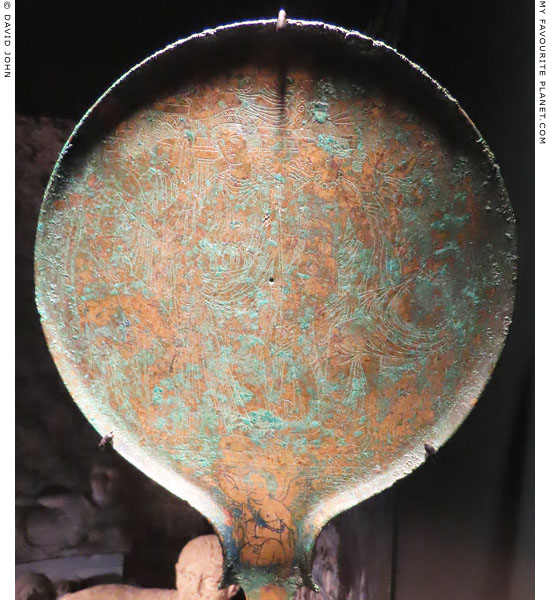
The Judgement of Paris engraved on an Etruscan bronze mirror (see details below).
Below the scene is a winged infant Eros.
Around 300 BC, Hellenistic period.
Allard Pierson Museum, Amsterdam. Inv. No. 1448. |
| |
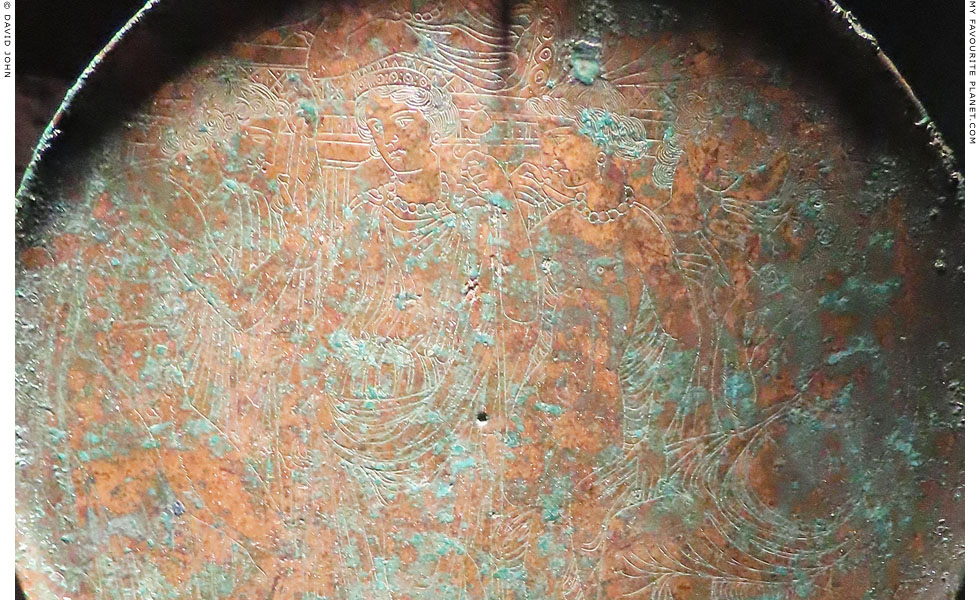
Detail of the Judgement of Paris on the Etruscan bronze mirror above. The engraved figures
are difficult to make out due to the mirror's partly corroded surface and the museum lighting.
|
In the centre the three goddesses stand in front of what appears to be a temple with Etruscan columns, above which lies or flies a female figure, mostly obscured by shadow. The two left-most goddesses face towards the nude male figure seated on the left, probably Hermes. He holds a staff, perhaps a kerykeion, and a himation is draped over his left shoulder.
Hera, the left-most goddess, wears a tiara, earrings, a necklace and a himation over a long chiton, girdled at the waist, and holds a sceptre in her left hand. Next to her, Aphrodite is naked apart from an earring and a necklace. She holds an edge of her discarded himation above her right shoulder with her right hand. Her lowered left hand appears to be touching the right thigh of the bearded male figure seated on the right, probably Paris.
Behind Aphrodite, Athena faces in the other direction, towards Paris. His lower torso and legs are covered by a himation, and with his left hand he strokes his chin, as if contemplating his decision. His right hand is raised with the index finger extended, perhaps about to point to the winning goddess. |
|
| |
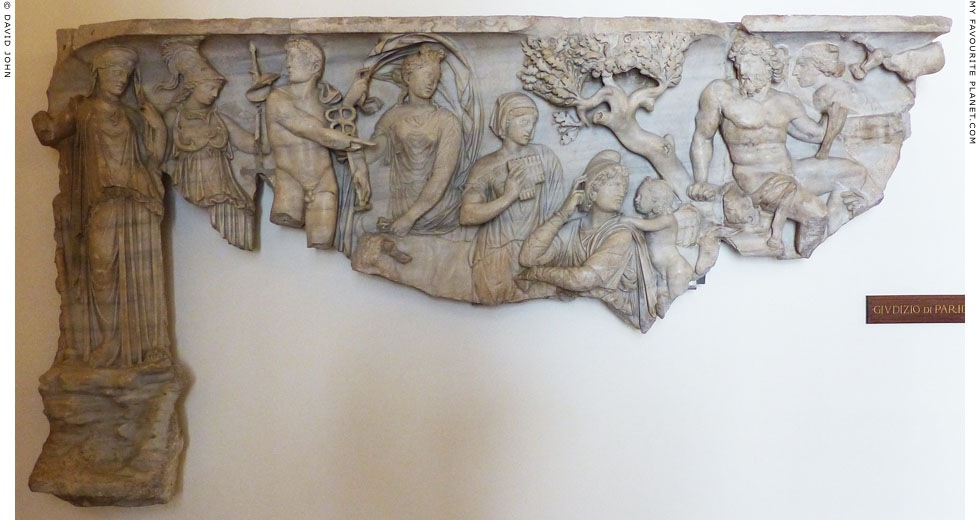
Fragment of a marble relief of the Judgement of Paris.
Roman Imperial period, 1st half of the 2nd century AD. Proconnesian marble.
Palazzo Altemps, National Museum of Rome, Rome. Inv. No. 8563. Boncompagni Ludovisi Collection.
|
The relief, believed to be part of a large sarcophagus, was extensively restored and altered in the 17th century by Alessandro Algardi, whose stucco additions were removed in 1901.
Hermes and deities on Mount Ida, participating in the judgement of the Trojan prince Paris, who has to choose whether Hera, Athena or Aphrodite is the most beautiful. Paris chooses Aphrodite due to the intercession of Eros (her son). She gives Helen to Paris as a reward, and his abduction of Helen leads to the Trojan War.
Left to right: Hera, Athena (wearing a helmet), Hermes (with caduceus), Aphdrodite, the shepherdess Oenone (Paris's companion on Mount Ida, holding a syrinx), Paris (wearing a Phrygian cap) with Eros, and the naked, bearded personification of Mount Ida sitting in a tree. |
|
| |
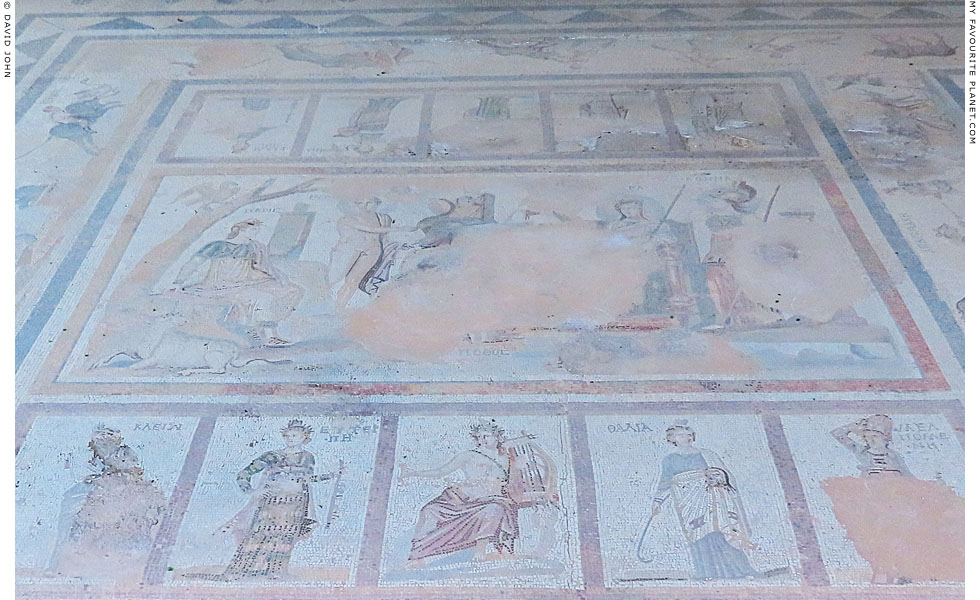
Detail of a large floor mosaic, with a central emblema (panel) depicting the Judgement of Paris.
Roman Imperial period.
In situ, Western Archaeological Site, Kos, Dodecanese, Greece.
|
The mosaic is badly damaged, with several parts of the images now missing. The panel showing the Judgement features (left to right) Paris, Hermes, Pothos, Aphrodite, Hera and Athena, with the name of each character written in Greek next to the respective head. The name of Aphrodite and the first two letters of Hera are now missing, as are most of the figures of Pothos and Aphrodite.
Paris, wearing a luxurious robe, sits beneath a tree, on a branch of which is perched an eagle, presumably representing Zeus. At the feet of the young herdsman sits a cow. Hermes stands naked, apart from a cloak draped over his left shoulder and arm. His head is turned towards Paris and with his right hand he gestures towards the goddesses, who sit on thrones arranged in a row. Hera and Athena are portrayed in the manner familiar from classical statues.
Above and below this scene are ten smaller mosaic emblemata (panels), each containing a depiction of one of the nine Muses, all named, and Apollo holding a lyre (or kithara) and a plectrum. Together all eleven emblemata make up one of three mosaic sections of the same size. Around and between these sections are friezes of gladiatorial scenes, featuring men, with or without armour, and wild animals. All these figures are also named.
One of many mosaics discovered in the main town of Kos by Italian archaeologists, following the devastating earthquake of 1933 (see statue of Hemes from Kos above and Medusa part 8). Several were taken to Rhodes to decorate the floors of the newly restored Palace of the Grand Master. |
|
| |
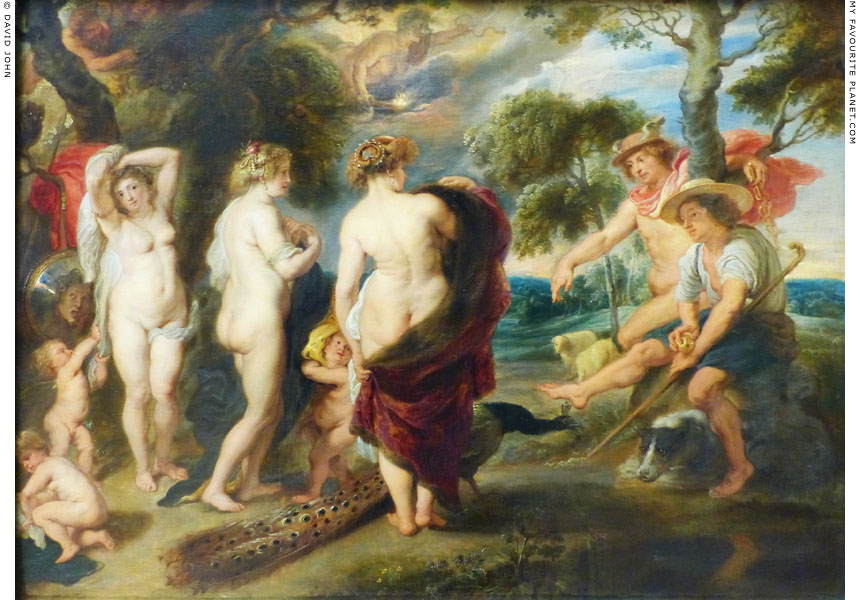
The Judgement of Paris by the studio of Peter Paul Rubens (1577-1640).
Oil on oak panel, circa 1635. Height 49 cm, width 63 cm.
Old Masters Gallery (Gemäldegalerie Alte Meister), Semperbau, Dresden.
Inv. No. 962 B. From the private collection of Heinrich Graf von Brühl.
First recorded in the inventory of the royal collection in Dresden in 1809.
|
See ancient depictions of the myth of the Judgement of Paris above.
This may be either a copy or an earlier version of the larger Judgement of Paris painted by Rubens between 1632 and 1635, now in the National Gallery, London. Inv. No. NG 194. Oil on oak panel. Height 144.8, width 193.7 cm. The compositions of the two paintings are almost identical, but they vary in several details.
Mercury, wearing a winged cap and red cloak and holding a caduceus, rests against a tree behind Paris, who is dressed like a simple herdsman (see Homer part 2), with a sun hat and crook, and accompanied by a dog and two sheep. He is seated on a rock and holds in his right hand the Golden Apple from the Garden of the Hesperides, meant as a prize for the goddess he judges to be the most beautiful. The two males admire the three goddesses, who have disrobed for the beauty competition. The divine contestants are attended by three cupids or putti.
On the left, Minerva (Athena) can be identified by her owl in the tree (far left), the spear and the shield decorated with the head of Medusa. In the centre stands Venus (Aphrodite), without any identifying attributes apart from her beauty. In ancient depictions of the scene, she is the only goddess who is sometimes shown naked. On the right Juno (Hera) stands next to her peacock.
The sketchy naked male figures in the tree at the top left of the picture are more detailed in the London version, in which three grinning satyrs can be seen enjoying the show from their hidden vantage point. The London painting shows the right-most satyr with his finger to his lips, trying to keep the other two voyeurs quiet.
In the clouds above, the flying female figure with a torch and a serpent has long been thought to represent Eris (Ἔρις, Discord, Strife; Roman equivalent, Discordia), the goddess of Discord who offered the Golden Apple (the Golden Apple of Discord, μῆλον τῆς Ἔριδος) as the prize at the wedding of Peleus and Thetis. However, it has been suggested that the figure is Alecto (Ἀληκτώ, Alekto, Implacable or Unceasing Anger), one of the Furies (Erinyes) who was associated with war. Although she is not mentioned in any of the versions of the Judgement of Paris story, the identification is based on the idea that she appears here as a portent of the Trojan War which was a consequence of Aphrodite bribing Paris with the promise of the love of the most beautiful woman in the world, who turned out to be Helena. The other reason is that Alecto features in other paintings by Rubens, such as Peace and War, and may have been included here as an allusion to the political turmoil of his own time. [16]
Renewed interest in the subject of the Judgement of Paris began in the Middle Ages, when a number of images were made in a variety of media. Several painters depicted the story, particularly Lucas Cranach the Elder (1472-1553), who painted as many as twenty two versions. At least eight versions are attributed to Rubens or his studio, the first painted early in his career, and the last was one of his final works. The other six are:
Probably between 1597 and 1599. Oil on canvas. Height 144.8 cm, width 193.7 cm.
National Gallery, London. Inv. No. NG 6379.
Around 1600-1605. Rubens or his studio. Oil on oak panel. Height 67 cm, width 78 cm.
Private collection.
Unknown date. Rubens' studio. Oil on oak panel. Height 48 cm, width 63 cm.
Private collection, Zurich.
Around 1606. Oil on copper plate. Height 32.5 cm, width 43.5 cm.
Gemäldegalerie der Akademie der bildenden Künste, Vienna. Inv. No. 644.
Around 1606-1608. Oil on panel. Height 89 cm, width 114.5 cm.
Museo Del Prado, Madrid. Inv. No. P001731.
Around 1638-1639. Oil on panel. Height 199cm, width 381 cm.
Museo Del Prado, Madrid. Inv. No. P001669. |
|
| |
| Hermes |
Hermes / Mercury and commerce |
|
 |
|
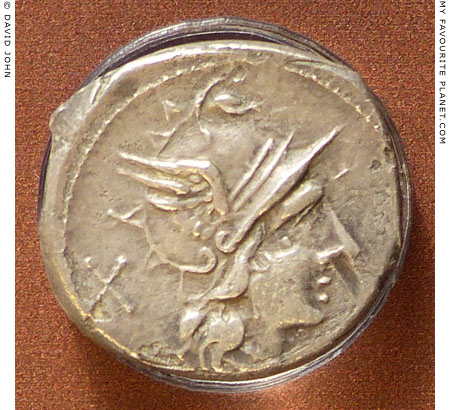
The head of Mercury wearing a winged helmet on a
denarius of the Roman Republic. Rome mint, 122 BC.
Thebes Archaeological Museum, Greece. |
|
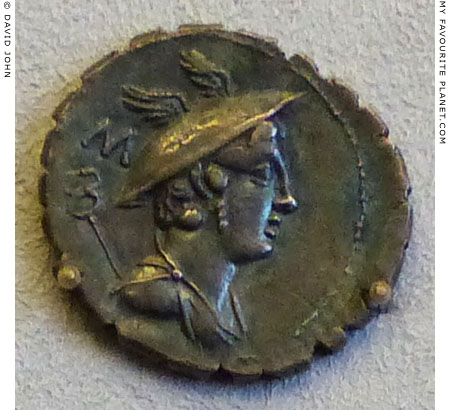
A Roman silver denarius serratus (i.e. with a serrated edge)
issued in Rome by the magistrate C. (Gaius) Mamilius Limetanus,
showing a bust of Mercury, facing right, with a winged petasos
and caduceus, wearing a cloak, fastened at the right shoulder.
82 BC, Roman Republican period.
The reverse side shows Ulysses (Odysseus) standing right,
holding a staff and his extending hand to his dog Argos.
When Odysseus finally returned home to Ithaca, disguised
as a beggar, the aged dog recognized him and died of joy
at seeing his former master (see Homer part 3).
Numismatic Collection, Bode Museum, Berlin. |
|
| |
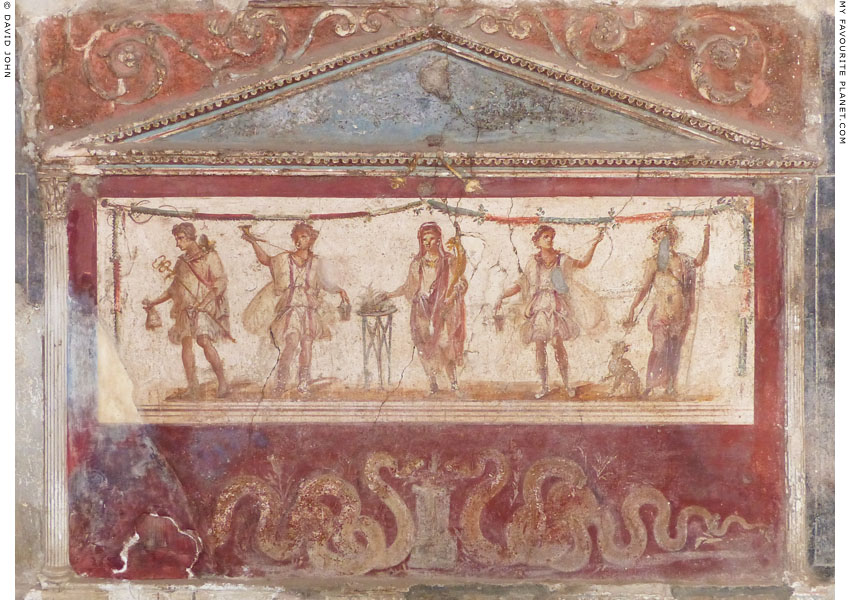
Fresco showing Mercury and Bacchus (Dionysus), protectors
of commerce and wine, on the wall of a tavern in Pompeii.
In situ in the Thermopolium Lucius Vetutius Placidus, Pompeii. |
| |
| |
The scene is set in a painted lararium (shrine) in the form of a temple with Corinthian columns, on a wall in the thermopolium. Mercury stands on the far left, and Bacchus (Dionysus) on the far right with his panther. In the centre the house gods and the Genius, holding a cornucopia, sacrifice at a tripod altar.
Below the figures are two agatodemone snakes, protective deities or spirits of prosperity and abundance, either side of an altar. |
|

Mercury with his caduceus and a purse. |
|
| |

Roman bronze balance for measuring liquids, with a counter-weight in the
form of a head of Mercury wearing a winged helmet. From Herculaneum.
National Archaeological Museum, Naples. |
| |

A Roman lead ingot stamped with a dolphin, the name of the merchant
Marcus Octavius and a caduceus, the symbol of the money god Mercury.
100 BC - 100 AD. One of a number of ingots from a shipwreck found in the
sea off Cape Passero, Sicily. The lead is thought to have been from mines
in Spain, which the Romans controlled following their defeat of Carthage.
Soprintenderiza per i Beni culturali e ambientali del Mare, Palermo, Sicily. Inv. No. 33.
Exhibited in the exhibition "Storms, war and shipwrecks:
Treasures from the Sicilian Seas", Ashmolean Museum, Oxford, 2016. |
| |
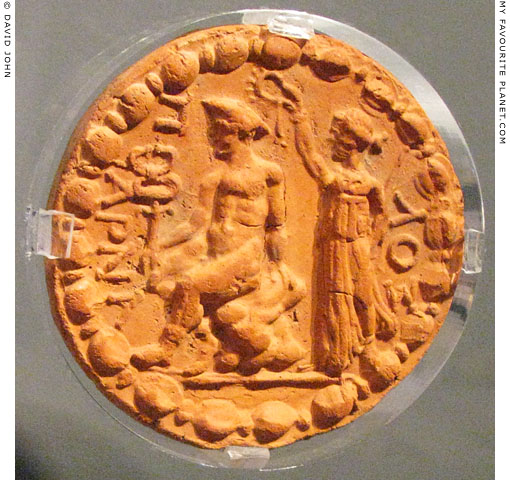
Ceramic disc depicting Nike crowning Hermes. 2nd century AD.
Nike, the greek goddess of victory, stands behind Hermes, holding a victor's wreath above
his head with her right hand. In her left hand she holds a palm branch. Hermes, naked apart
from a petasos sun hat and winged sandals, sits on what appears to be a rock, perhaps
covered by his cloak. In his right hand he holds his kerykeion (caduceus). The legend
ΠΑΡΝΑΣΟΥ (of Parnasos) may refer to the merchant who dedicated the disc to his patron god.
Thessaloniki Archaeological Museum. Inv. No. 5344 T. |
| |
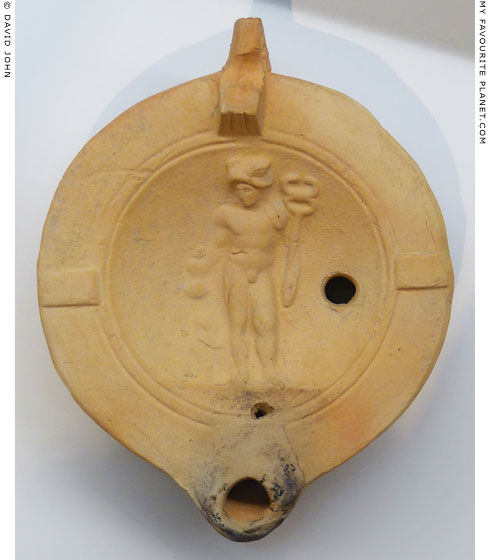
A terracotta oil lamp with a relief of naked Hermes wearing a winged cap,
holding a kerykeion in his left hand and a purse in his right hand. Part of
his cloak can be seen hanging from over his left shoulder.
2nd half of the 2nd century AD.
From Patras, northern Peloponnese, Greece.
Patras Archaeological Museum. |
|
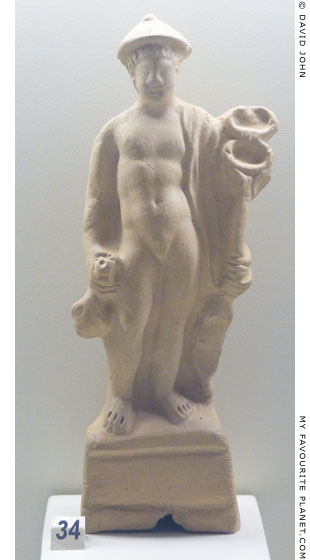
A terracotta figurine of Hermes Kerdoos,
the god of trade, wearing cap, holding
a kerykeion in his left hand and a purse
in his right hand. His cloak is draped
over his left shoulder and arm.
2nd century AD. From Patras.
Patras Archaeological Museum. |
|
| |
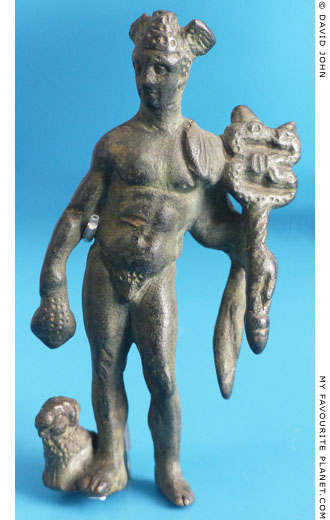
A small bronze statuette of Mercury with
winged cap, cloak, caduceus and a purse.
A small ram sits at his right foot.
Roman, 2nd century AD.
Museum für Kunst und Gewerbe Hamburg.
Inv. No. 1917.365. |
|

A small bronze statuette of Mercury.
1st - 3rd century AD.
Museo Civico, Castello Ursino,
Catania, Sicily. Inv. No. 3199. |
|
| |
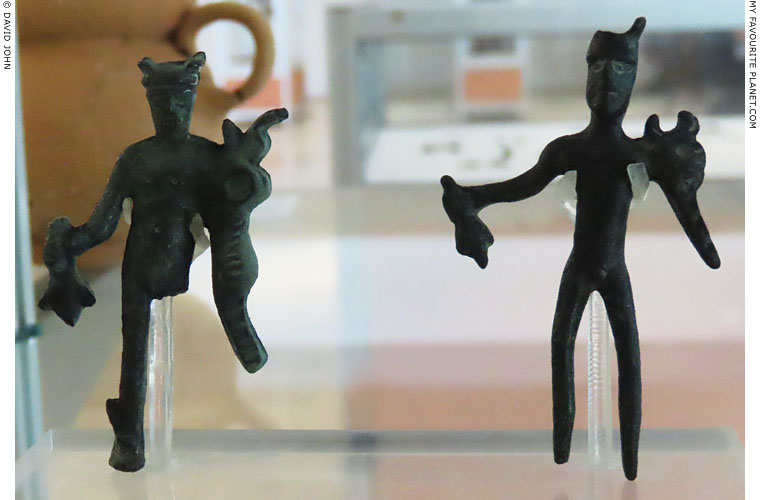
Two small bronze figurines of Hermes, each wearing a winged cap,
holding a kerykeion (caduceus) in his left hand and a purse in the right.
From the village of Dokos (Δοκός), location of ancient
Nymphaia (Νυμφαία), around 23 kilometres east of Komotini
(Κομοτηνή), Thrace, northeastern Greece. Roman period.
Komotini Archaeological Museum, Thrace. |
| |
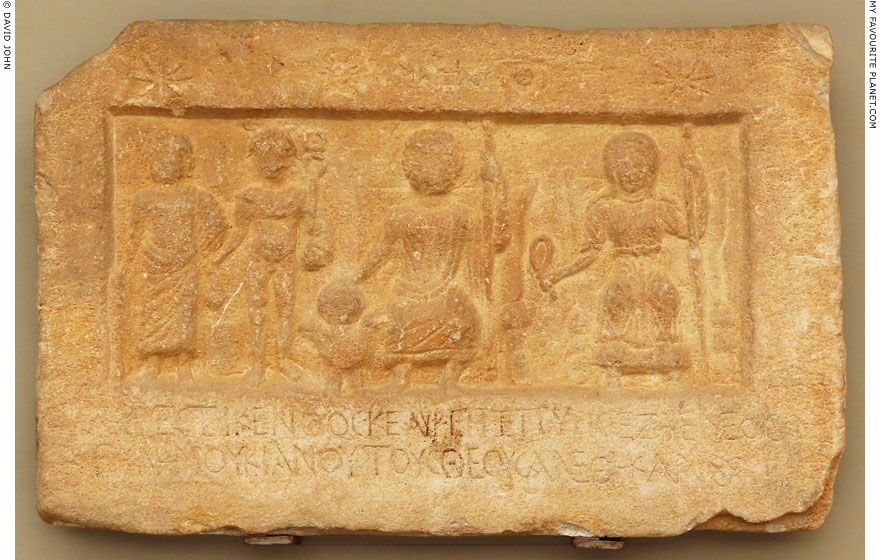
An inscribed marble votive relief, addressed to "Lord Plouton", with a
shallow relief depicting Hades and Persephone enthroned as rulers
of the Underworld, each holding a sceptre in the left hand. On the left,
in front of an altar, stand the healing god Asklepios, holding a staff
in his right hand, and Hermes Kerdoos (Κερδώος, profit-bringing) with
a kerykeion (caduceus) in his left hand and a purse in the right.
3rd century AD. Found around 1889 in the area of Nevrokopi (Νευροκόπι),
in the Rhodope Mountains. north of Drama, East Macedonia, Greece.
Height 53 cm, width 84 cm, depth 6.5 - 9 cm.
Drama Archaeological Museum. Inv. No. Λ 27.
|
This representation of Hades and Persephone resembles depictions of the Egyptian deities Serapis and Isis. Hades' face is no longer visible, but it is clear that his head is surrounded by a nimbus (halo). The faces of Asklepios and Hermes The faces of Asklepios and Hermes have also been worn away by time.
Along the top of the frame is inscribed the salutation "To Lord Plouton" in Greek. Immediately to the left of this address is a small bust of the Sun (Helios / Sol), and to the right a bust of the Moon (Selene / Luna). Two larger eight-pointed stars, one at each side, symbolize the Dioskouri, the heavenly twins.
The dedication in Greek at the lower part of the frame states that Aurelius Mestikenthos and Aurelia Gepepyris, daughter of Ezbenes and wife of Moukianos, dedicated these gods.
κυρίῳ Πλούτωνι
Αὐρ(ήλιος) Μεστικενθος κὲ Αὐρ(ηλία) Γηπεπυρις Εζβενεος
γυνὴ Μουκιανοῦ τοὺς θεοὺς ἀνέθηκαν.
Inscription IGBulg IV 2343.
The names of the dedicants are Thracian rather than Greek or Roman. The name Gepepyris (Γηπεπυρις) has also been read as Eptepyris (Επτεπυρις). IGBulg V 1997, 5927 = 2343.
The dedicants have chosen to appeal to the gods responsible for health (Asklepios), wealth (Hermes Kerdoos and Plouton) and life after death (Plouton/Hades and Persephone).
For further information about this relief, see Demeter and Persephone part 2. |
|
| |

Frescoes depicting Mercury flanked by cupids on the ceiling of the Loggia of Cupid and Psyche
in the Villa Farnesina, Trastevere, Rome. Designed and painted by Raphael and his workshop,
Giulio Romano and Giovan Francesco Penni, Giovanni da Udine and Raphaellino del Colle, in
1517-1518, the fresco panels in the loggia depict the "Fable of Cupid and Psyche" from the
novel The golden ass by Apulius (2nd century AD).
See also The Wedding of Alexander the Great and Roxana.
a fresco by Sodoma in the Villa Farnesina. |
| |
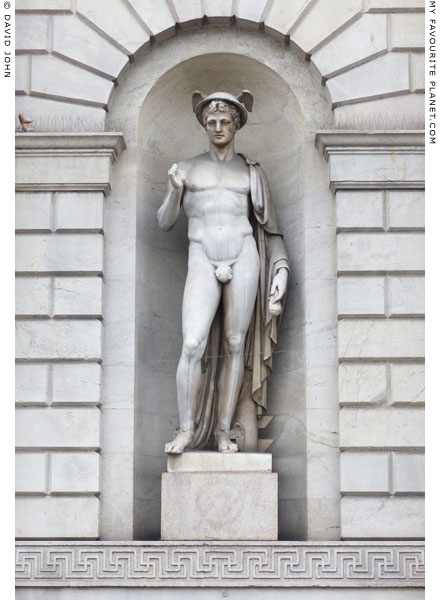
A modern statue of Mercury by Benedetto Cacciatori (1794-1871)
on the north side of the west tower of Porta Venezia, Milan.
|
The Porta Venezia stands on the site of an ancient gate of the Roman city Mediolanum (Milan). Rebuilt a number of times and known by various names, including Porta Orientale and Porta Renza, the present monumental neoclassical gateway is based on an initial design by Giuseppe Piermarini (1734-1808), whose work was continued after his death by his student Luigi Cagnola (1762-1833). Consisting of two massive sandstone towers on either side of the road, each with Doric porticos on three of the fours sides, it was completed 1827-1828.
The neoclassical reliefs depicting historical scenes and statues of Roman gods, sculpted by a number of Italian artists, were added in 1833. The statues on the west side: Mercury, Vulcan (Hephaistos), Abundantia (Abundance) and Justitia (Lady Justice). The statues on the east side: Minerva (Athena), Ceres (Demeter), Eternita (Eternity) and Fedelta (Fidelity).
The figure of Hermes/Mercury is based on Roman period statues depicting the god naked, apart from the fig leaf covering his genitals. He wears the winged basin-shaped sun hat or helmet, and a cloak is draped over his left shoulder and arm. His sandals are also winged. In his lowered left hand he holds a purse, and his raised right hand, now damaged, presumably held a caduceus. Like the other statues on the Porta Venezia, a sensitive, thoughtful and dignified work. |
|
| |
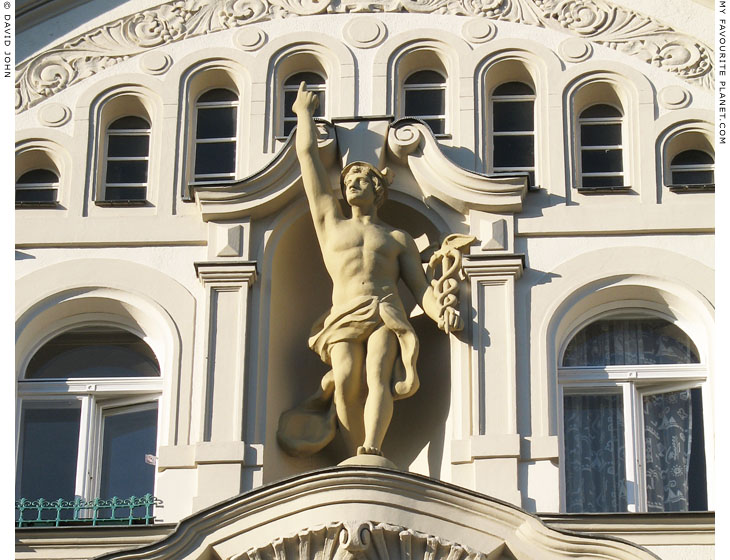
A modern statue of Hermes/Mercury on the facade of an early 20th century
house in the Luisenbad area of the Wedding district, Berlin, Germany.
|
| The Jugendstil (Art Nouveau) apartment and commercial house, Badstrasse 35-36, was built 1904-1905 by the carpenter, landowner and builder Carl Galuschki (1844-1910) and his architect brother Emil Galuschki. It featured shops on the ground floor, which perhaps explains the presence of Hermes as the god of merchants and commerce. Luisenbad, named after Queen Luise in 1799, had been famous since the early 18th century for its curative spring water, and was a popular leisure area on the edge of the city, among fields and windmills. The spring was destroyed during the construction of Galuschki's buildings on the site, and the water seeped into the sewers. It is a fine example of a building boom destroying the very qualities which made an area attractive in the first place. |
|
| |
| Hermes |
Notes, references and links |
 |
|
1. Hermes in Euripides' Ion
Euripides Ion, translated by George Theodoridis, 2006. At Poetry in translation.
2. Hermes as inventor of the alphabet (and wrestling)
"The Parcae, Clotho, Lachesis, and Atropos invented seven Greek letters - A B H T I Y.
Others say that Mercury invented them from the flight of cranes, which, when they fly, form letters.
Palamedes, too, son of Nauplius, invented eleven letters; Simonides, too, invented four letters – Ó E Z PH; Epicharmus of Sicily, two - P and PS.
The Greek letters Mercury is said to have brought to Egypt, and from Egypt Cadmus took them to Greece. Cadmus in exile from Arcadia, took them to Italy, and his mother Carmenta changed them to Latin to the number of 15.
Apollo on the lyre added the rest.
The same Mercury first taught wrestling to mortals."
Hyginus, Fabulae, sections 200-277, section 277, First inventions. At the Theoi Project.
For further information about Hyginus, see the note in Homer part 2.
3. "Youth holding a ram" from Boeotia
The painted terracotta statuette is similar to one in the Louvre, Paris, dated to circa 450 BC, and probably from the same workshop.
"Youth holding a ram". The surviving fragment of the figure from around the waist up. Height 18.3 cm, width 10.3 cm, depth 5.5 cm. Musée du Louvre. Inv. No. CA 626. Purchased in 1894.
4. "Cypro-Ionian" Kriophoros statuettes
See, for example:
Antoine Hermary and Joan R. Mertens, The Cesnola Collection of Cypriot art: Stone sculpture, Cat. Nos. 170 and 171, pages 149-150. The Metropolitan Museum of Art, New York, 2014. Online edition (PDF) at www.metmuseum.org.
5. Hermes Kriophoros statues in Corinth and Wilton house
For the Corinth statue, see: Corinth Object: S 686, Statue of Hermes Kriophoros, with photos and bibliography. At the website of the American School of Classical Studies.
Discussions of the Wilton Kriophoros are rare and photos even rarer. In the 19th century it was described as standing in the cloisters, and later in the stables.
See: Charles Thomas Newton, Notes on the Sculptures at Wilton House, No. 144, page 23. Private circulation. John Murray, London, 1849.
Newton's article on the sculpture collection in this stately home was first published in Dallaway's Anecdotes of the Arts in England, 1800. It was subsequently republished with some modifications in 1851, with the following description of the Kriophoros:
"It is sculptured in alto-relievo, on the face of a terminal block, and is naked in front, with drapery hanging down the sides. The hair, bound with a diadem, is arranged in a double row of clustered curls over the forehead, and hangs in a long tress on each side the neck. At the ankles are wings, which the later artist in copying the archaic original has not understood. The general type corresponds with that of Hermes or Mercury on the Capitoline altar and on archaic vases. The surface is in the finest condition, the head of the ram only being restored. This statue is engraved as Hermes Kriophoros, Clarac, Mus. de Sculpt. Pl. 658, No. 1545, B. Kennedy, who calls it Jupiter, says that it came from Thrace. Height, 3 feet 1/2 inch."
Charles Thomas Newton, Notes on the Sculptures at Wilton House. In: Memoirs illustrative of the history and antiquities of Wiltshire and the city of Salisbury, pages 248-278, particularly No. 144, pages 269-270. Royal Archaeological Institute of Great Britain and Ireland. George Bell, London, 1851. At the Internet Archive.
See also: Cornelius Vermeule and Dietrich von Bothmer, Notes on a new edition of Michaelis: Ancient marbles in Great Britain, part two. In: American Journal of Archaeology, Volume 60, No. 4 (October 1956), pages 321-350, particularly page 347 and plate 105, fig. 6. The University of Chicago Press, 1956. At jstor.
6. Terracotta Hermes in the Abdera museum
Abdera Archaeological Museum is one of Greece's excellent small museums and well worth visiting, especially if you want to understand something of the area's history. In line with the modern exhibition design concepts now adopted by many museums, exhibits in are grouped according to generalize themes (private life, public life, religion, state organization, children, clothing and hair styles, etc) rather than strictly chronologically. In some cases diverse artefacts from different periods are displayed together without individual labelling. This approach saves time, money, effort and space - the latter an important factor in smaller museums - and is deemed easier for the average visitor to comprehend the ancient world.
This statuette, for example, is displayed in a case among several other terracotta depictions of deities, with those of Hermes labelled as "Hermes and herms. 4th c. BC, Roman period." However, for those interested in discovering more specific information this makes things more difficult, particularly at places like Abdera about which it is not easy to find further accurate information to be found from other sources, either in print or online.
7. Hermes statue in Kos
See: Francesco Sirano, A seated statue of Hermes from Kos. Middle imperial sculpture between myth and cult: a new proposal of identification. In: Ian Jenkins and Geoffrey B. Wayrell (editors), Sculptors and sculpture of Caria and the Dodecanese, chapter 18. British Museum Press, London, 1997. At academia.edu.
There is a very short discussion on Hermes Eumelios on page 137. Unfortunately no bibliography is included with the article.
For further information about Italian archaeology on Kos, see Medusa part 8.
8. Head of Hermes on the lid of a ceramic vessel from Larino
The vessel was exhibited as part of the temporary exhibition The gift of Dionysos in the Thessaloniki Archaeological Museum, 13 July 2011 - 30 September 2012 (see the note on the Dionysus page). So far I have been unable to discover further details of the exhibits on loan from the Molise region of south-central Italy.
9. The Statue of Hermes with the infant Dionysus in Olympia
"The famously smooth and skilful 'Hermes of Praxiteles' in the Olympia museum. Its pedestal is Hellenistic or Roman, the legs except for the right foot are modern; the conception is that of Praxiteles working about 325 B.C., and the finish is glittering, but this is not the original statue; it is a fine Hellenistic copy. This sad but important truth is argued irrefutably by Sheila Adam in The technique of Greek sculpture (1966), pp. 124-8."
Peter Levi, in his translation of Pausanias, Guide to Greece, Volume 2: Southern Greece, note 164, page 248. Penguin Classics, 1979.
10. The marble puteal in the Vatican and the copy in Dresden
See:
Puteal. Hermes & infant Dionysus. At the website of the State Art Collection, Dresden (Staatliche Kunstsammlungen Dresden, SKD). Cited under bibliography: Sascha Kansteiner, Katalog der antiken Bildwerke V. Antikenimitationen aus Stein und Bronze, Best.-Kat. Staatliche Kunstsammlungen Dresden, Skulpturensammlung, München 2022, 224-228, Nr. 81, Abb. 81,1-81,5 (F. Sinn).
Puteal mit dionysischen Szenen, Musei Vaticani, Galleria dei Candelabri, Inv.-Nr. 2576. At arachne.dainst.org.
Georg Lippold, Die Skulpturen des Vaticanischen Museums, Band 3, 2 Text, "16 (134c). Puteal, Pflege des Dionysoskindes (Taf. 112. 113)", pages 240-244. Deutsches Archäologisches Institut. Walter de Gruyter, Berlin, 1956. At the Internet Archive.
11. The size and date of the Salpion krater
Various sources give the height of the krater as 99 cm, 127 cm or 130 cm. The dimensions above are taken from:
Museo nazionale di Napoli, Principal monuments in the National Museum of Naples, page 40 and plate 44. John Testa, Naples, 1882. At the Internet Archive.
The date of the late 2nd century BC is given, for example, in:
Jerome Jordan Pollitt, Art in the Hellenistic Age, page 173. Cambridge University Press, 1986.
A number of sources state 1st century BC, reflected in the Arachne database entry:
13741: Kelchkrater des Salpion
See also: Bianca Maiuri, Museo Nazionale di Napoli, page 36. Novara, 1957.
More recently several scholars have preferred the later date of the 1st century AD, or more generally the age of Augustus (27 BC - 14 AD). See, for example:
Brunilde Sismondo Ridgway, Hellenistic Sculpture: The styles of ca. 100-31 B.C., page 249. University of Wisconsin Press, 1990.
12. Argeiphontes and peacock eyes
"Then King Agamemnon rose, holding his scepter. This was the work of Hephaistos, who gave it to Zeus the son of Kronos. Zeus gave it to Hermes, slayer of Argos, guide and guardian. King Hermes gave it to Pelops, the mighty charioteer, and Pelops to Atreus, shepherd of his people. Atreus, when he died, left it to Thyestes, rich in flocks, and Thyestes in his turn left it to be borne by Agamemnon, that he might be lord of all Argos and of the isles."
Samuel Butler (translator), The Iliad of Homer, Book 2. Longmans, Green and Co., London, New York and Bombay. 1898 (?). At Perseus Digital Library.
The ancient Greek argos (ἀργός) literally means shining white or brilliant, and has a secondary metaphorical meaning of quick, agile.
The conventional translation of the epiphet Argeiphontes as "Argos Slayer" has been recently questioned. It has also been suggested that the eyes of Argos on the tails of peacocks is a later addition to the story, since it is thought that the oriental birds were unknown to the Greeks until the Hellenistic period. Writing in the 2nd century AD, Pausanias, described the Temple of Hera near Argos [see note 13] and mentioned that Emperor Hadrian dedicated a golden peacock decorated with jewels:
"Of the votive offerings the following are noteworthy. There is an altar upon which is wrought in relief the fabled marriage of Hebe and Heracles. This is of silver, but the peacock dedicated by the Emperor Hadrian is of gold and gleaming stones. He dedicated it because they hold the bird to be sacred to Hera."
Pausanias, Description of Greece, Book 2, chapter 17, section 6. At Perseus Digital Library.
13. The Argolid Sanctuary of Hera
The archaeological site of the Heraion of Argos (Ἡραῖον Ἄργους) is around 10 kilometres northeast of Argos and just south of Mycenae, off the road between Corinth and Argos. It was discovered in 1831 by the British army officer and historian Major-General Thomas Gordon (1788-1841), who excavated there briefly in 1836.
14. The etymology of argeiphontes
See, for example, the footnote line 38 to the ancient Greek version of Odyssey, Book 1. At Perseus Digital Library.
15. The Judgement of Paris gem in Athens
See: Gisela Marie Augusta Richter (1882-1972), The engraved gems of the Greeks, Etruscans and Romans. Part 2: Engraved gems of the Romans. A Supplement To The History Of Roman Art, page 63, No. 293, Carnelian intaglio. Phaidon Press, London, 1971. At the Internet Archive.
Richter's illustration of the gem shows Paris sitting on the right, facing the goddesses to the left. She describes him "holding the golden apple in his extended right hand". She also remarked: "Seemingly a parody on the familiar legend, for the goddesses are caricatured."
The illustrated volume contains descriptions of 783 gems of varying styles and subjects, from the 3rd century BC to the 4th century AD, that is from Roman Republican period to the late Imperial period. There is also discussion on some modern gems. The contents are organized according to the subjects depicted on the gems, for example deities, monsters, heroic legends, daily life, animals, plants and portraits. Interestingly, the author did not attempt to date most of the examples.
Richter's two volume guide to ancient Greek, Etruscan and Roman engraved gemstones remains an important contribution to this fascinating art. See also:
Gisela Marie Augusta Richter, The engraved gems of the Greeks, Etruscans and Romans. Part 1: Engraved gems of the Greeks and the Etruscans. A history of Greek art In miniature. Phaidon Press, London, 1968. At the Internet Archive.
16. Alecto in The Judgement of Paris by Rubens
The suggestion was first made by Gregory Martin in The Flemish School, c.1600 - c.1900, National Gallery Catalogue, London, 1970, pages 153-163, especially page 154, page 8.
See: Lois Oliver, Fiona Healy, Ashok Roy and Rachel Billinge, The evolution of Rubens's Judgement of Paris (NG 194) (PDF document). National Gallery Technical Bulletin, Volume 26, London 2005.
A number of publications state that Rubens' Judgement of Paris paintings were based on the versions of the story in Judgement of the Goddesses, from Dialogues of the Gods by Lucian of Samosata, and Ovid's, Heroides XVI, Paris to Helen, lines 64-93. Neither of these passages mention Alecto. Apart from the two National Gallery publications, others which state that Alecto appears in the London or Dresden paintings do not give reasons for this assumption. |
|
|
| |
| |
Photos on this page were taken during
visits to the following museums:
Bulgaria
Varna Archaeological Museum
Germany
Berlin, Altes Museum
Berlin, Bode Museum
Berlin, Pergamon Museum
Dresden, Albertinum, Skulpturensammlung
Dresden, Semperbau, Abguss-Sammlung
Dresden, Semperbau, Gemäldegalerie Alte Meister
Hamburg, Museum für Kunst und Gewerbe
Speyer, Historisches Museum der Pfalz
Greece
Abdera Archaeological Museum
Amphipolis Archaeological Museum
Athens, Acropolis Museum
Athens, Acropolis South Slope archaeological site
Athens, Agora Museum
Athens, Epigraphical Museum
Athens, Kerameikos Archaeological Museum
Athens, National Archaeological Museum
Athens, Numismatic Museum
Chalkis "Old" Archaeological Museum
Corinth Archaeological Museum
Delos Archaeological Site and Museum
Delphi Archaeological Museum
Drama Archaeological Museum
Komotini Archaeological Museum, Thrace
Kos Archaeological Museum
Kos, Casa Romana archaeological site
Kos, Western Archaeological Site
Olympia Archaeological Museum
Olympia, Museum of the History of the Ancient Olympic Games
Patras Archaeological Museum
Piraeus Archaeological Museum
Polygyros Archaeological Museum
Pyrgos Archaeological Museum
Rhodes Archaeological Museum
Rhodes, Palace of the Grand Master
Samothraki Archaeological Museum
Thasos Archaeological Museum
Thebes Archaeological Museum
Thessaloniki Archaeological Museum
Italy
Milan, Civic Archaeological Museum
Naples, National Archaeological Museum
Ostia Archaeological Museum
Paestum, National Archaeological Museum, Campania
Pompeii archaeological site
Rome, Barracco Museum
Rome, Capitoline Museums, Centrale Montemartini
Rome, Capitoline Museums, Palazzo dei Conservatori
Rome, Capitoline Museums, Palazzo Nuovo
Rome, National Etruscan Museum, Villa Giulia
Rome, National Museum of Rome, Baths of Diocletian
Rome, National Museum of Rome, Palazzo Altemps
Rome, National Museum of Rome, Palazzo Massimo alle Terme
Rome, Villa Farnesina, Trastevere
Italy - Sicily
Agrigento Regional Archaeological Museum
Catania, Museo Civico, Castello Ursino
Syracuse, Paolo Orsi Regional Archaeological Museum
Netherlands
Amsterdam, Allard Pierson Museum
Leiden, Rijksmuseum van Oudheden
Turkey
Bergama Archaeological Museum
Ephesus archaeological site
Istanbul Archaeological Museums
United Kingdom
London, British Museum
Oxford, Ashmolean Museum
Many thanks to the staff of these museums. |
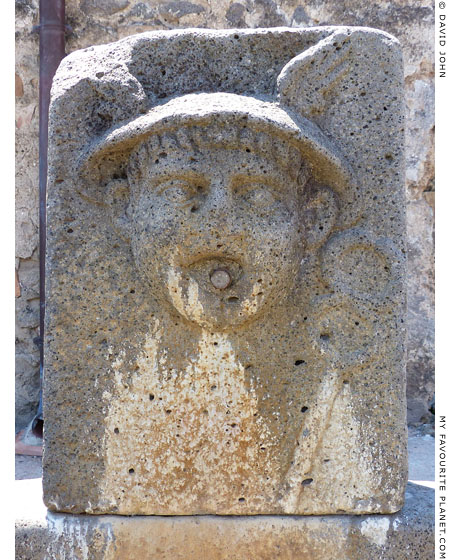
A relief of the head of Mercury with a winged helmet
and caduceus. From his open mouth protrudes a metal
water spout of a public fountain on a street of Pompeii. |
| |
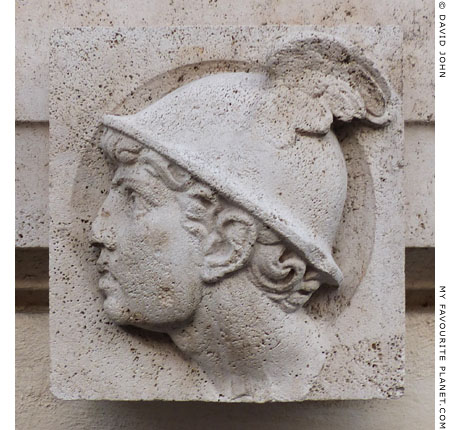
A relief of the head of Mercury wearing a winged helmet
on the travertine facade of a modern building in Rome. |
|
| Photos and articles © David John, except where otherwise specified. |
 |
Visit the My Favourite Planet Group on Facebook.
Join the group, write a message or comment,
post photos and videos, start a discussion... |
|
|
| |
| Copyright © 2003-2025 My Favourite Planet | contributors | impressum | contents | sitemap |
| |
